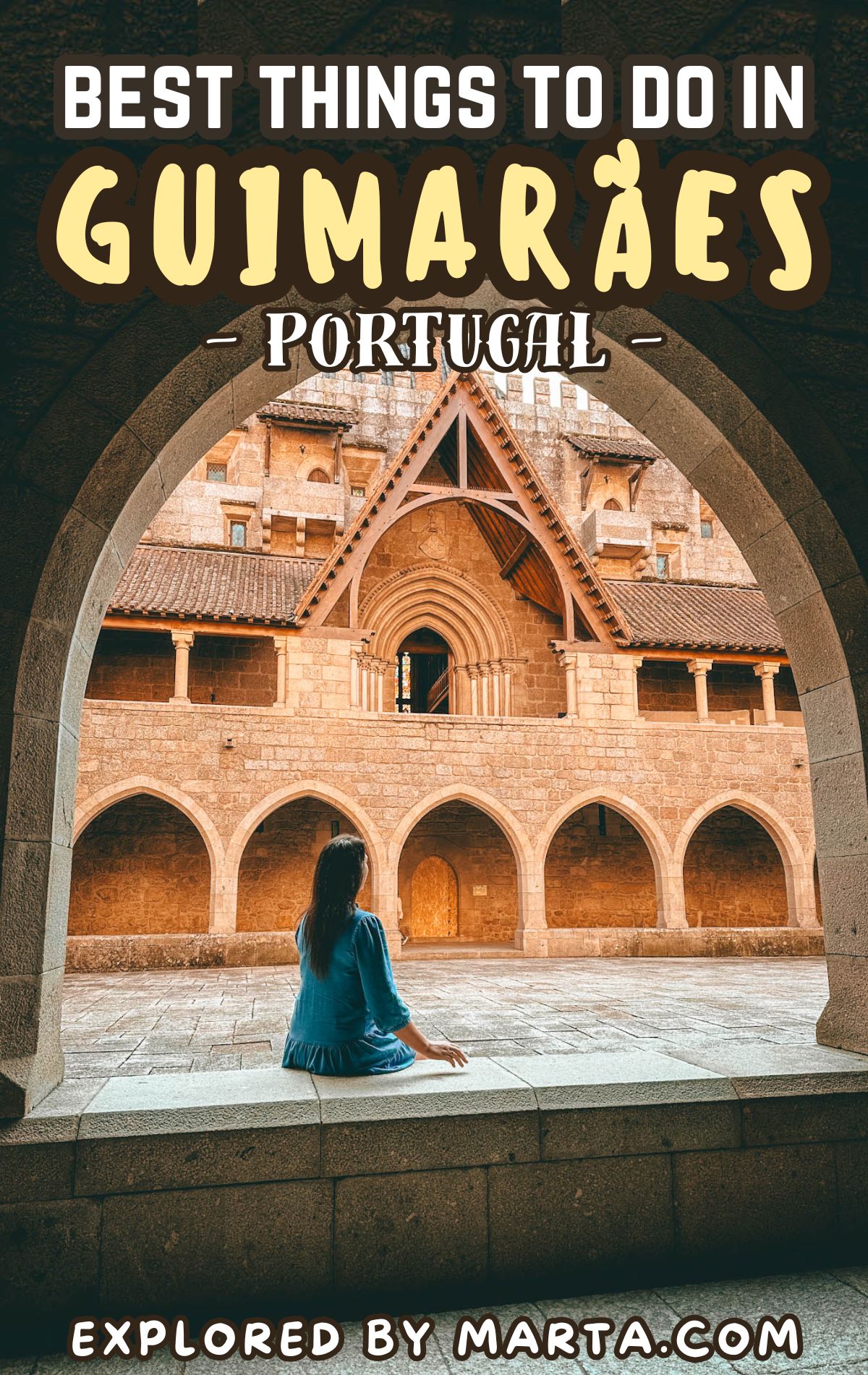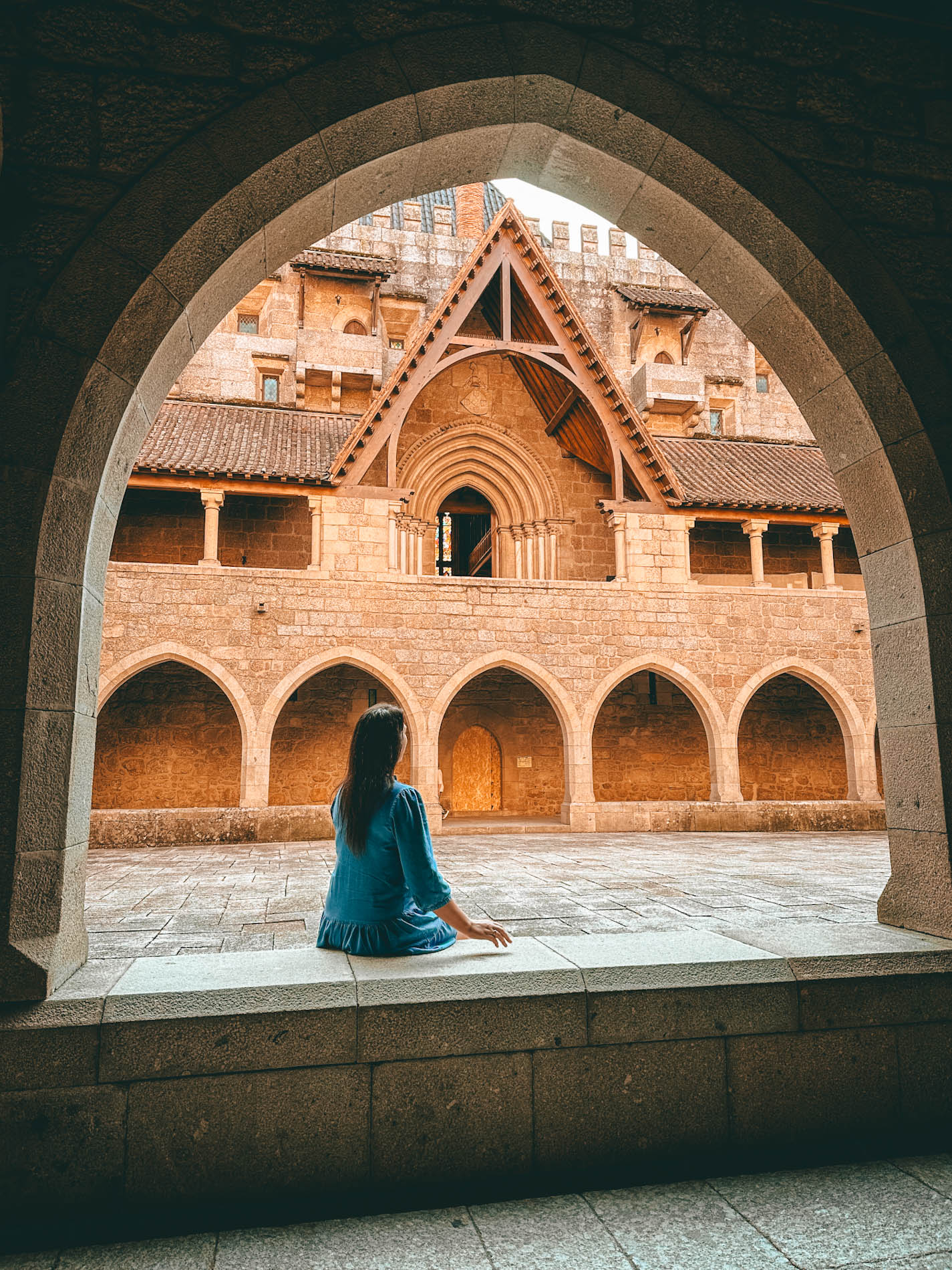Guide to Guimarães: 20 things to do in Guimarães, Portugal
This post may contain affiliate links. If you use these links to buy something I may earn a small commission at no extra cost to you! Thank you for your support!
Let’s explore the best things to do in Guimarães, Portugal – the birthplace of the Portuguese nation! With its well-preserved medieval old town, iconic castle, and timeless charm steeped in history, Guimarães is a must-visit city in Portugal!
We visited Guimarães as part of our road trip around Northern Portugal and actually stayed there for a whole week. We loved strolling the cobblestone streets, charming squares, and exploring the city’s powerful medieval past.
With the help of this blog post, you’ll be ready to discover all the top things to do in Guimarães. Here you’ll find all the places with descriptions, photos, tips, and exact locations. Get ready to explore the place where Portugal was born!
1. Stop for breakfast in Largo da Oliveira
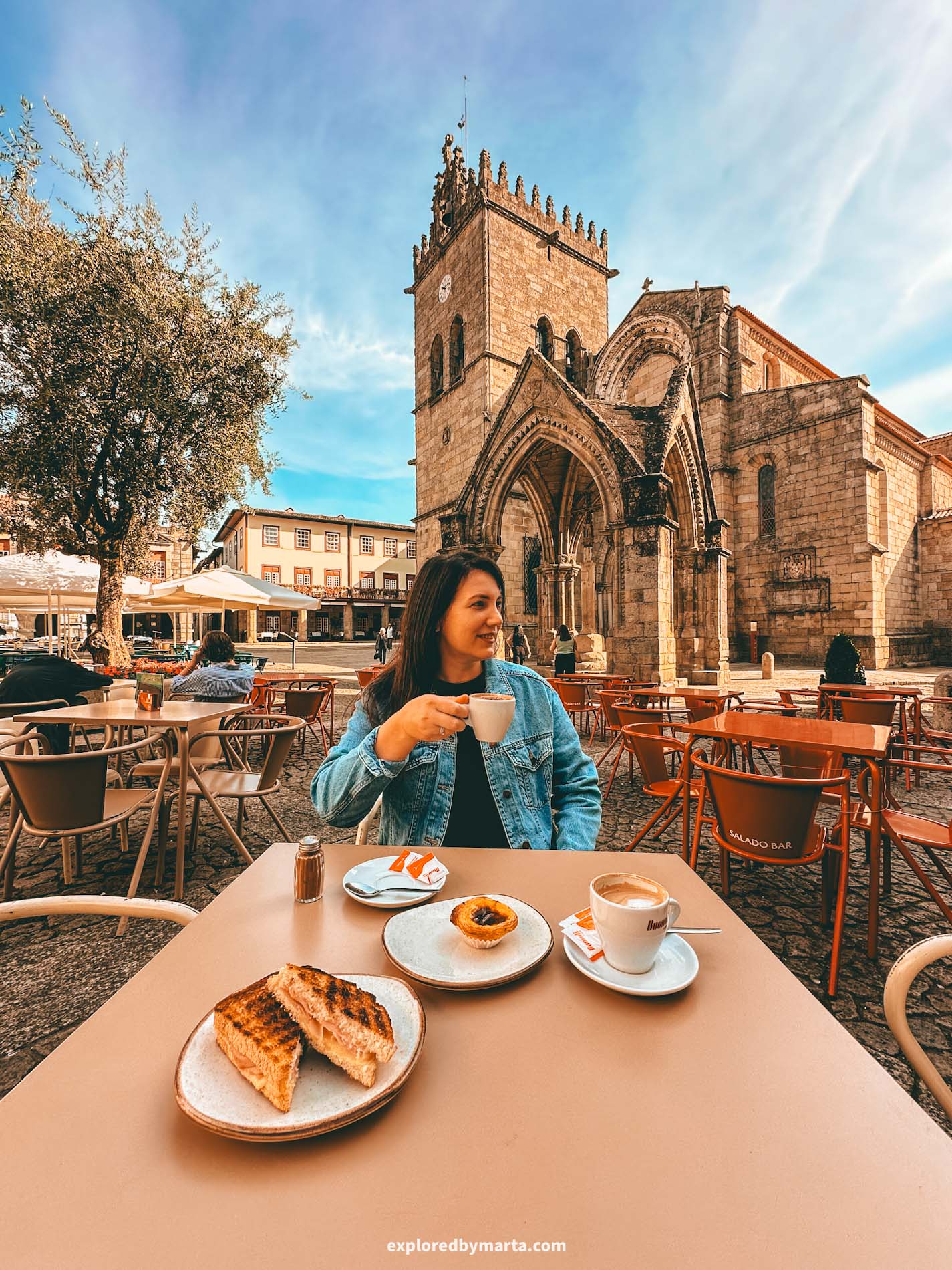
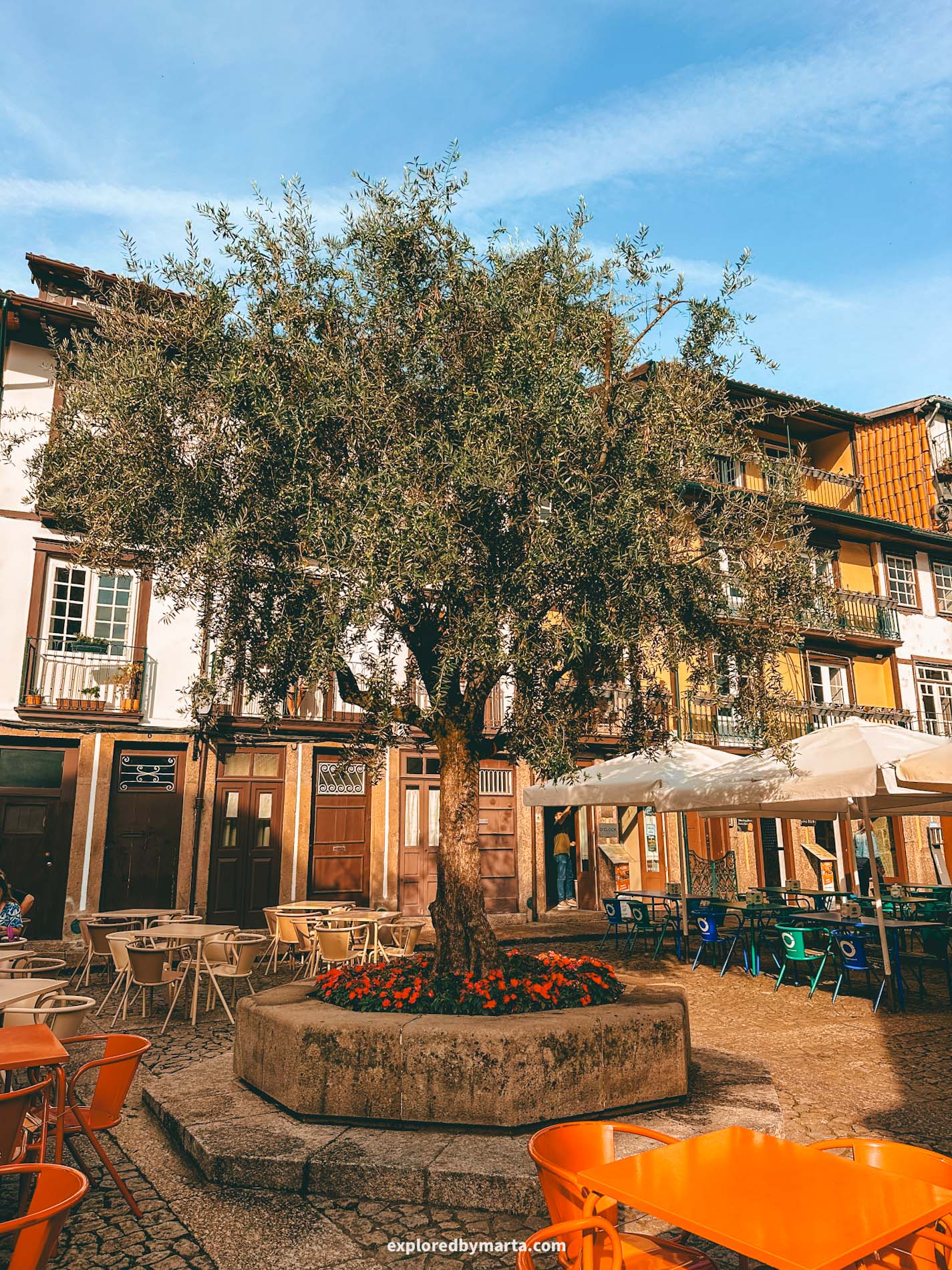
Largo da Oliveira square is the heart of Guimarães. This medieval square is named in honor of an ancient olive tree that, the legend says, miraculously came back to life after being blessed with holy oil.
Today, a new olive tree stands in the exact same spot – in front of the Igreja de Nossa Senhora da Oliveira, the main church in Guimarães.
During our week-long stay in Guimarães, we actually rented an apartment right at Largo da Oliveira, so this square was our backyard. I have to say that this was one of my favorite places in the town.
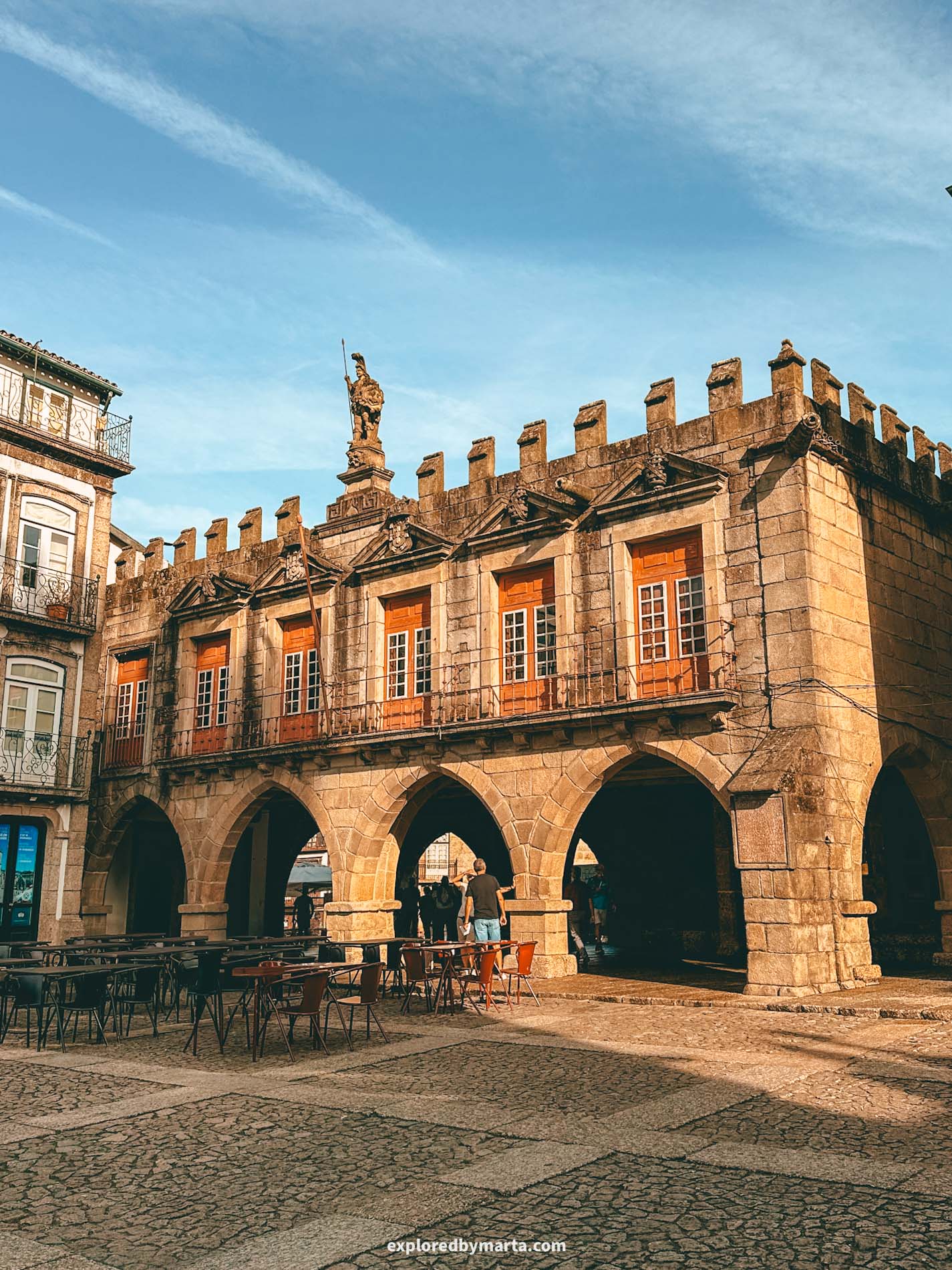
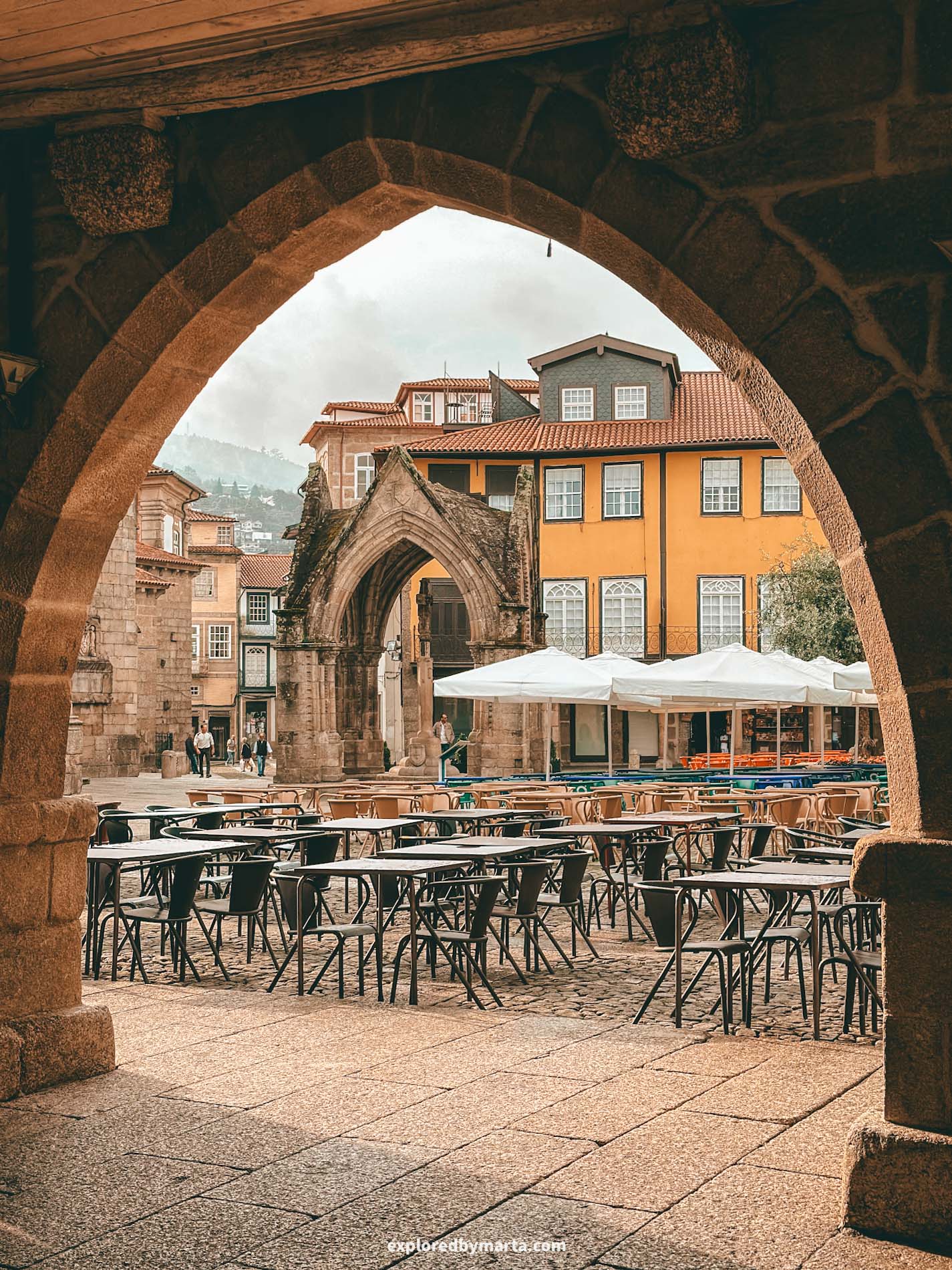
Surrounded by medieval buildings, charming cafés, and arcaded stone galleries, this square is where life happens in Guimarães.
From early morning coffees to late night cocktails, there is always life and busy chatter in Largo da Oliveira.
If you are arriving at Guimarães in the morning, I highly recommend stopping by this square for a quick cappuccino with pastel de nata. This is the perfect place to start your journey through this town.
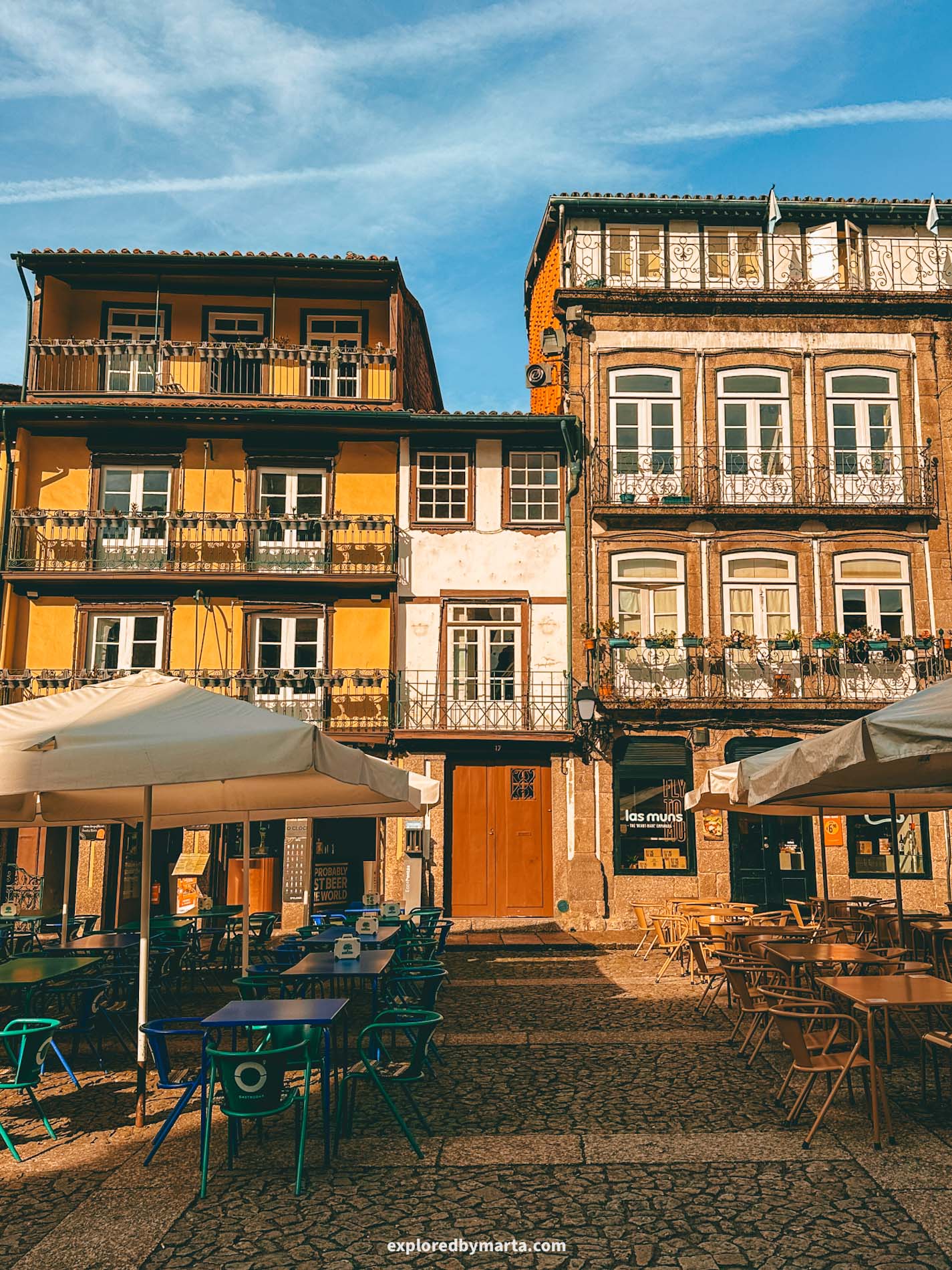
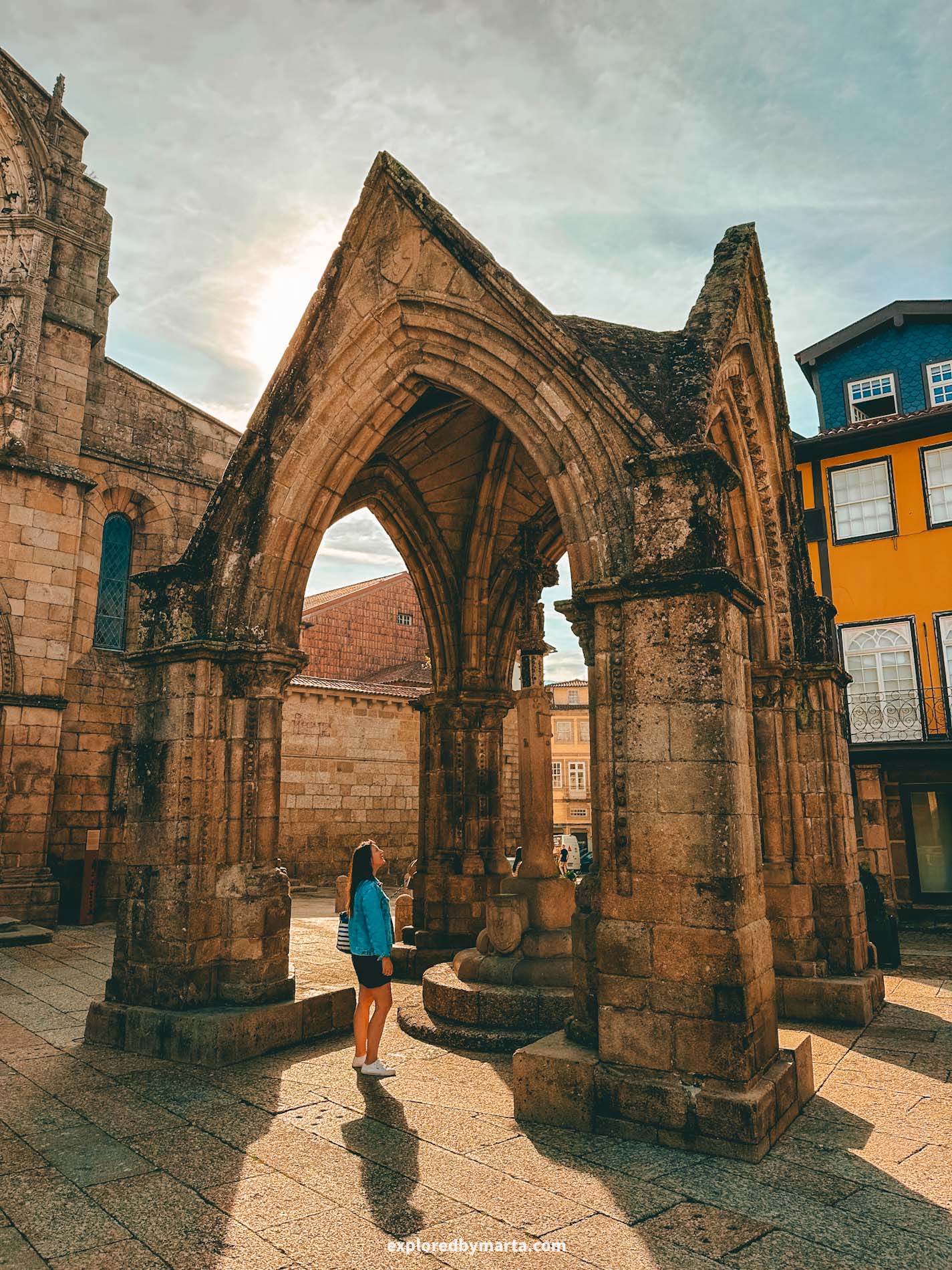
Largo da Oliveira also hosts Padrão do Salado, a beautiful Gothic monument built in the 14th century to mark the Portuguese victory in the Battle of Salado, fought between the Christian forces of Portugal and Spain and the Muslim armies from North Africa.
That’s one beautiful photo spot, if you are looking for one!
Sitting in the square, sipping a cappuccino, and soaking in the medieval charm was one of my favorite things to do in Guimarães. Locals sit in the square chatting all day long as tourists pass by throughout the day. It is very much the heartbeat of Guimarães!
Location: Largo da Oliveira
2. Try the local monastery-style sweets
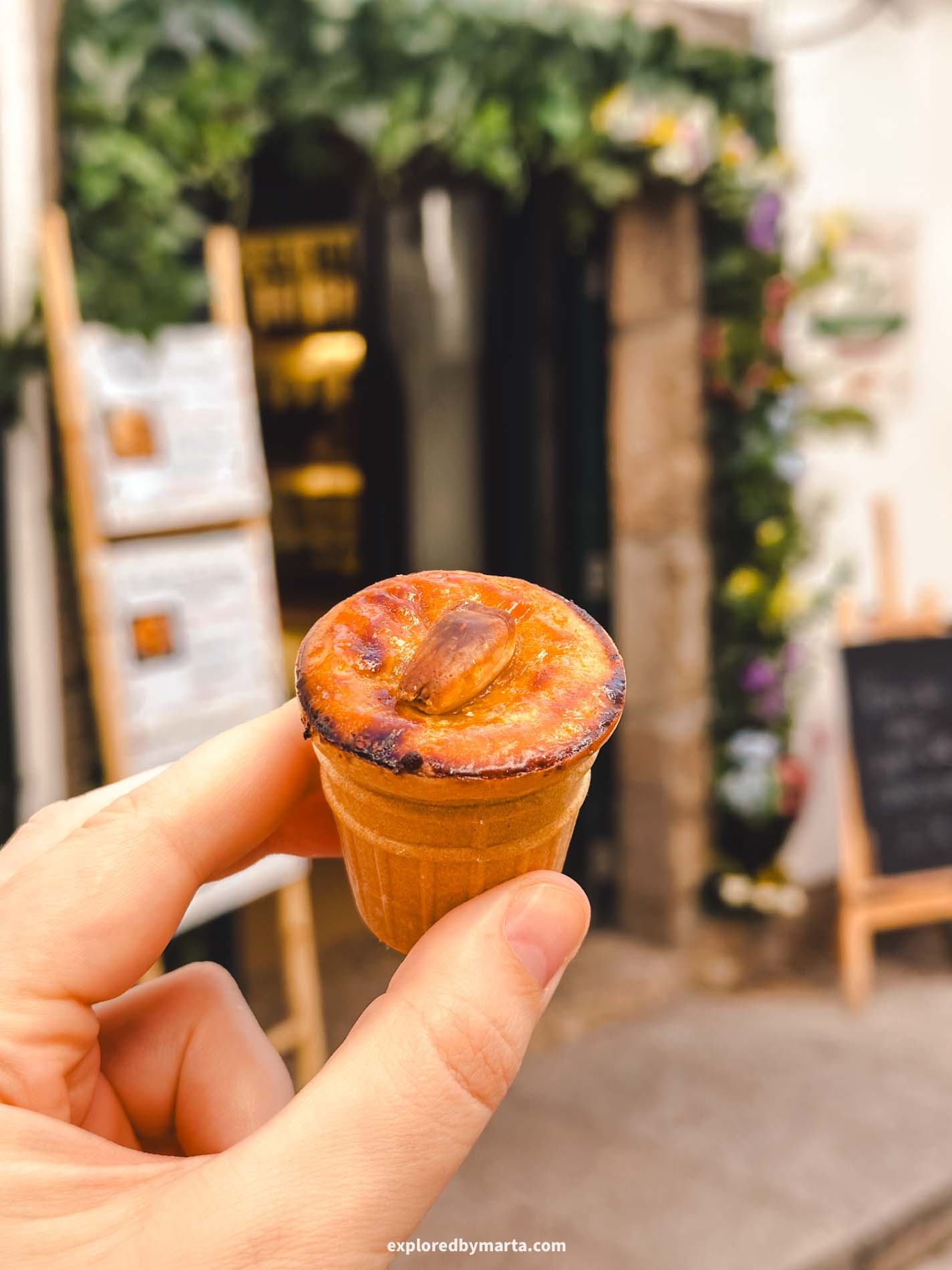
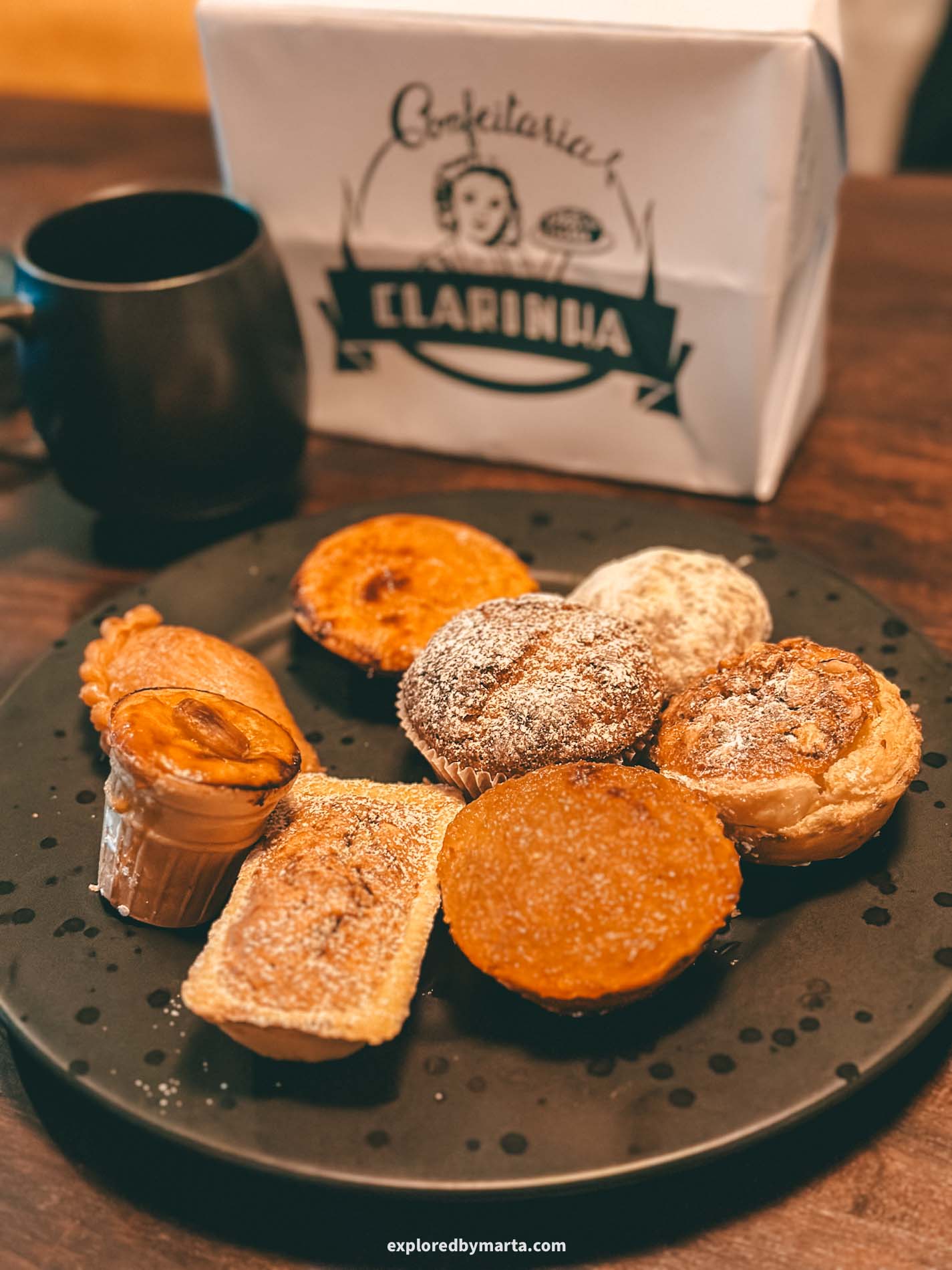
If you don’t have time to sit down for breakfast or you want to try something local (and maybe also bring some local flavors home after your visit), you have to try Guimarães’s traditional monastery-style pastries!
They are great with your morning coffee or as a snack during the day!
Monastery sweets, or doces conventuais, are an actual thing in Portugal. And you probably already know the most famous Portuguese pastry that was created in a monastery – pastel de nata!
Doces conventuais are pastries that originated in convents and monasteries, where nuns and monks used a lot of egg whites to starch clothes and were left with plenty of egg yolks.
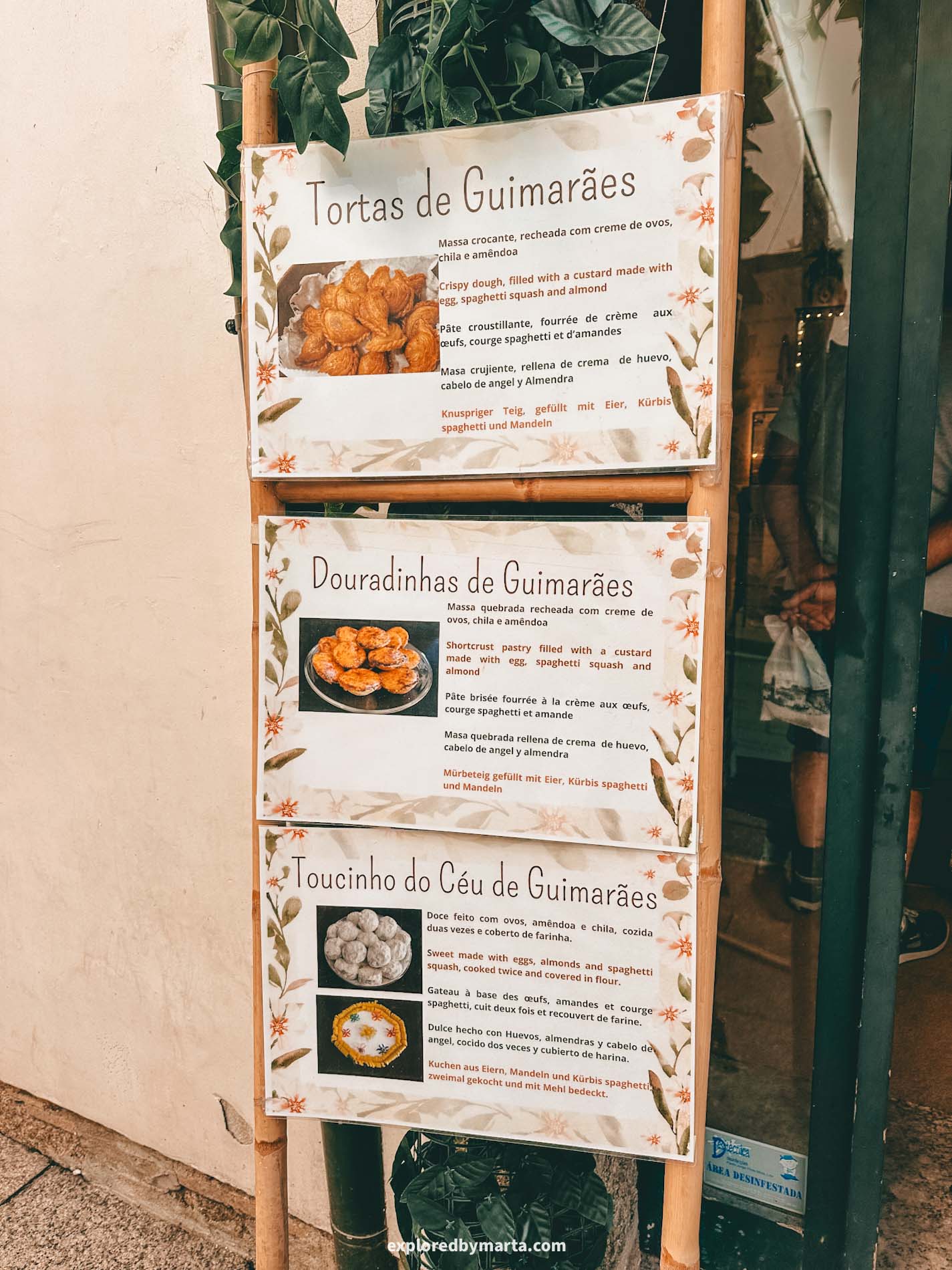

So, they came up with all kinds of rich desserts and pastries using egg yolks, sugar, and almonds. Guimarães has kept this tradition alive, so you definitely have to try some of their local specialties!
Where to get them? I recommend Casa Costinhas and Pastelaria Clarinha – two popular pastry shops in the center of Guimarães. These traditional bakeries have been serving monastery sweets for decades!
We stopped by Pastelaria Clarinha and tried local pastries like Tortas de Guimarães, Douradinhas de Guimarães, Rochas da Penha, Pastéis de Chila, Pastéis de Noz, and Amores.
I’m actually not into these kinds of sweets, but some of them were surprisingly good. If you have a sweet tooth, make sure to stop by one of the pastry shops in Guimarães to get a little taste of Portuguese history!
Location: Casa Costinhas – Pastelaria Clarinha
3. Stroll along Rua de Santa Maria
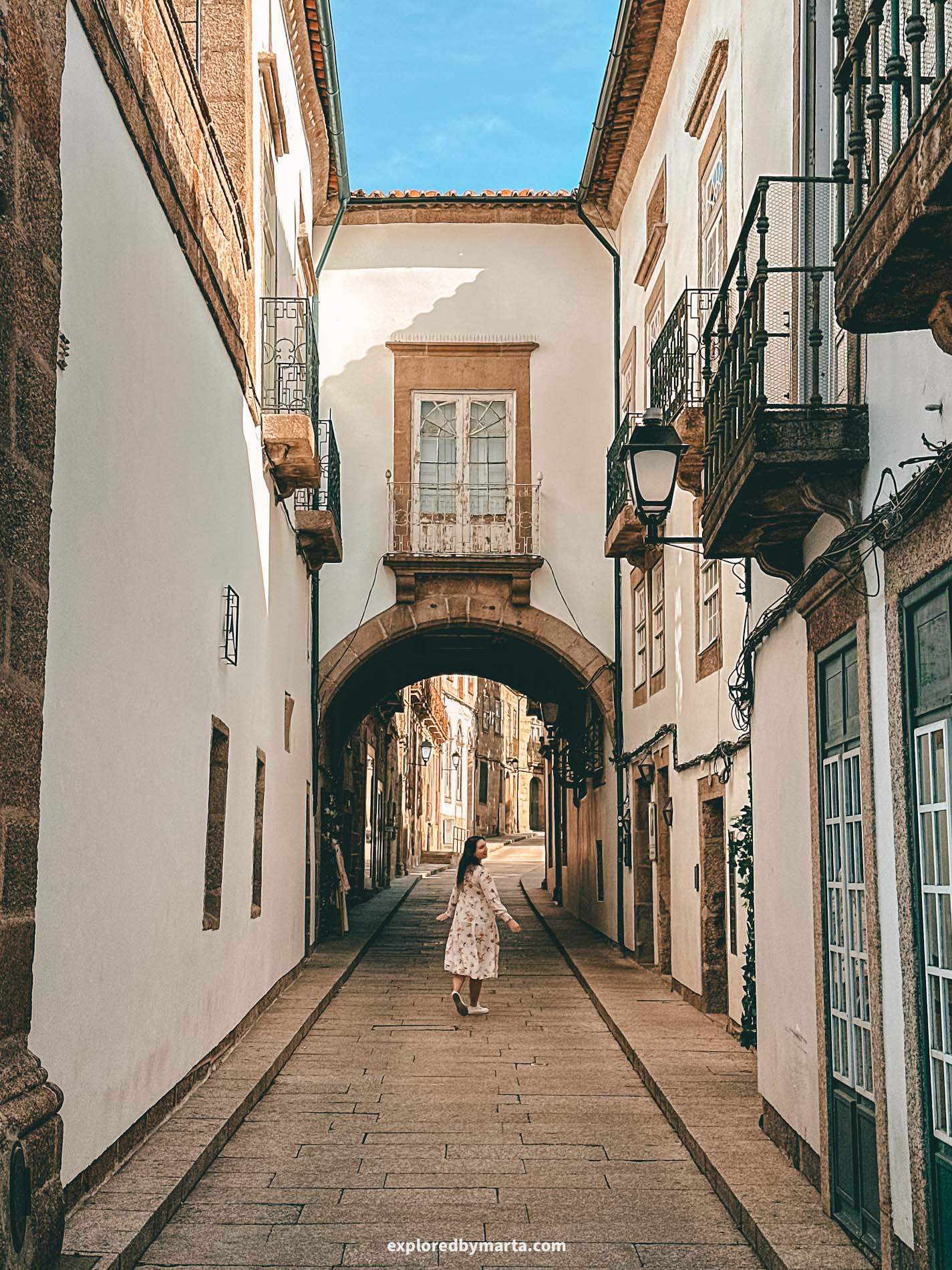
Now, let’s head to the most important tourist attractions in Guimarães – the Palace of the Dukes of Bragança and Guimarães Castle. These two are probably the reason you are visiting Guimarães!
The best way to get from the center of the old town to the palace is by Rua de Santa Maria, a charming cobblestone street leading from Largo da Oliveira square up to the Palace of the Dukes of Bragança.
Why this street? This charming medieval street is one of the oldest streets in town and dates back to the 12th century. And, more importantly, it was actually built for this reason – to connect the old town with the castle!
Centuries passed, and the street evolved with many noble families building their homes next to the street, along with chapels, convents, etc. Many of the buildings you see today still have their original stone facades, arched doorways, and traditional wooden balconies.
So, walking this street not only feels like stepping back in time, but it actually is the original way for people to get to the palace and the castle. It was for sure one of my favorite streets in Guimarães. And look at that archway over the street (photo above)!
Location: Rua de Santa Maria
4. Explore the majestic Palace of the Dukes of Bragança
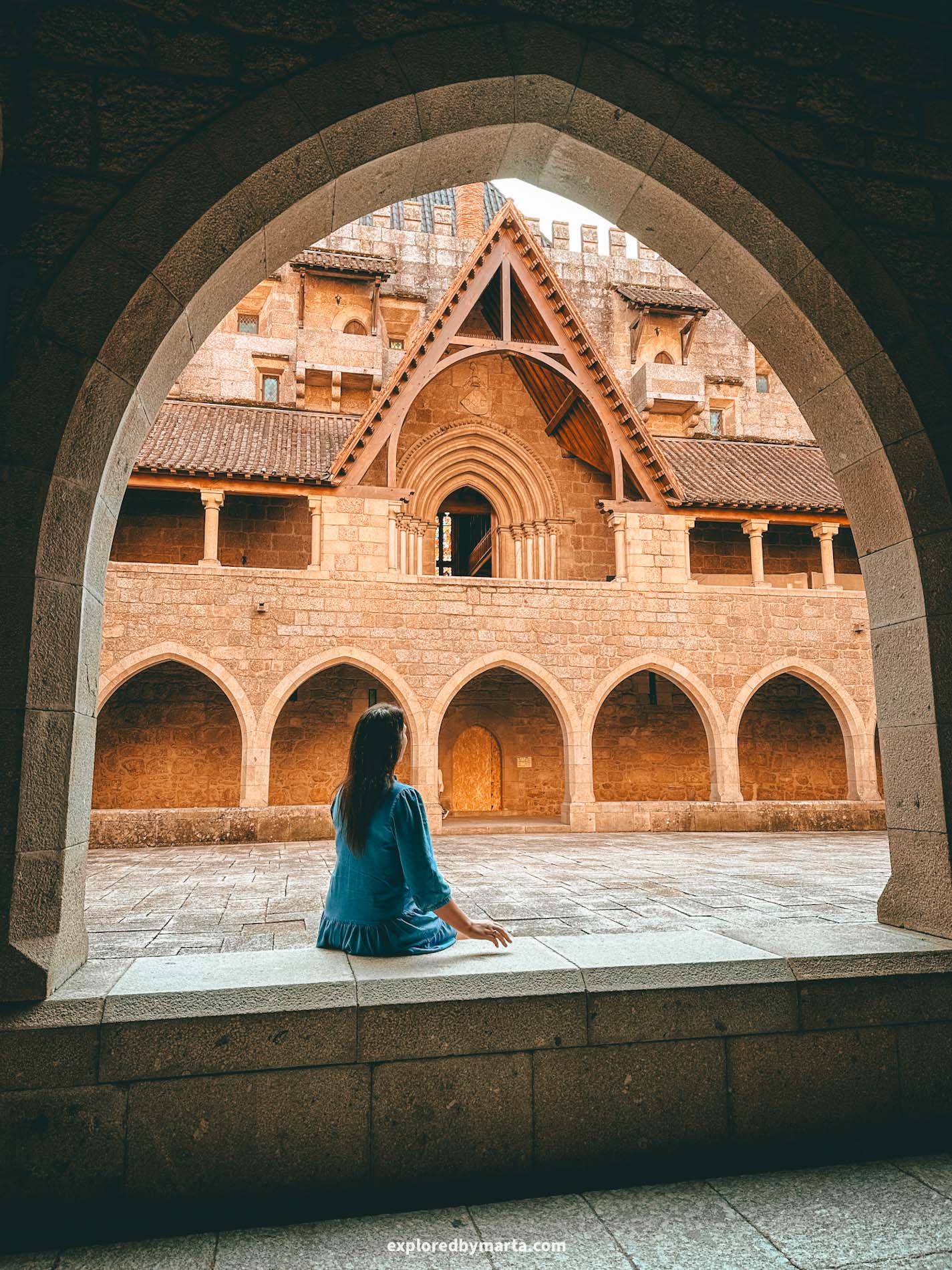
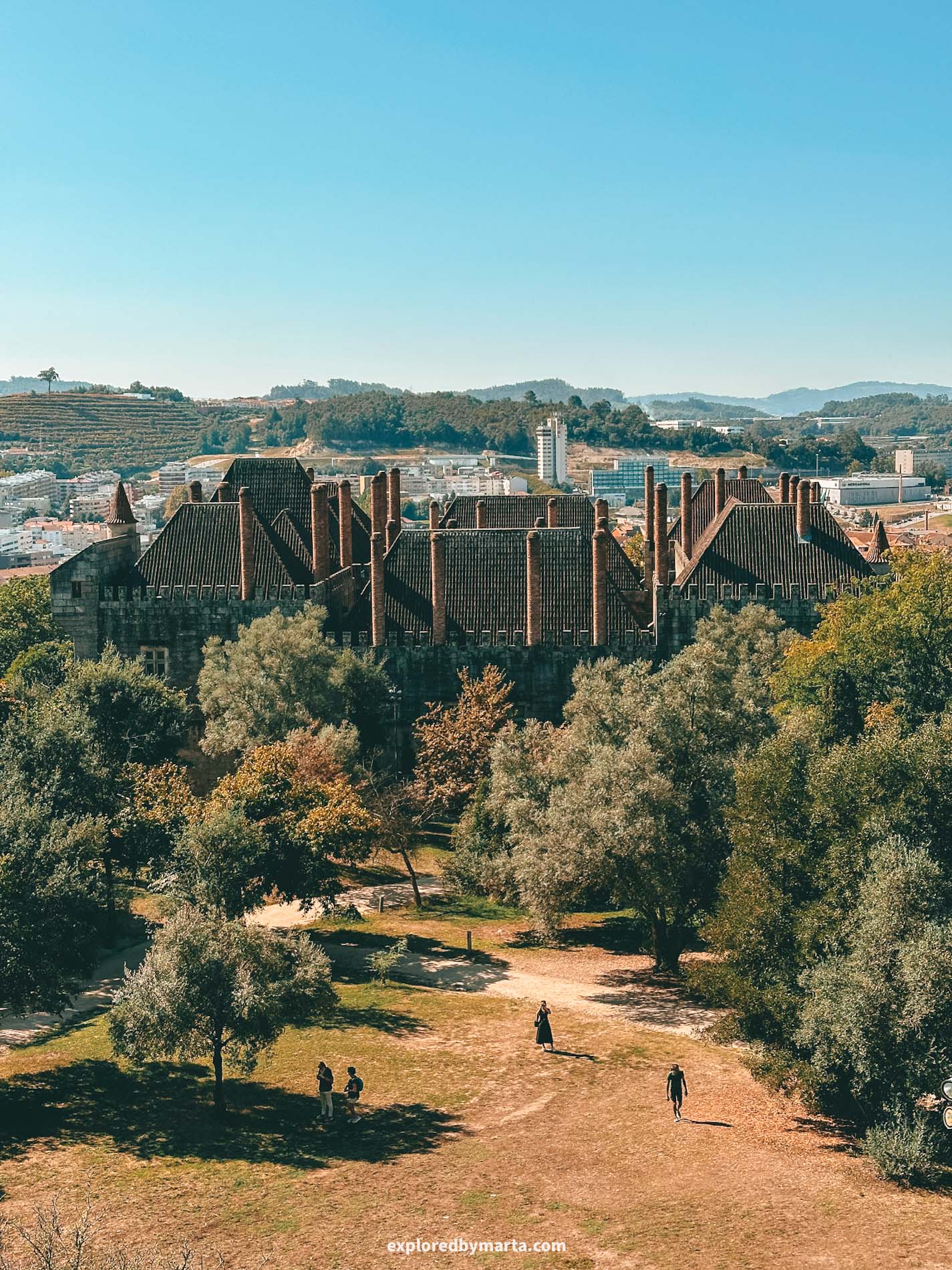
As you continue walking down the Rua de Santa Maria street, you will eventually reach one of the most famous attractions in Guimarães – the majestic Palace of the Dukes of Bragança.
This medieval stone mansion was built in the first half of the 15th century for Afonso, 1st Duke of Bragança (one of the king’s sons), and stands out with its sturdy architecture and very distinctive chimneys towering high above the city.
Tip! If you visit the Guimarães Castle afterward and climb up to the castle walls, you’ll see the palace from above with its countless iconic chimneys (see photo above!).
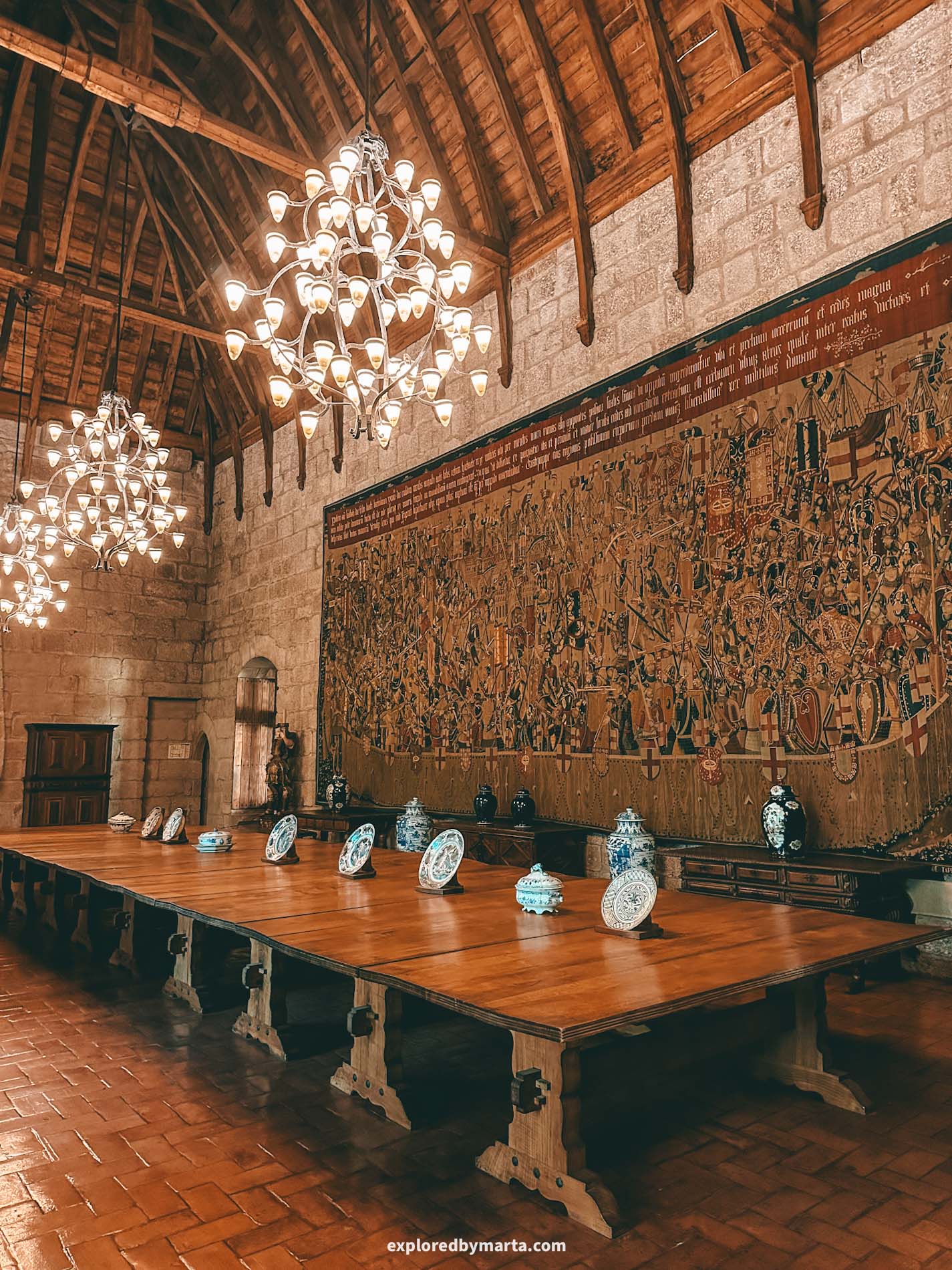
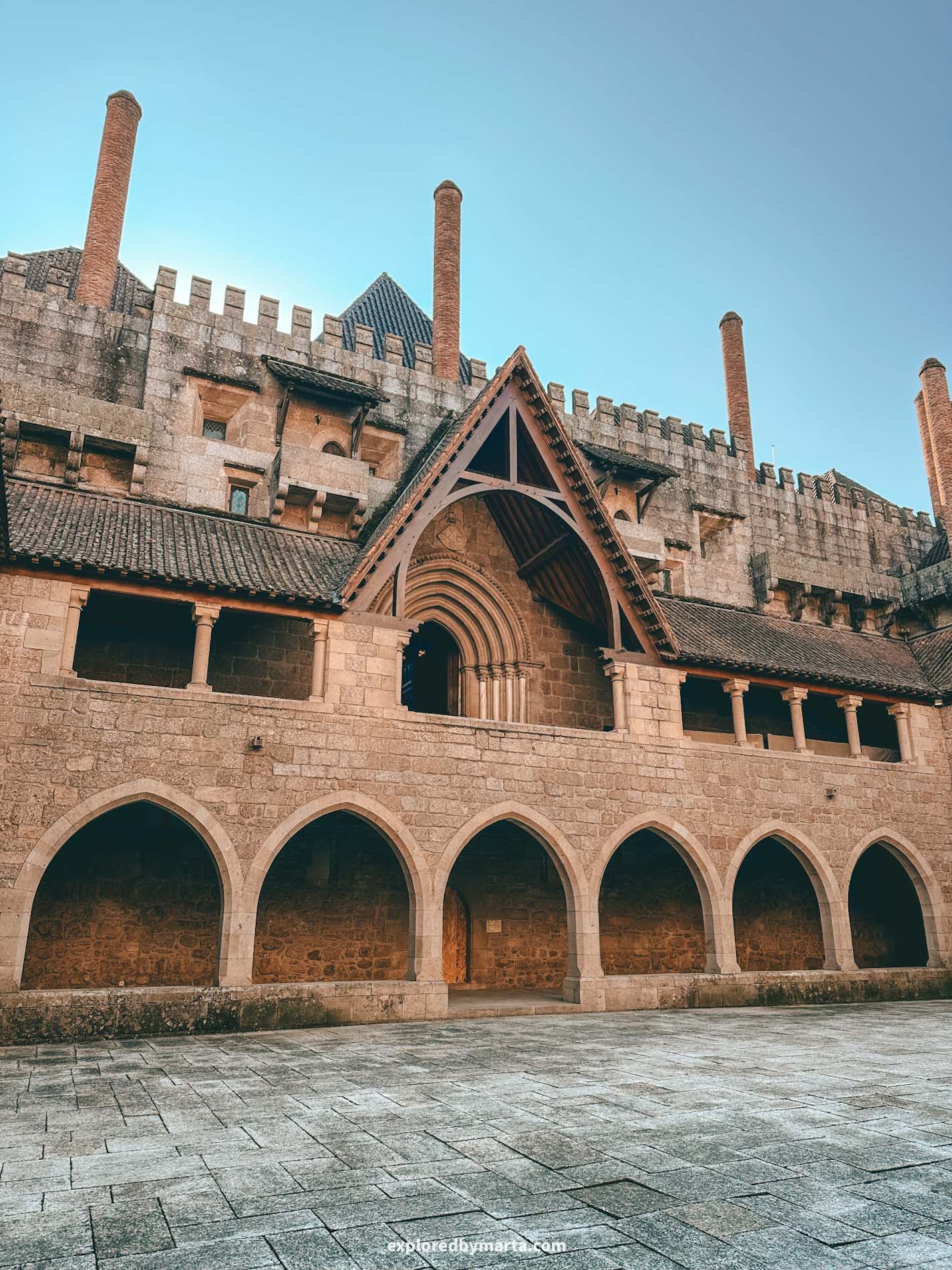
Exploring the majestic Palace of the Dukes of Bragança was one of my favorite things to do in Guimarães. I loved its charming courtyard surrounded by a beautiful arcade and all the stone halls and medieval vibes!
May I say, this grand palace is one of the most beautiful attractions in Northern Portugal, and I took way too many photos here, especially in the courtyard!
If you are into photography and want to take some beautiful photos, make sure to arrive shortly after opening times to beat the crowds!
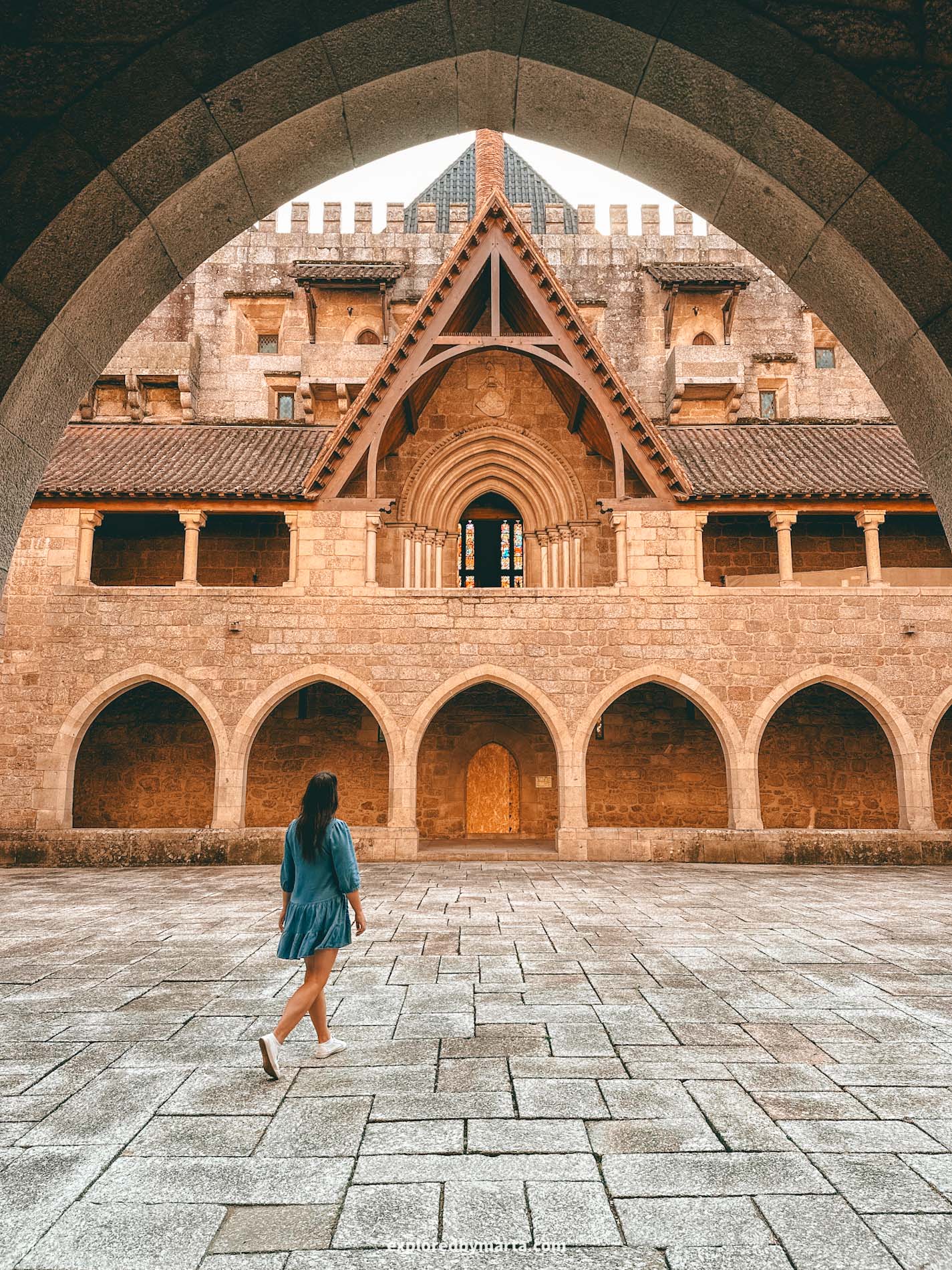
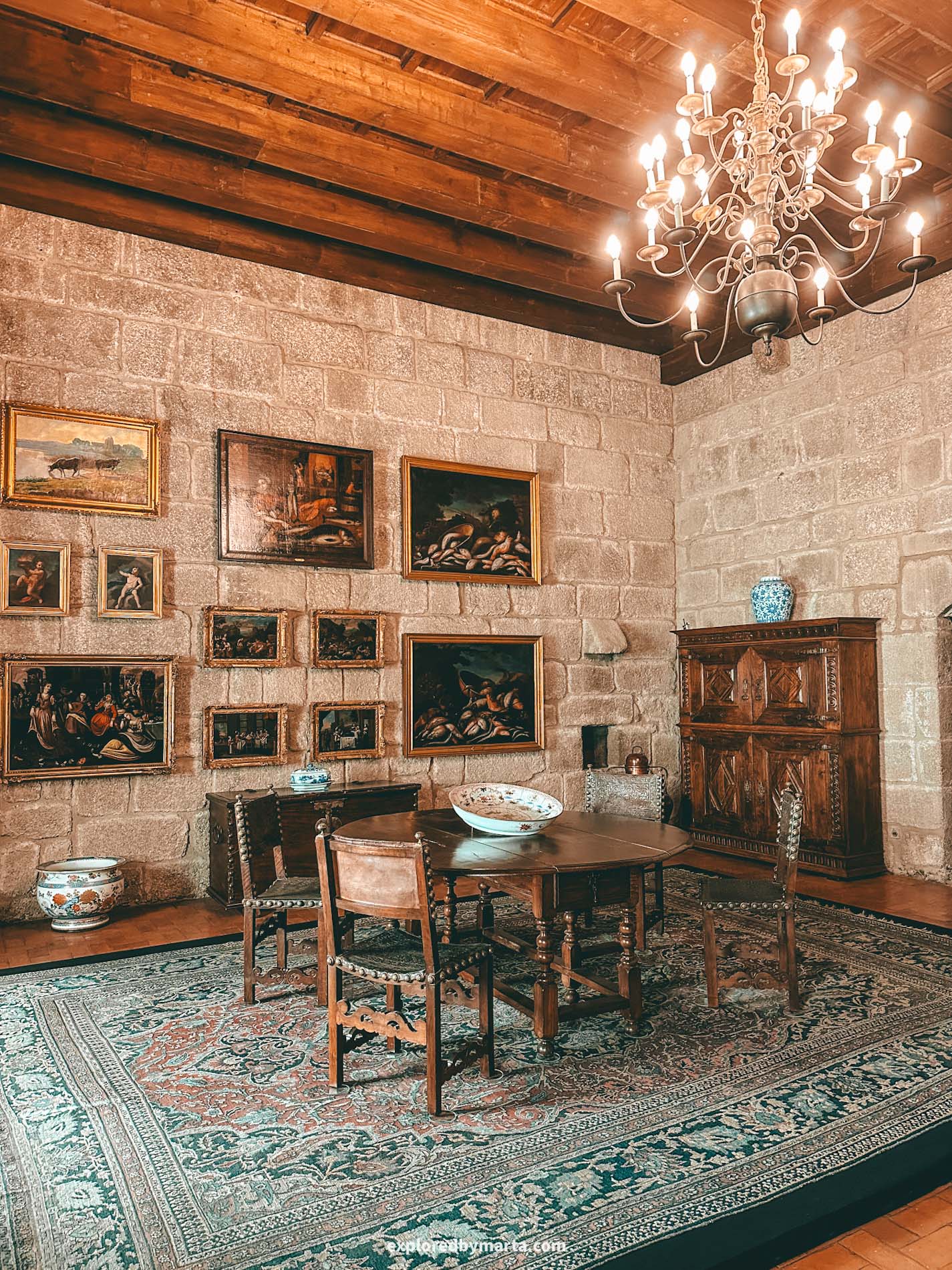
Once we finished exploring the courtyard, we went up to the upper floor to see the actual rooms and halls where they lived.
The rooms were beautifully decorated with rich tapestries, swords, paintings, and period furniture. Some of the massive tapestries showed scenes of some historical Portuguese battles.
Just a note – this isn’t an actual room layout from the 15th century, but rather a remake, because the palace was later significantly renovated and turned into a museum worth visiting.
But they did a great job! It did feel like walking through the medieval times!
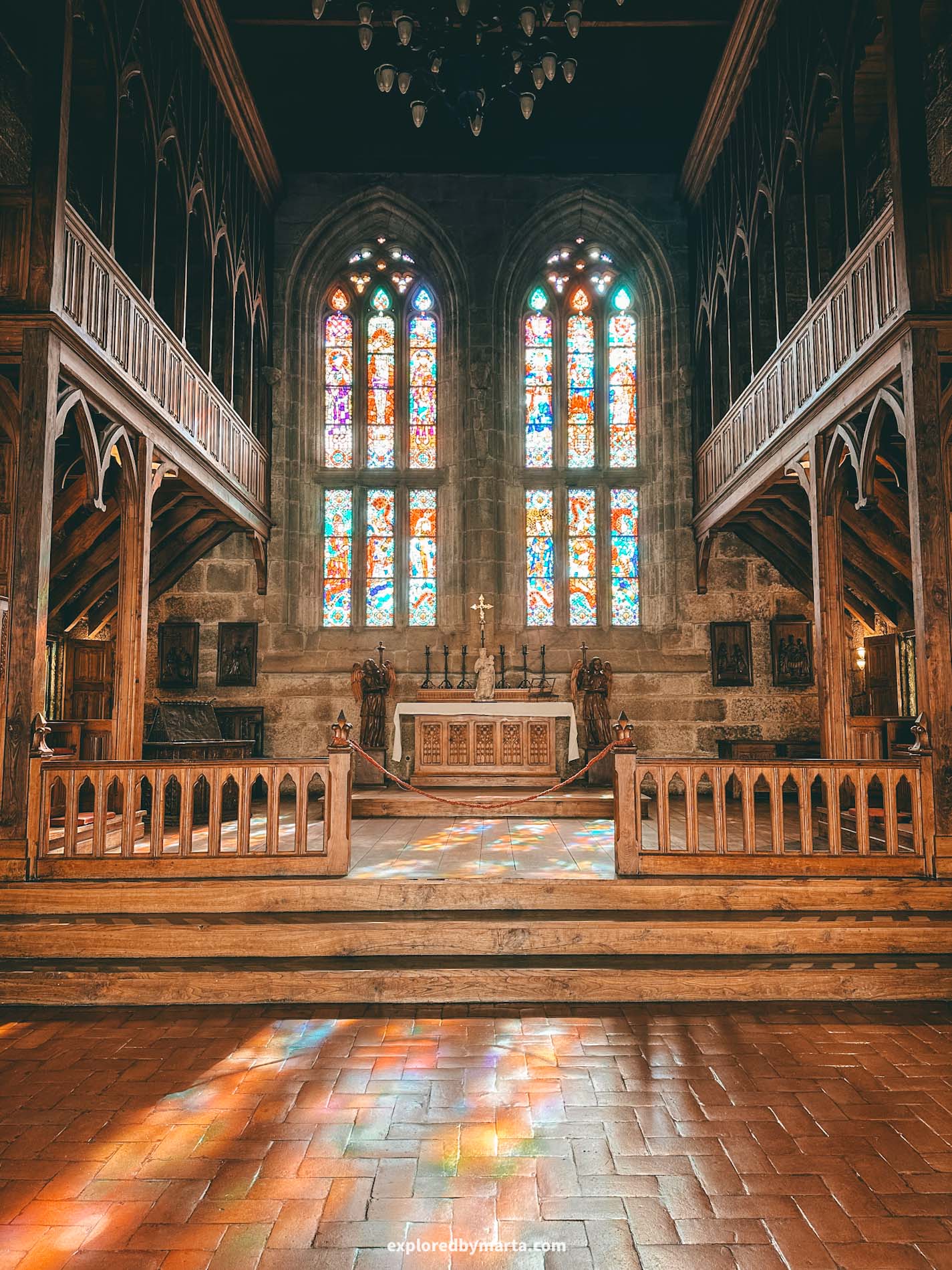
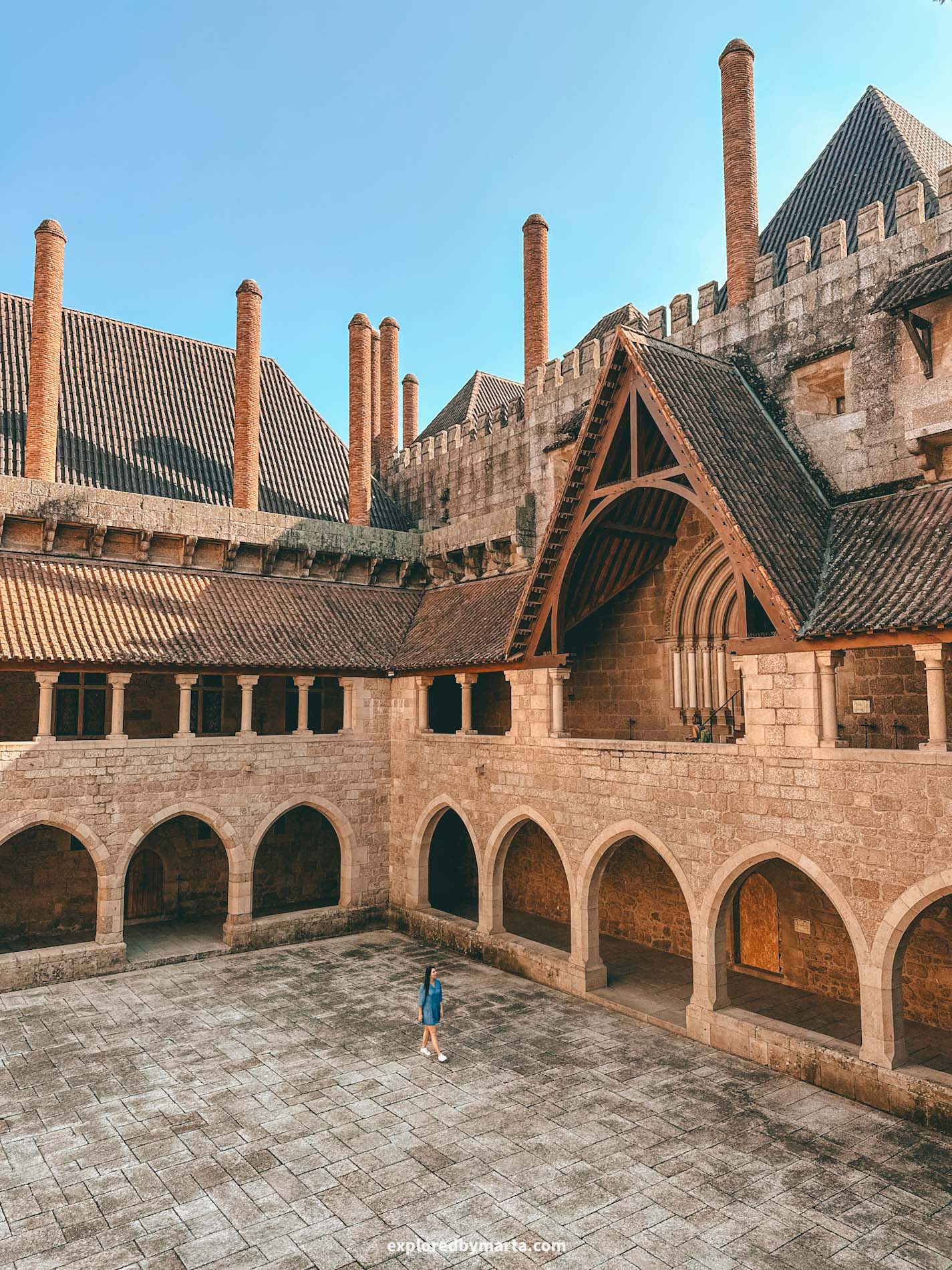
One of my favorite places was the chapel on the second floor, right across the palace entrance. It featured stunning stained-glass windows and wooden balconies. We arrived at the right time when the sun was shining through the window. It looked so serene!
From the upper floor, you also get a great overview of the courtyard from above.
The only puzzling question I had was – why did they need so many chimneys? I guess the palace was quite cold, so there might have been a fireplace in each room?
Overall, I loved this place. One of my favorites in Guimarães, for sure! There is an entrance fee of a couple of euros to enter the palace. At the ticket office in the palace, you can also buy entrance tickets for the Guimarães Castle nearby, which I also highly recommend visiting!
Location: Palace of the Dukes of Bragança
5. Peek into the tiny Igreja de São Miguel do Castelo
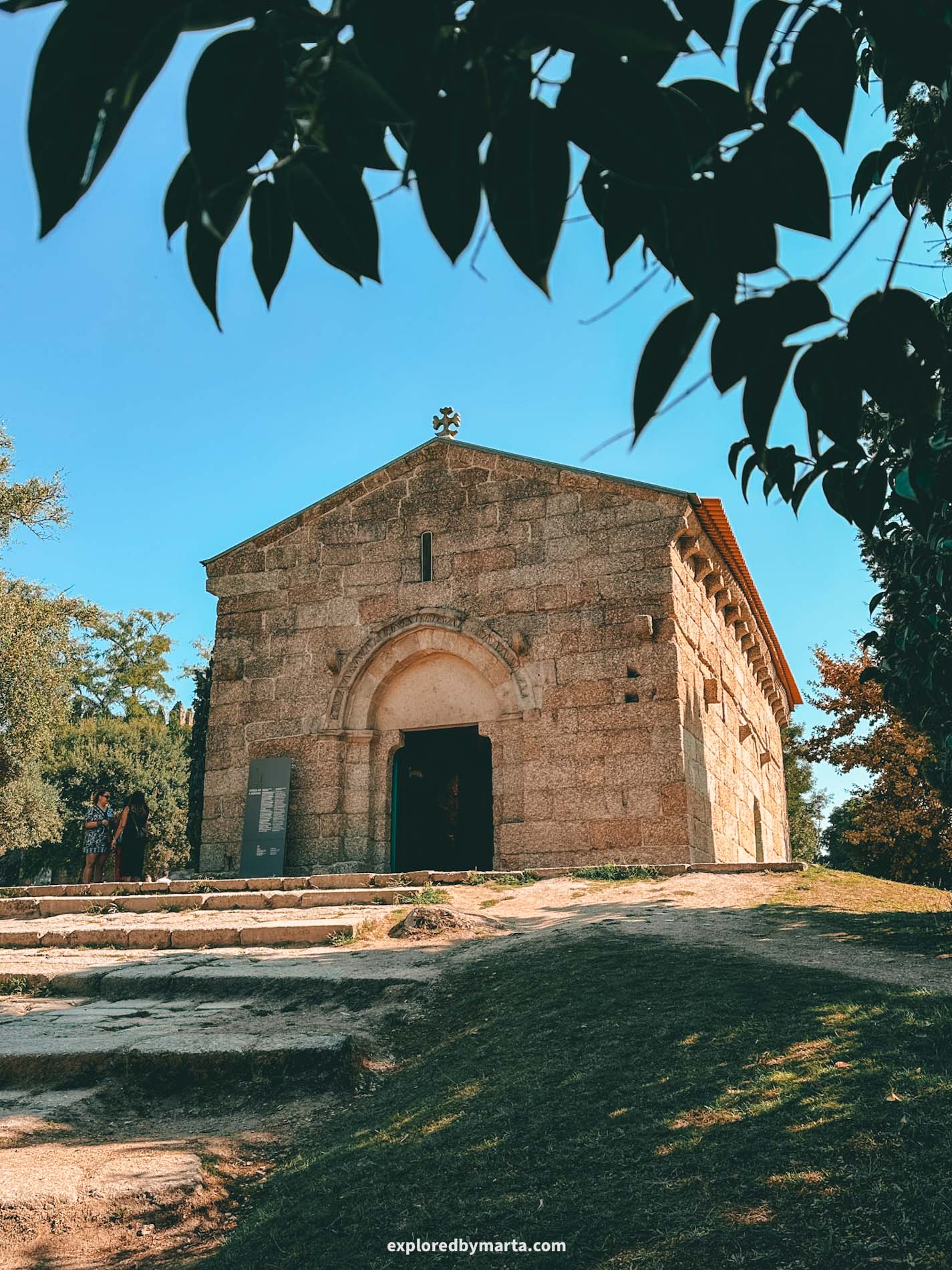
Once you finish exploring the palace, you should make your way uphill to the Guimarães Castle, but there is one spot you have to stop by before that – the tiny Igreja de São Miguel do Castelo.
Although the chapel looks very modest and small from the outside, it carries a significant historical heritage within its walls.
The history tells that this is the chapel where Portugal’s first king, Alfonso Henriques, was baptized back in the 13th century, so it makes it a special place to visit in Guimarães, the city known as the birthplace of Portugal.
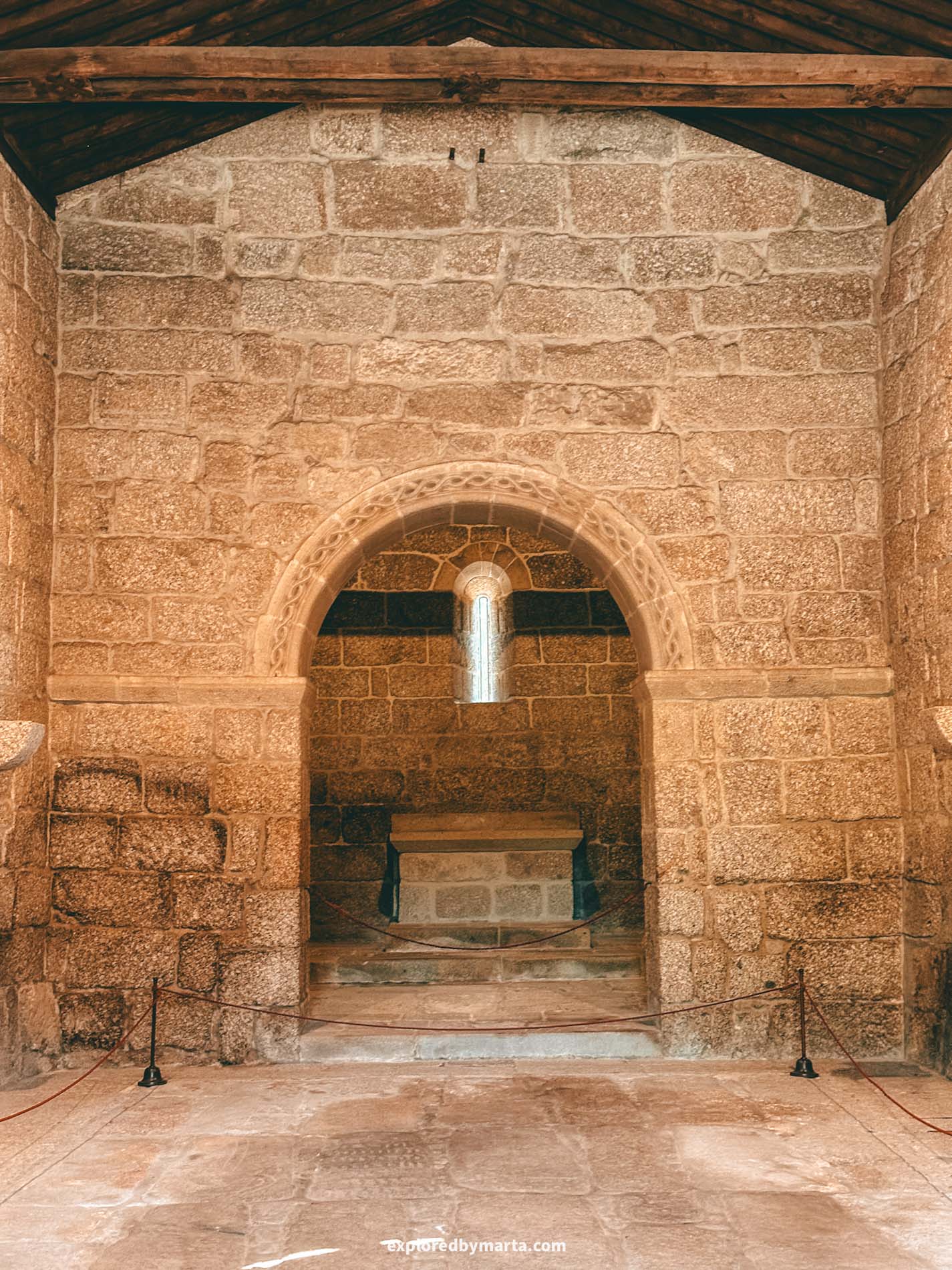
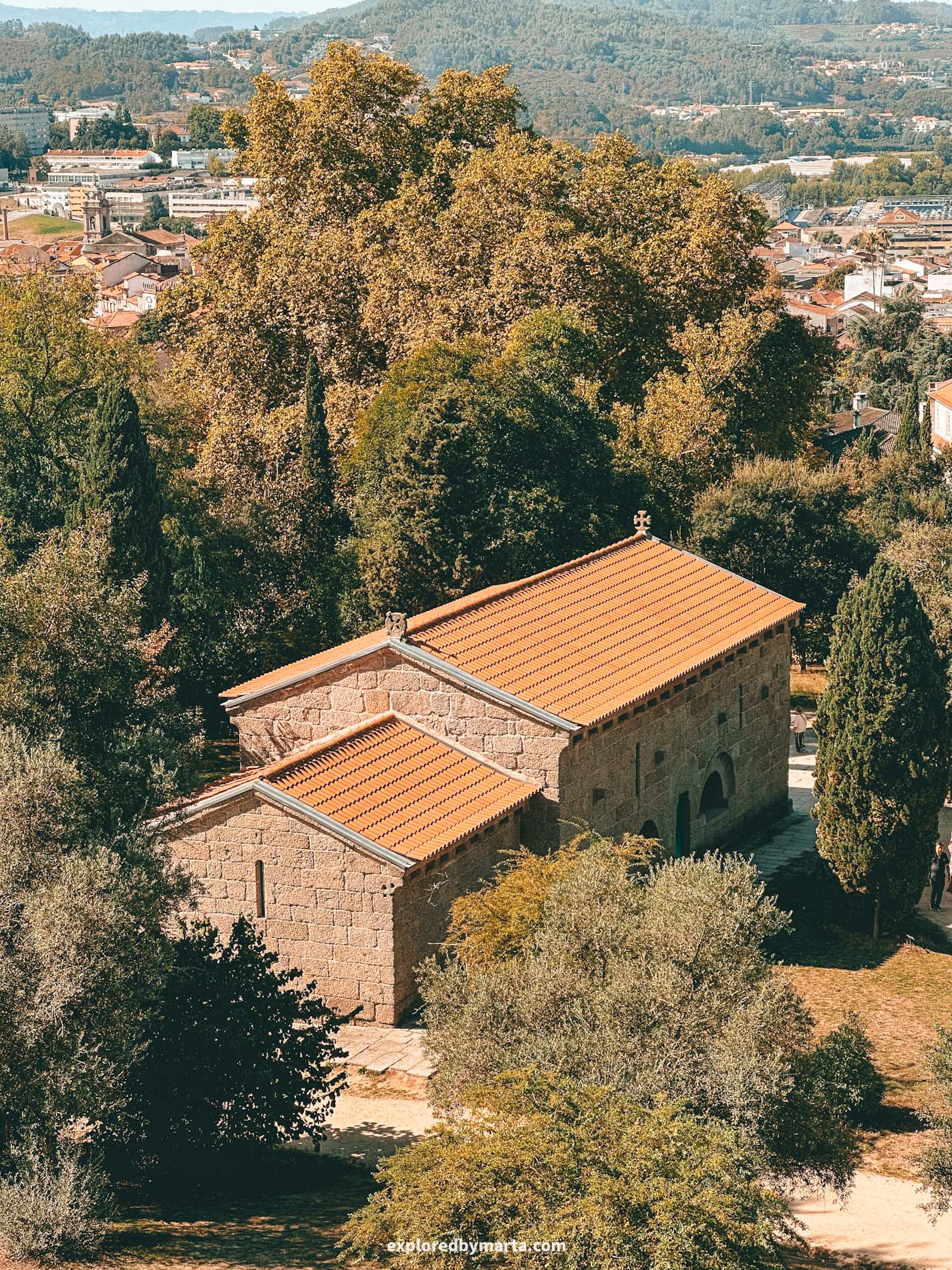
The chapel was open when we visited (right after visiting the palace), so we got to peek inside its granite walls. It turned out to be simple from the inside, as well.
The floors are paved with ancient stones with inscriptions, but at the front of the chapel, you’ll find a baptismal basin, seemingly indicating the chapel’s role in Portugal’s history. However, it doesn’t say this is the exact basin used to baptize the king.
The chapel is free to visit. We spent a couple of minutes in this special place and then moved on to the next popular attraction in Guimarães – the Castle of Guimarães.
Location: Igreja de São Miguel do Castelo
6. Explore the Guimarães Castle
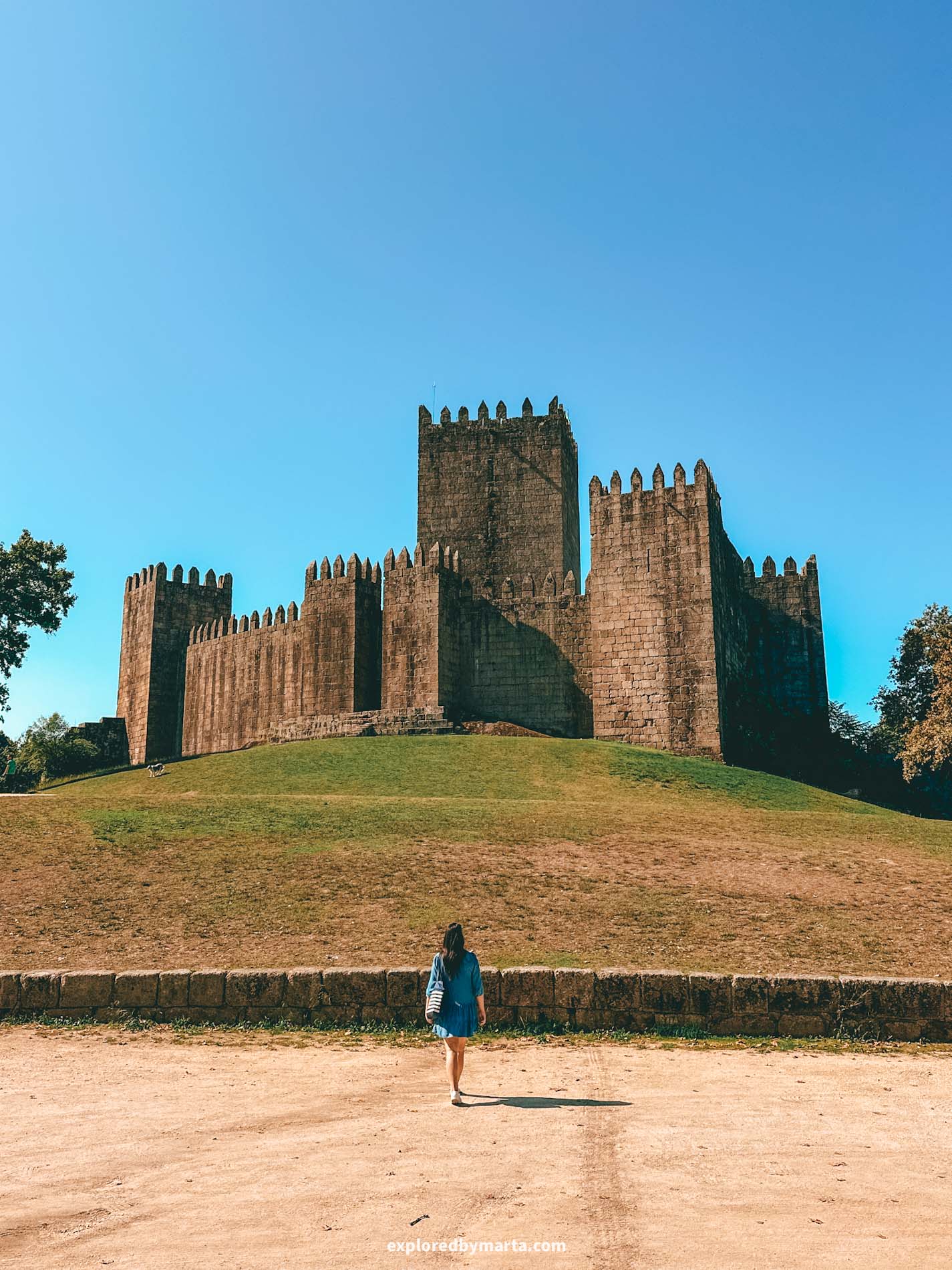
Known as one of the Seven Wonders of Portugal (a list of popular and significant attractions voted by the Portuguese themselves), Guimarães Castle sits on a green hill overlooking the Guimarães town.
The castle dates back to the 10th century and was built to defend the local settlement from attacks. It is more like a fortress, so you won’t find there any grand bedrooms or halls – just thick stone walls drenched in 1,000 years of history.
What you see there today mostly dates back to the 12th century, when Count Henry of Burgundy lived there with his wife Teresa. Their son, Afonso Henriques, later became the first king of Portugal.
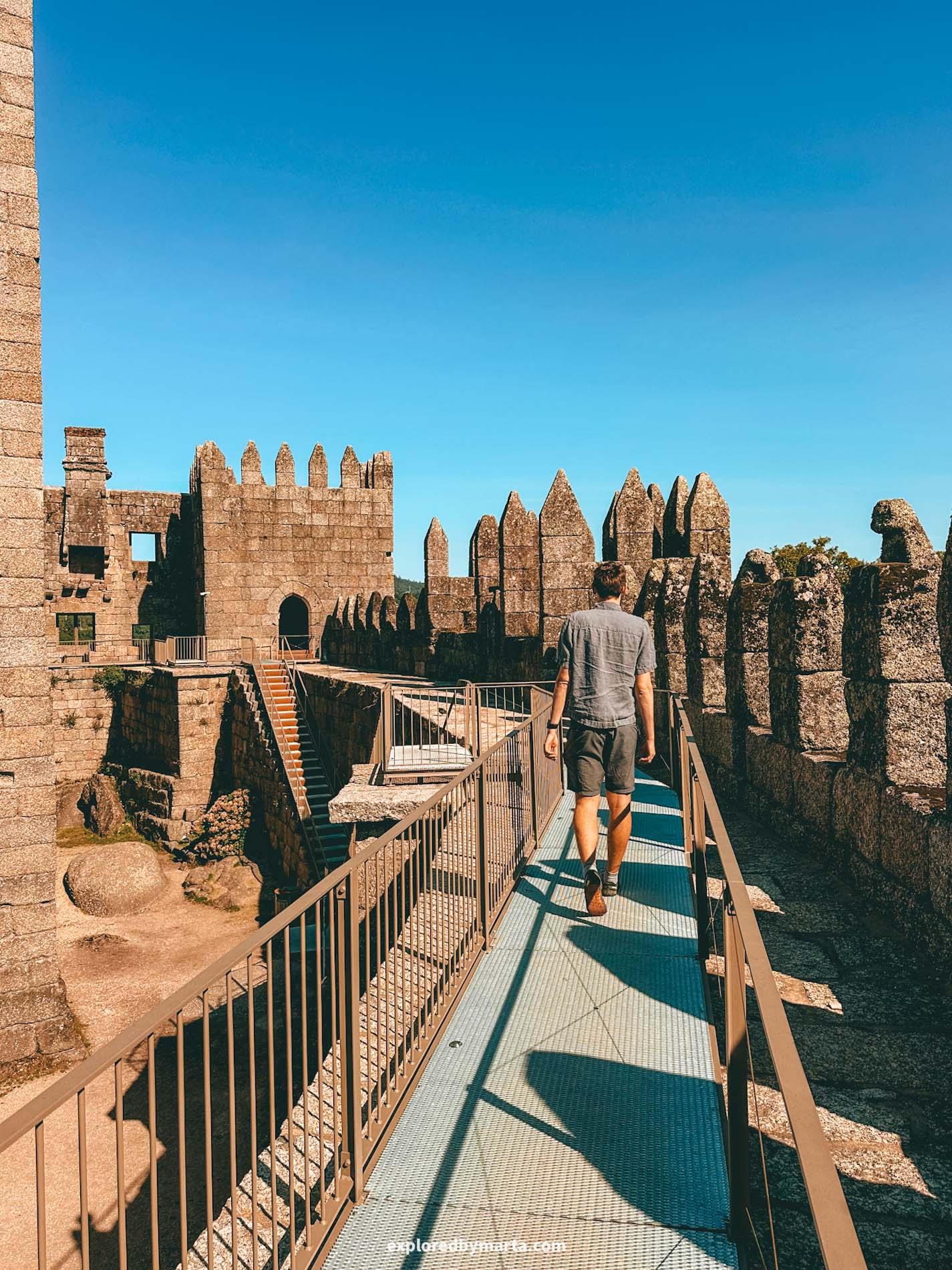
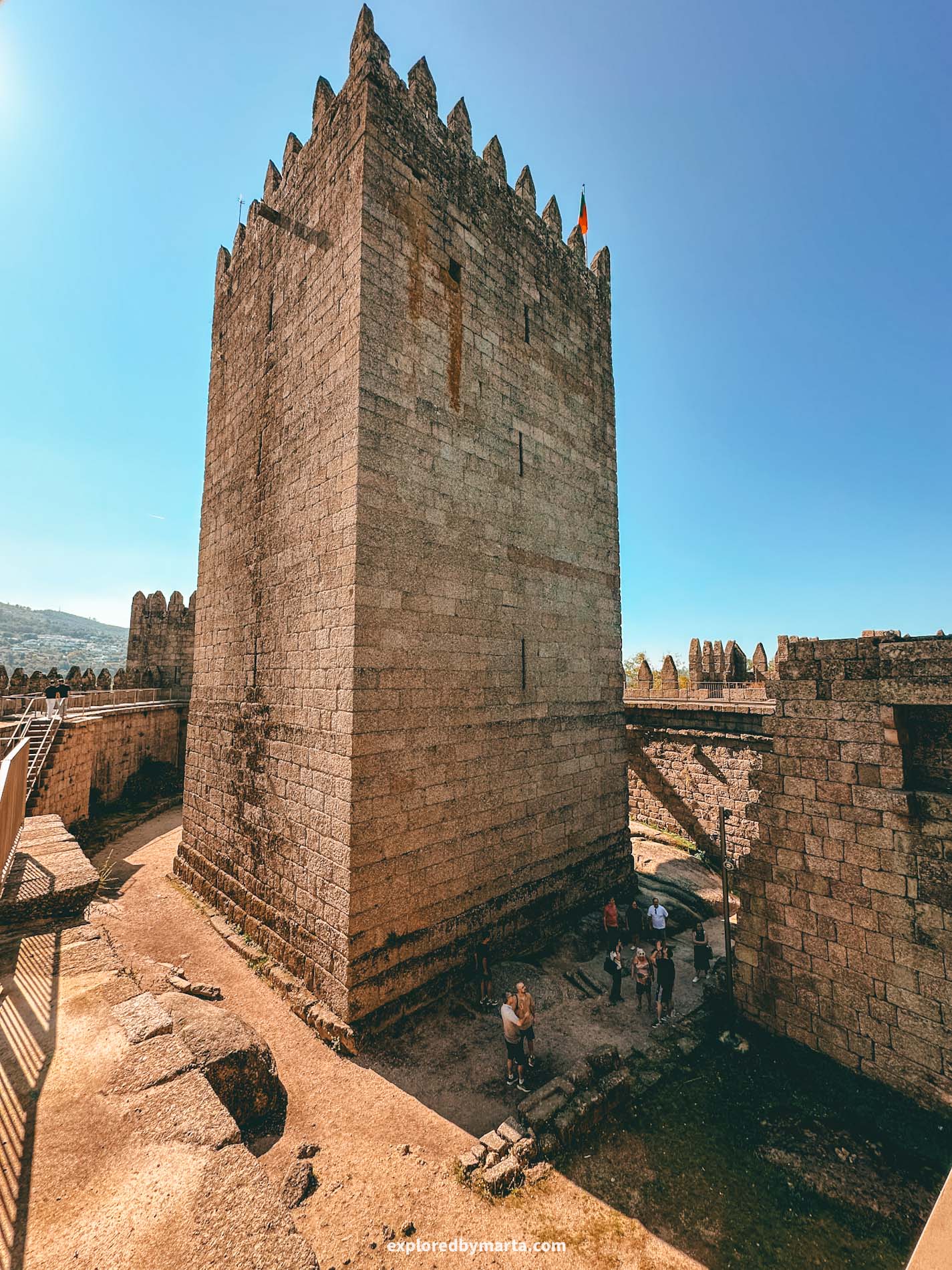
It is believed that King Alfonso Henriques spent part of his childhood within the walls of this castle, so today people see it as the cradle of the nation – the place where Portugal was born!
Exploring the Guimarães Castle is one of the best things to do in Guimarães. There is an entry fee to enter the castle, which you can pay back at the palace. We bought a combined ticket to both monuments.
To be honest, there is not a lot to see – the inner courtyard, the fortress walls and eight defensive towers, and that’s about it. But walking around there does feel like stepping back in time.
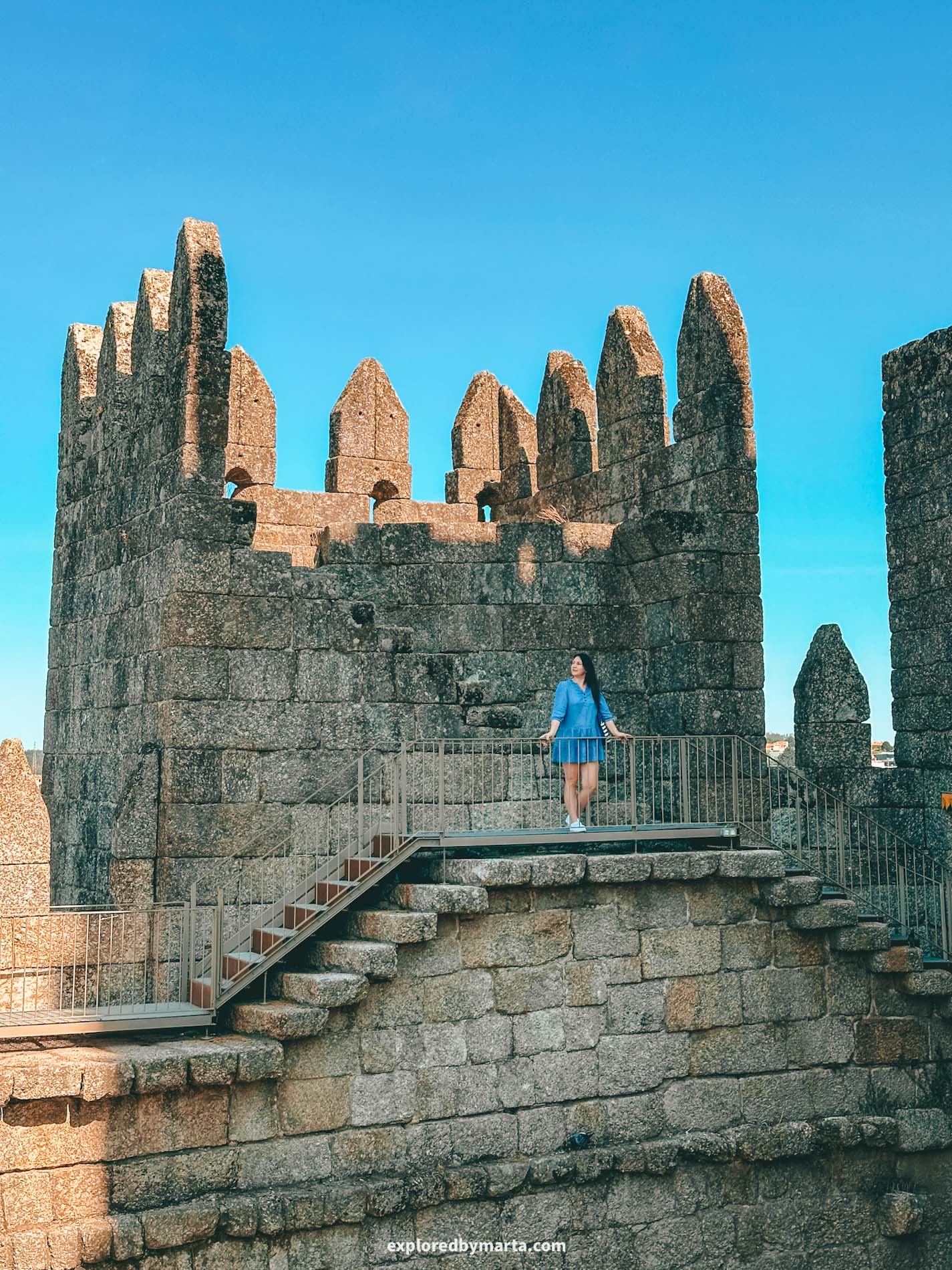
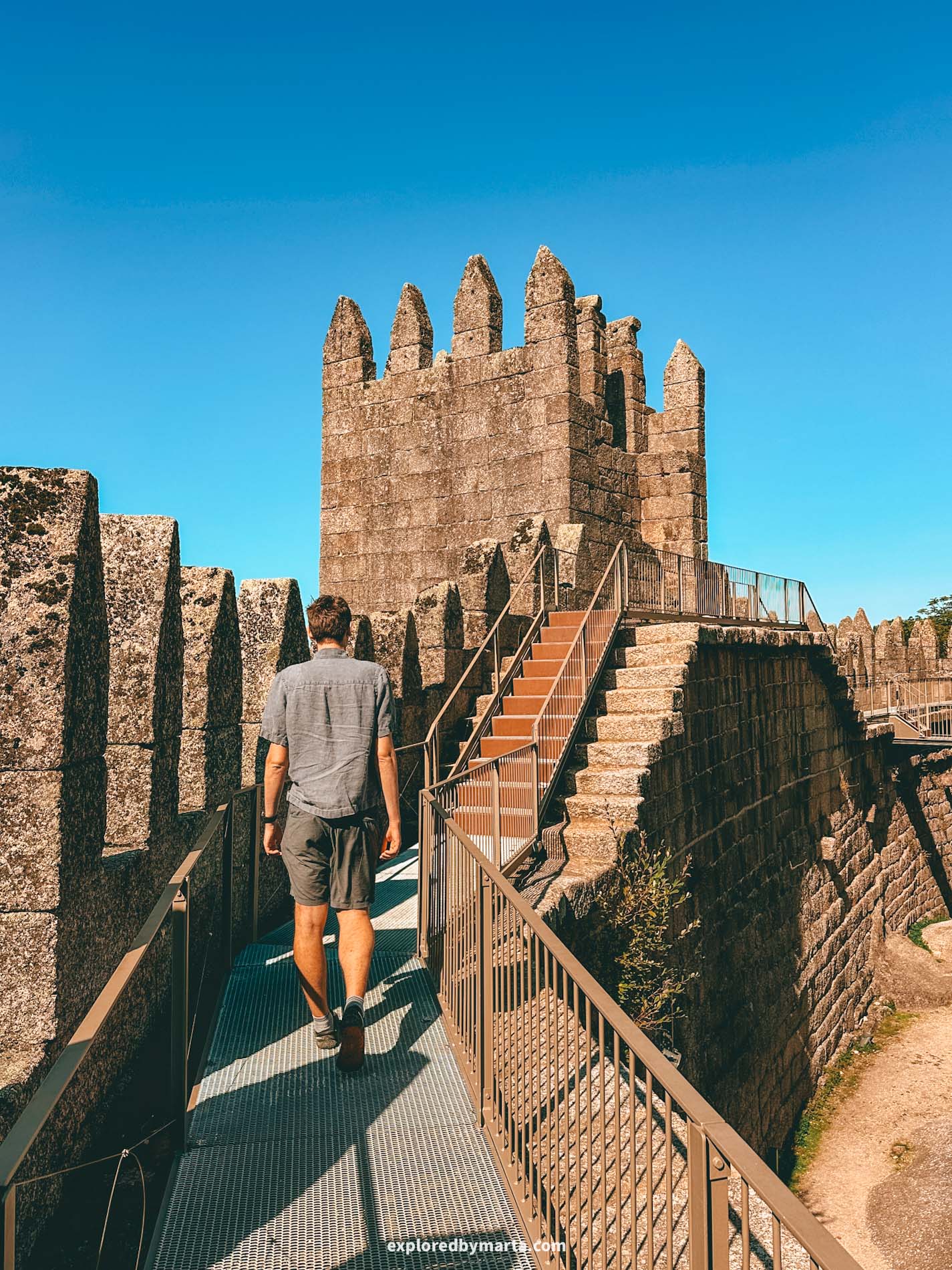
We climbed up the stairs and walked around the top of the walls, and, of course, admired the panoramic views of Guimarães. This is the best place to count all the chimneys towering above the majestic Palace of the Dukes of Bragança, haha!
After the visit, we walked around the castle and found the perfect vantage point for a photo of the castle sitting on a green hill (see the first photo).
If you’re exploring Guimarães, don’t skip this place – it’s where the story of Portugal truly began.
Location: Guimarães Castle
7. Walk the top of the medieval Guimarães city walls
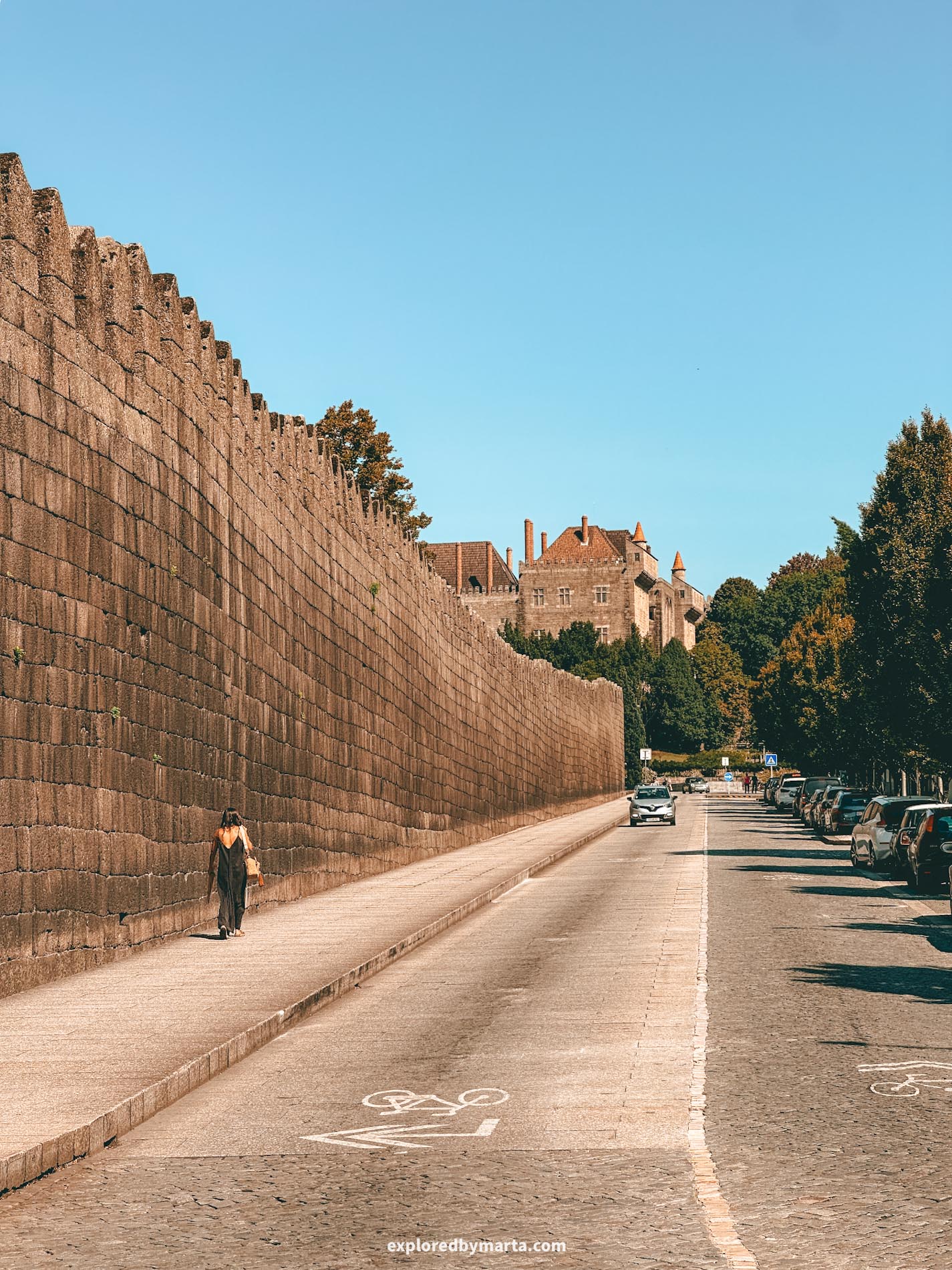
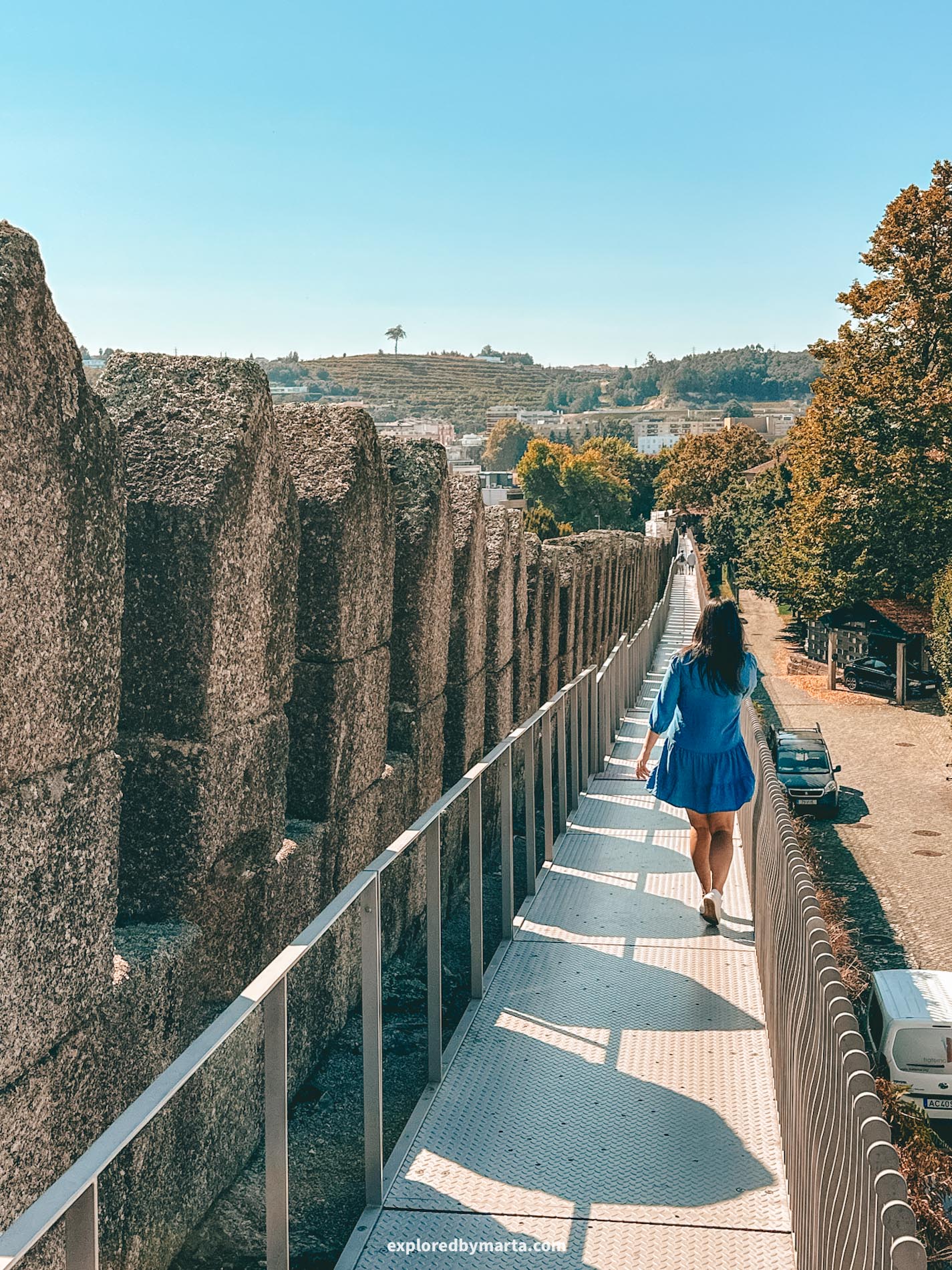
As we walked back to the city center from visiting the palace and the castle, we stopped by Muralhas de Guimarães, or the old medieval city walls of Guimarães.
These stone walls once surrounded and protected the old town. Only a small fraction of the walls remain to this day, but, historically, it is a very significant place and is definitely one of the top places to visit in Guimarães.
The city walls were built between the 10th and 12th centuries, or in the early stages of the Portuguese country. Today, you can climb up to the top of the walls and walk along them like a medieval city guard.
One of the access points to the walls is Porta do Burgo, and the other one is next to the Capela Senhor dos Passos chapel. At both ends, there are stairs you can use to climb to the top of the walls and then walk along them.
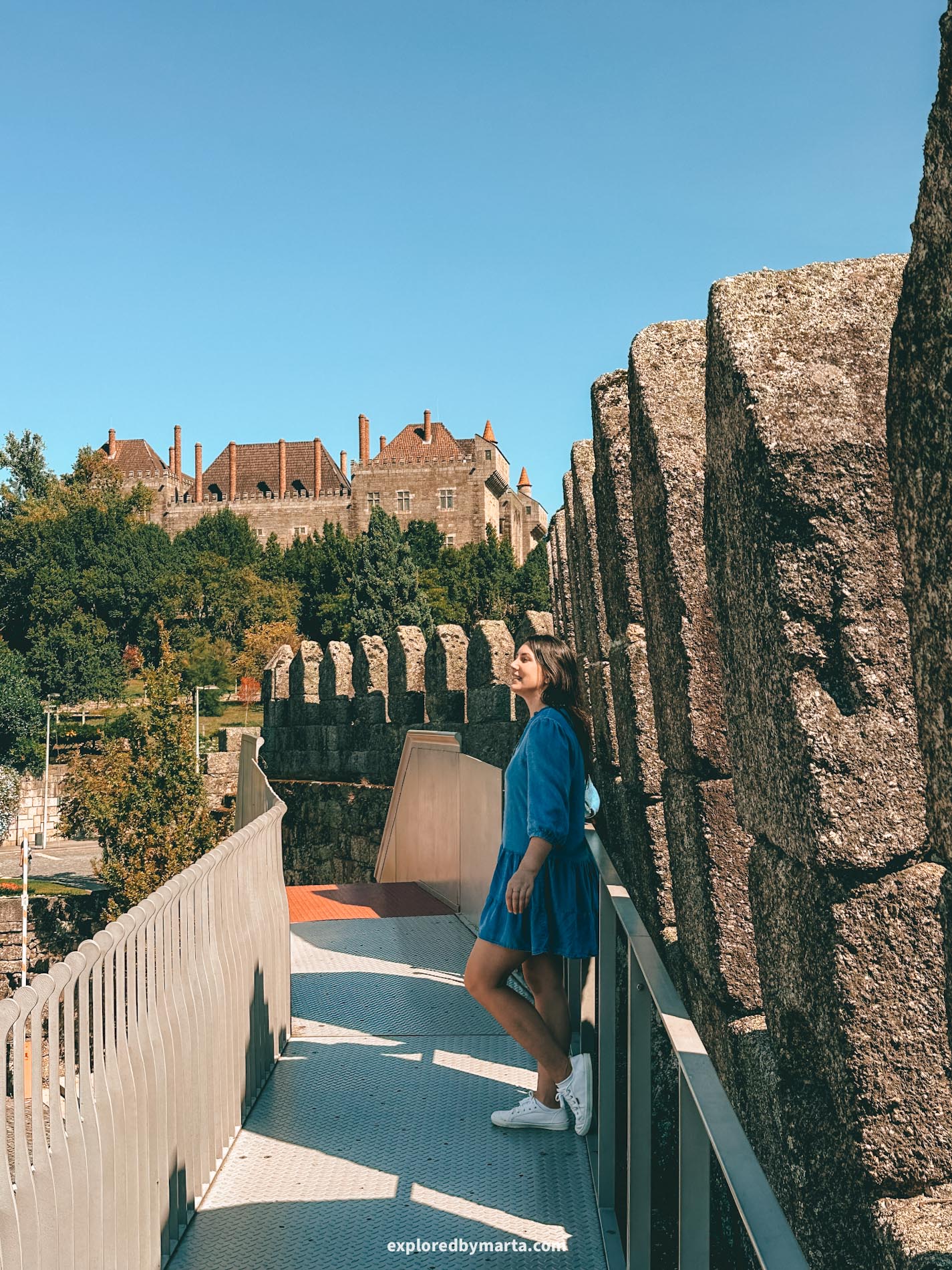
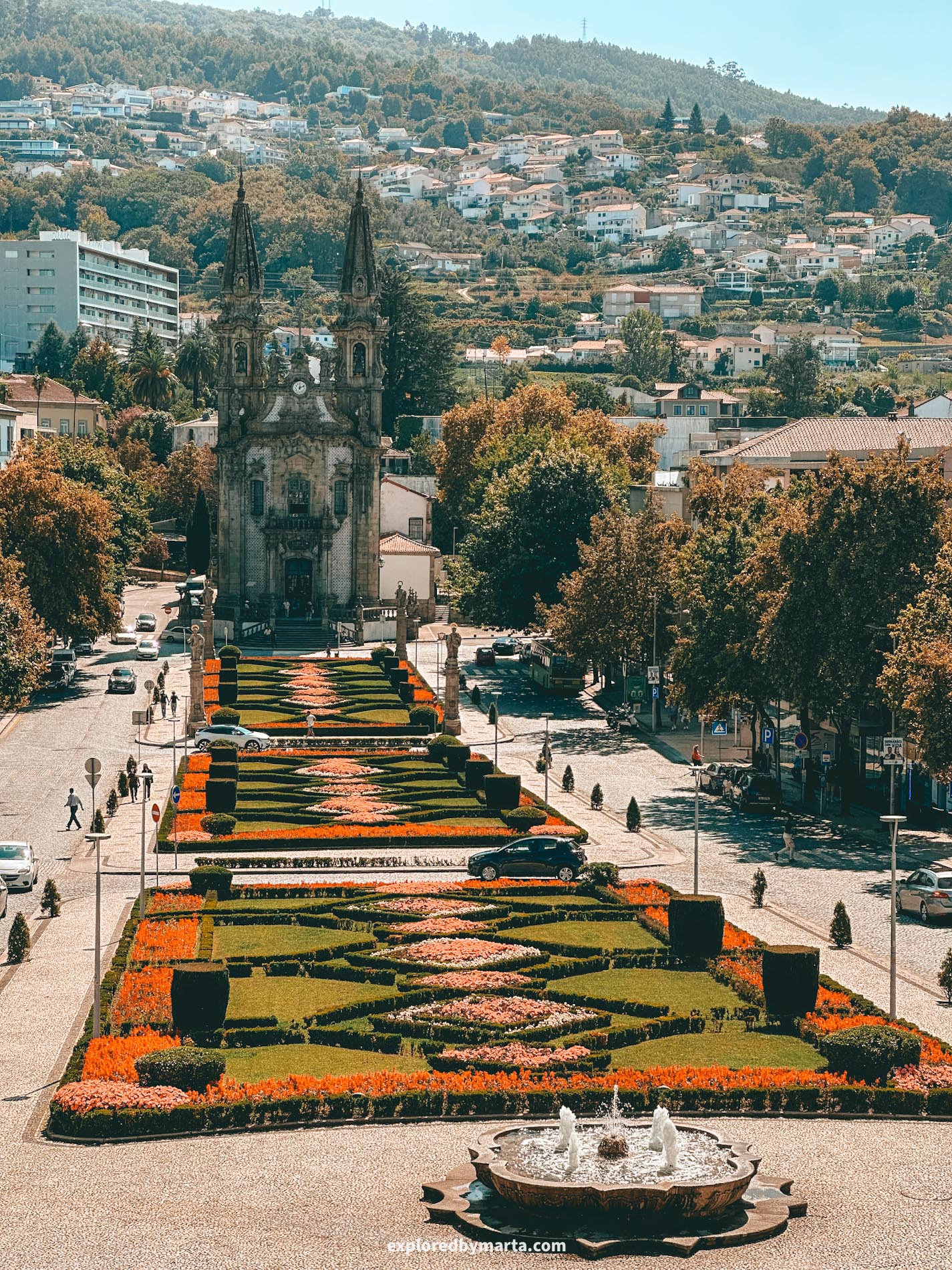
The length of the walkable section is about 250 to 300 meters long (roughly 820 to 984 feet). To my knowledge, they do have working hours, but you can access the wall for free. We went there around 11 AM, and it was open.
My favorite part of the city walls was the view that we got when we reached the end next to the Garden of Largo Republic of Brazil. We could see the whole beautiful avenue with its colorful flowers from above. The view was truly stunning with the church at the end of the street!
Walking the medieval wall was one of my favorite things to do in Guimarães.
After all, you have to get back to the city center anyway (after visiting the castle), so you can either walk along the paved sidewalk or you can walk the nearly-thousand-year-old medieval walls. Your choice!
It doesn’t take long, but it definitely adds meaning to your visit and gives you a better sense of how the city once looked and why it played such an important role in Portugal’s history.
Location: Muralhas de Guimarães
8. Listen to the organ at Guimarães’s main church
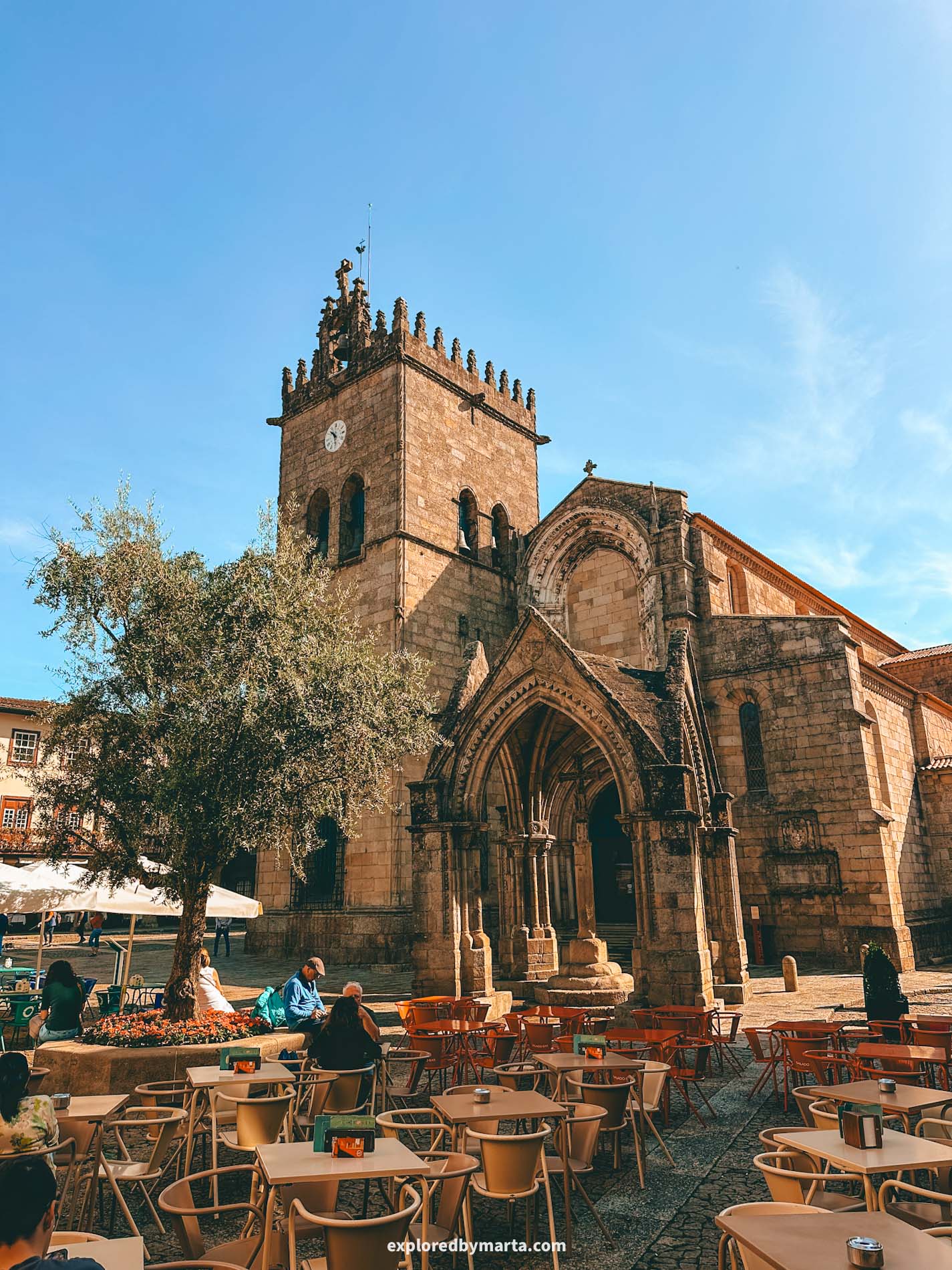
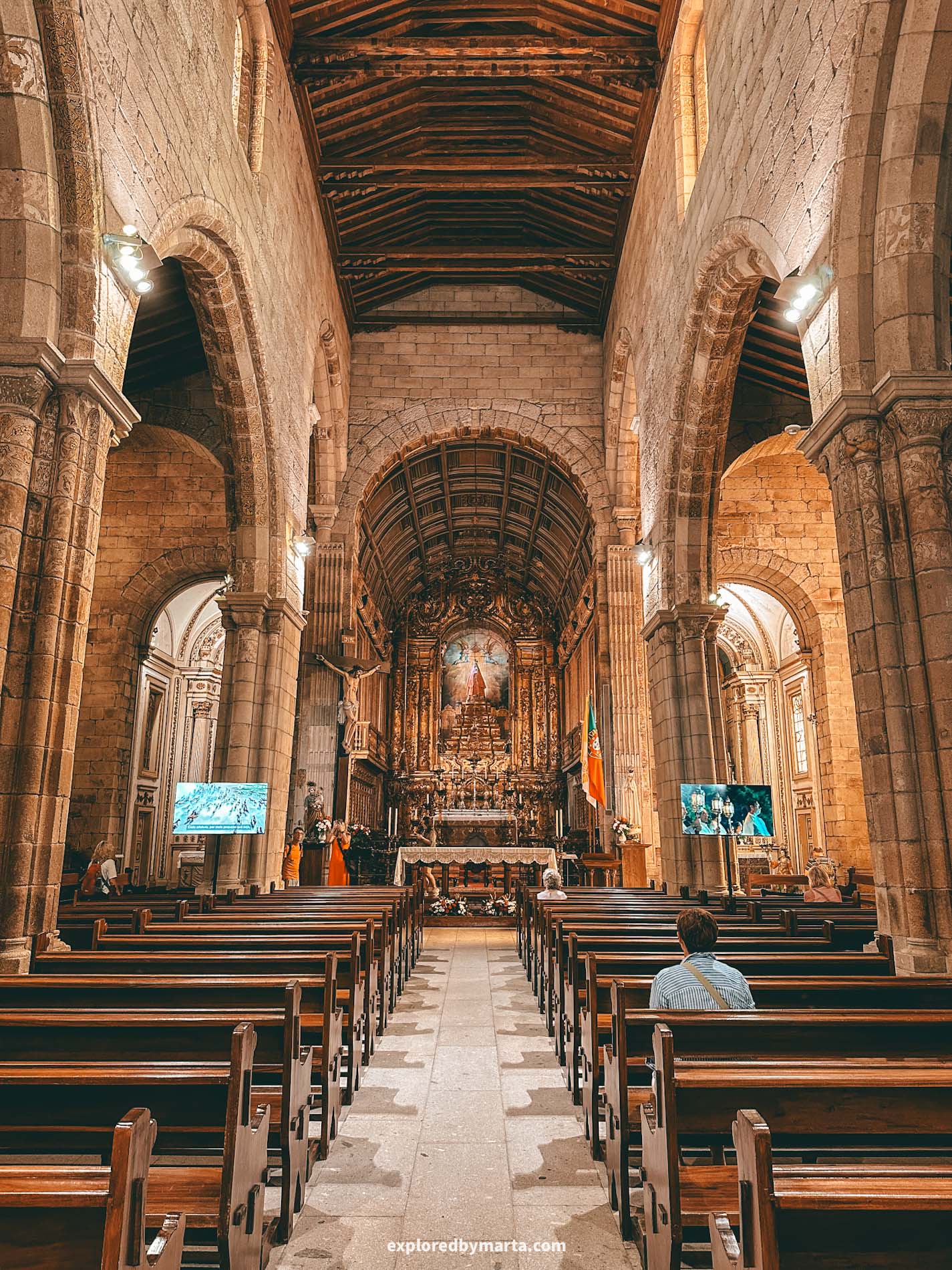
Once you’ve returned to the old town from exploring the town’s most famous attractions (the palace and the castle), it is the right time to peek into Guimarães’s main church – Church of Nossa Senhora da Oliveira, located in Largo da Oliveira square.
Why? We went there around lunchtime, and this is when there was somebody playing the church’s organ (as I’ve read in reviews, there are regular performances). We listened to a couple of songs while walking around the church. It was quite impressive.
If you will, you can even climb up to the upper balcony and see the organ up close.
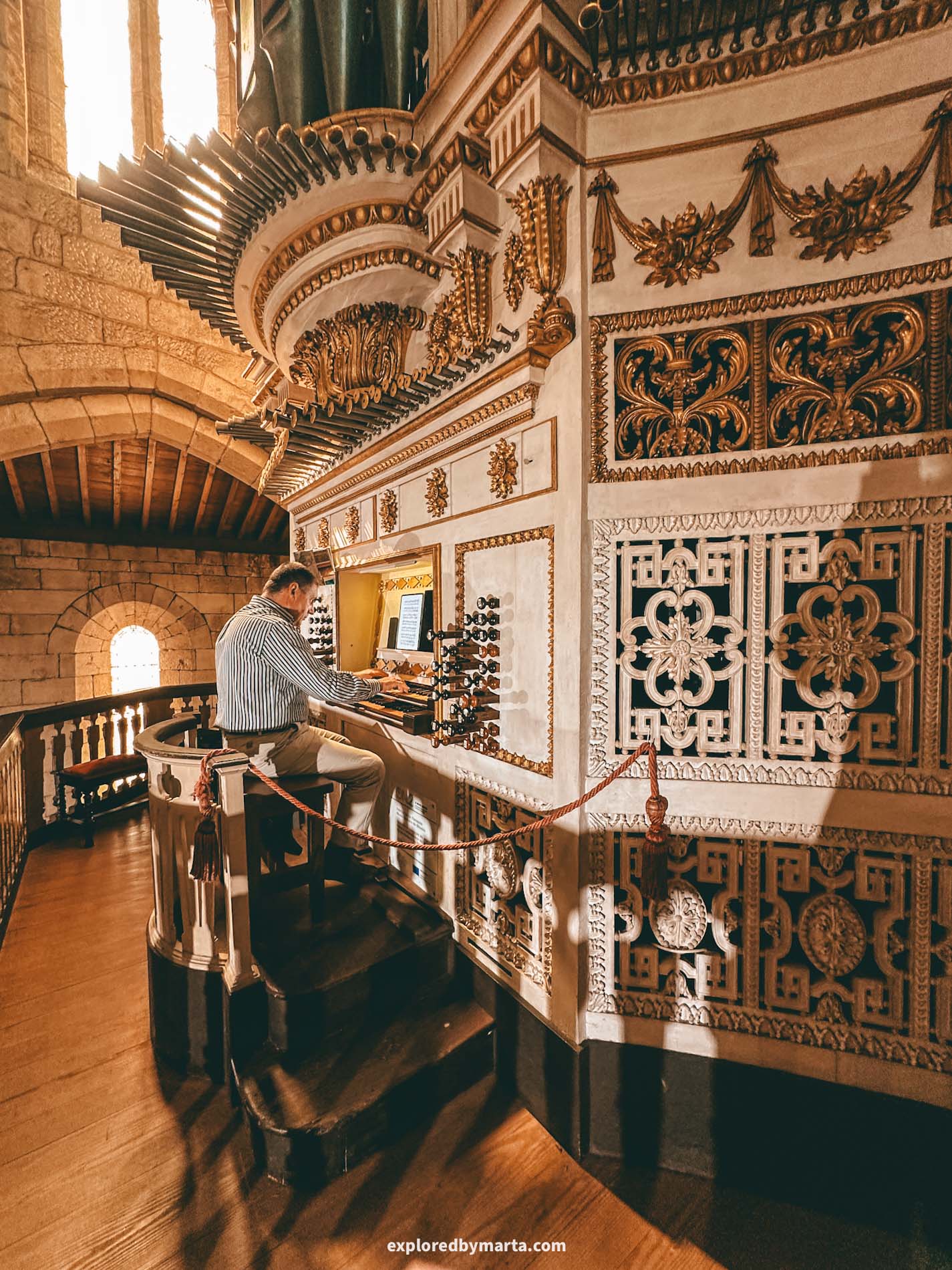
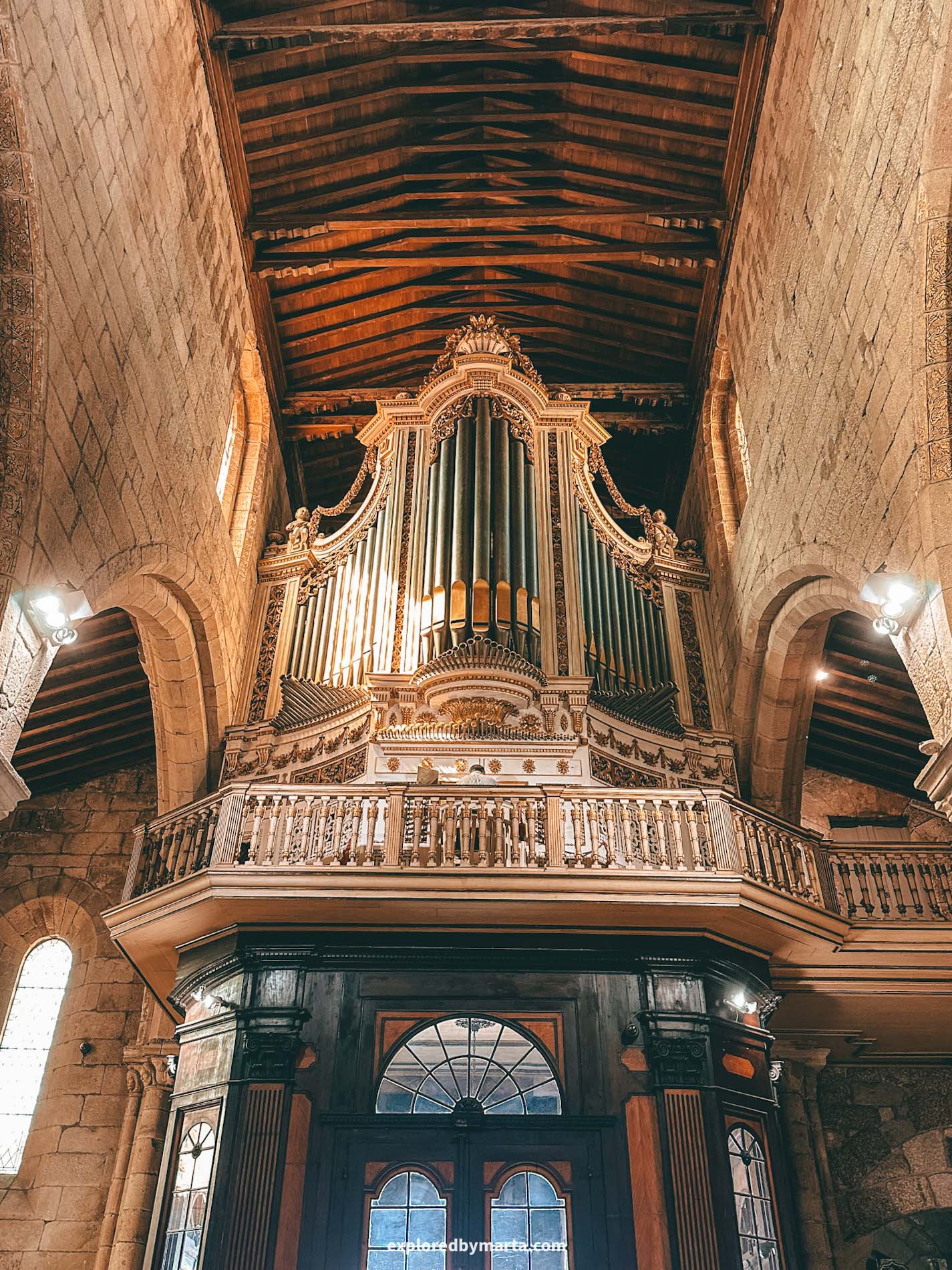
However, the church is so much more than that. The beautiful Gothic structure dates back to the 10th century, though it was rebuilt and expanded many times over the centuries. History really oozes from its walls!
This current version dates back to the 14th century, when King João I ordered it to be rebuilt after winning the Battle of Aljubarrota, one of the most important battles in Portuguese history, which basically secured Portugal’s independence from modern-day Spain.
According to legend, Portugal’s king made a promise to dedicate this church to the Virgin Mary if he won the Battle of Aljubarrota, so the church was named Nossa Senhora da Oliveira, or Our Lady of the Olive Tree, in her honor.
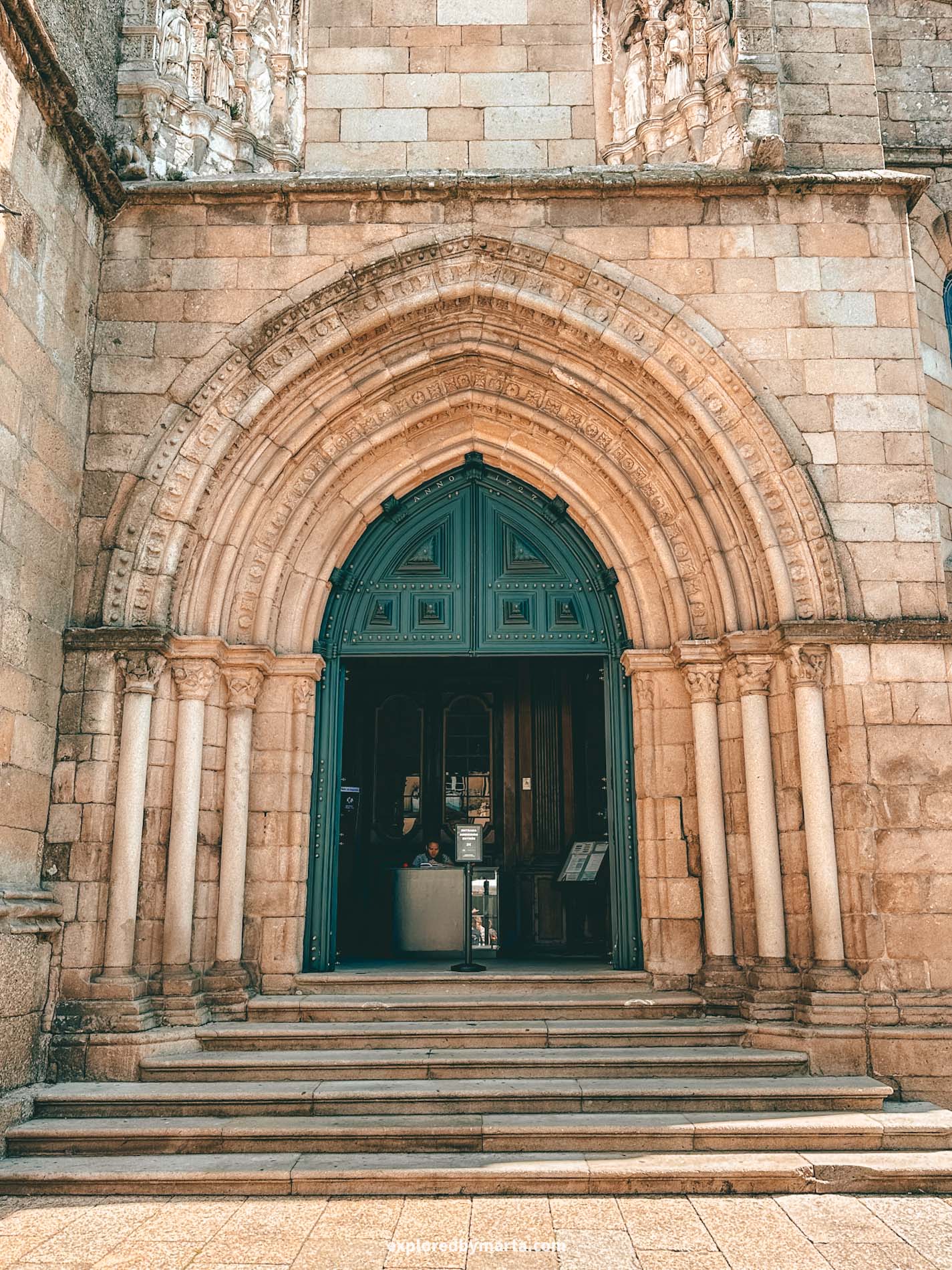
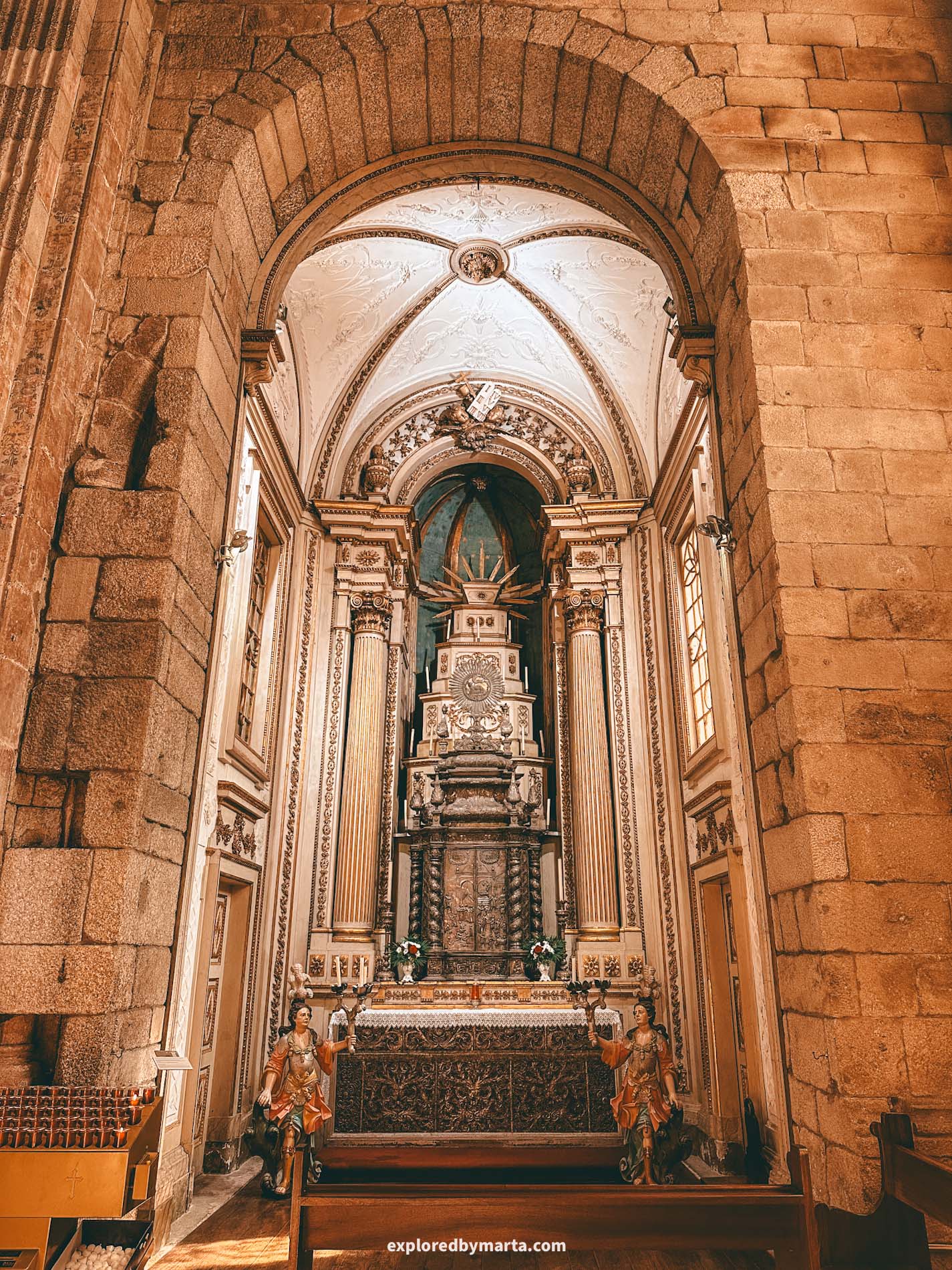
As you may have noticed, the church’s name also mentions an olive tree. It refers to an ancient tree that once stood right in front of the church. Today, a new olive tree stands in the same spot in the middle of the iconic medieval square. The legend lives on!
I always love exploring centuries-old cathedrals because of the history they carry with them, because of the majestic architecture, and because of their timeless charm and atmosphere. It is wild to imagine how they built such strong structures all that time ago!
If you are visiting Guimarães during the summer heat, this church will be a pleasant escape from the sun. Entrance is free. We spent about 20 minutes there. It’s not a big church, but it’s one of those places that feels truly authentic!
Location: Igreja de Nossa Senhora da Oliveira
9. Soak up history at the Museu de Alberto Sampaio
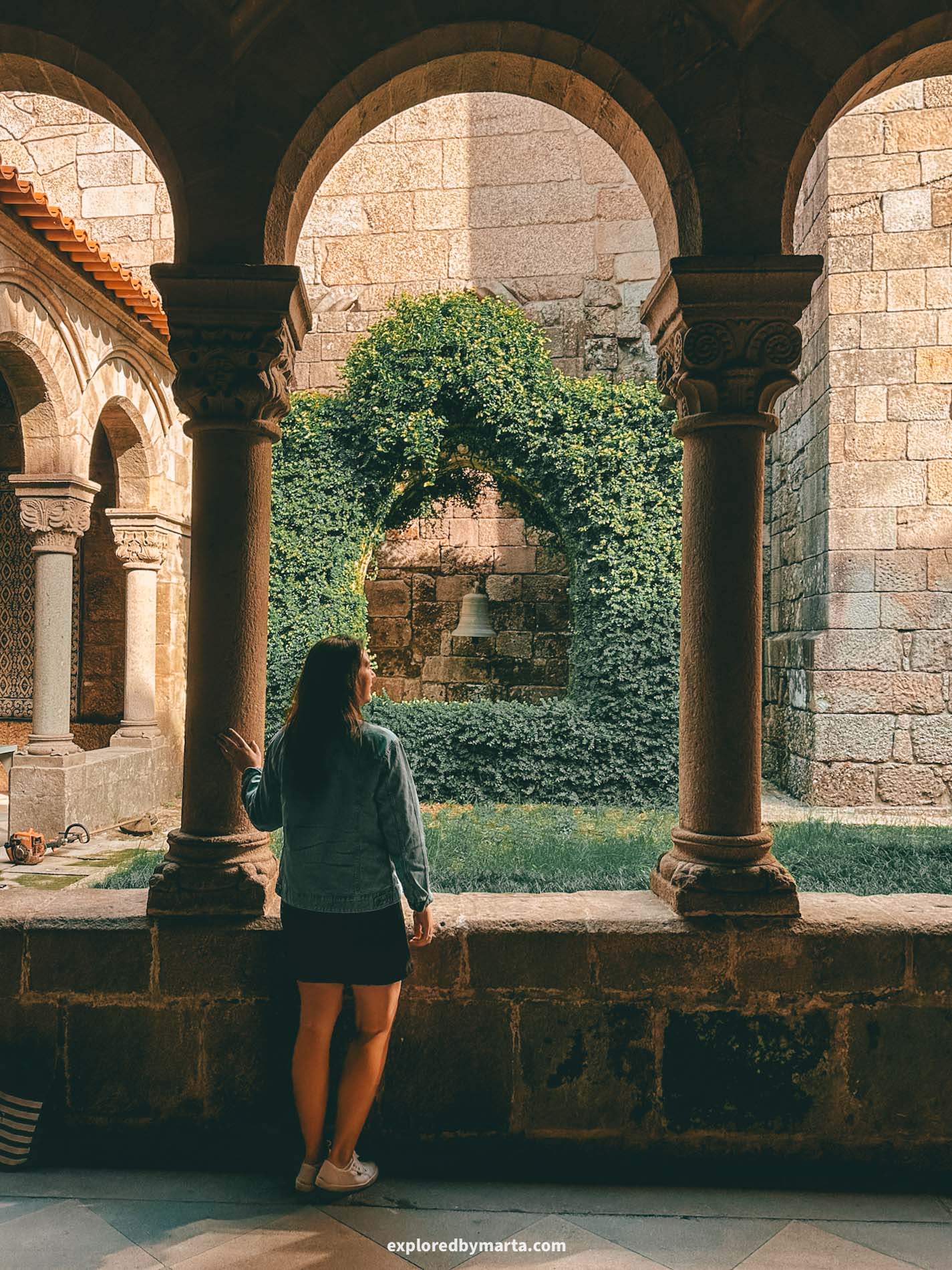
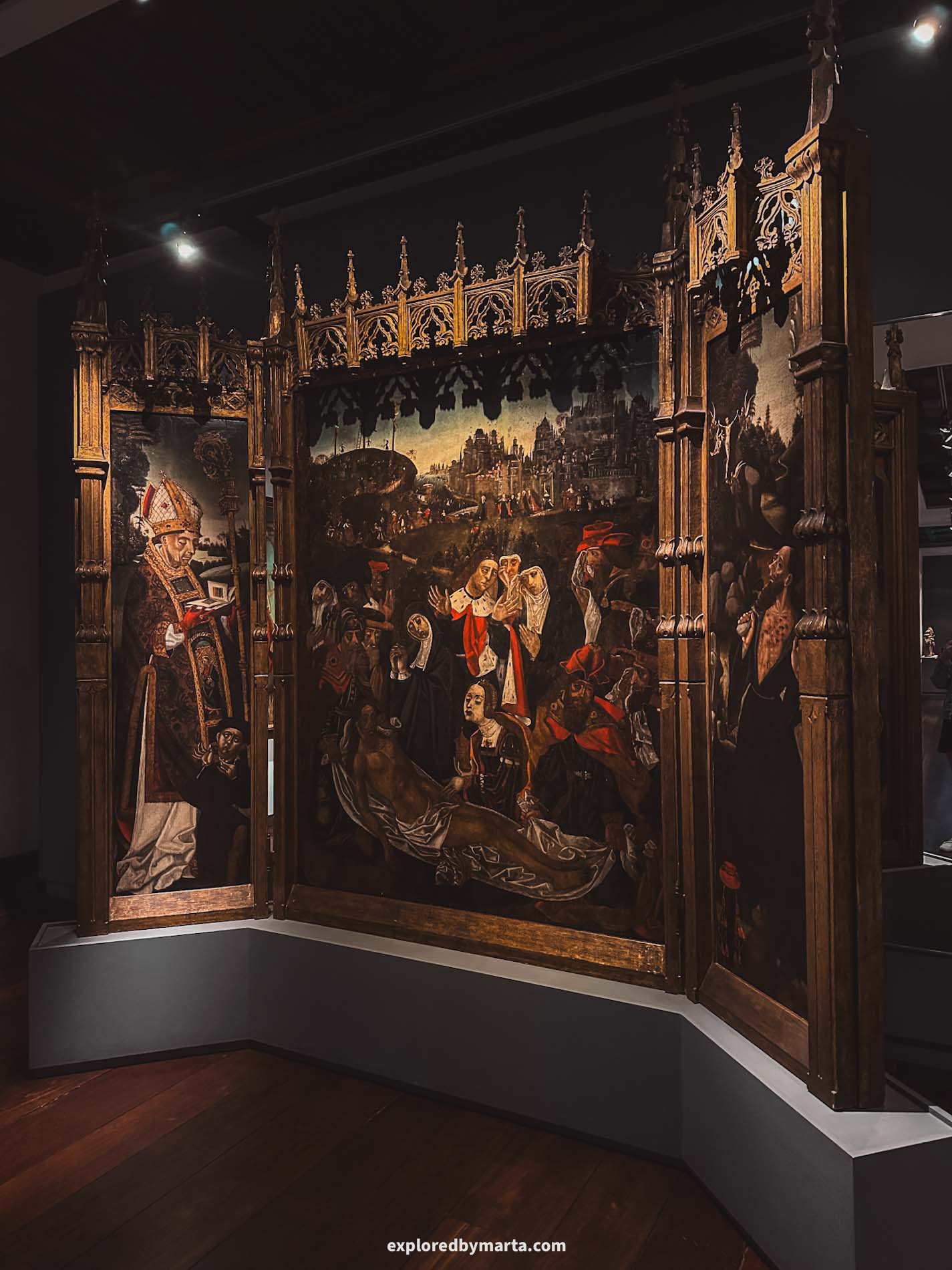
Adjacent to the main church is another historical place worth exploring. Especially if you are into historical places, medieval vibes, and period art, and it is Museu de Alberto Sampaio, named after a local historian.
The museum, which was opened back in 1928, is housed inside a former 12th-century monastery, and it showcases an impressive collection of religious art and treasures.
If you find yourself in the center of Guimarães in the middle of the summer heat with some extra time to spare, this is probably the best place to hide away and cool down, haha!
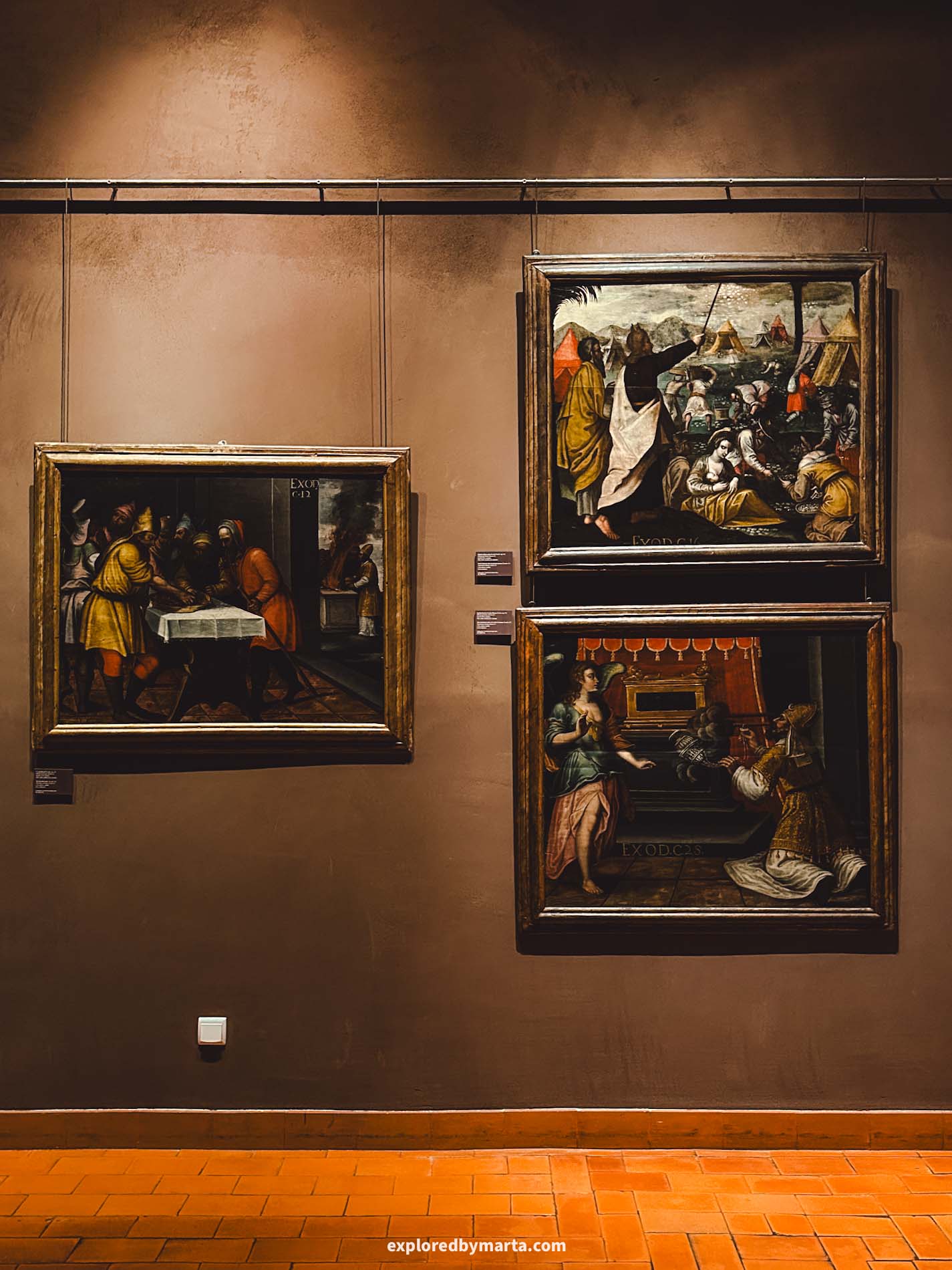
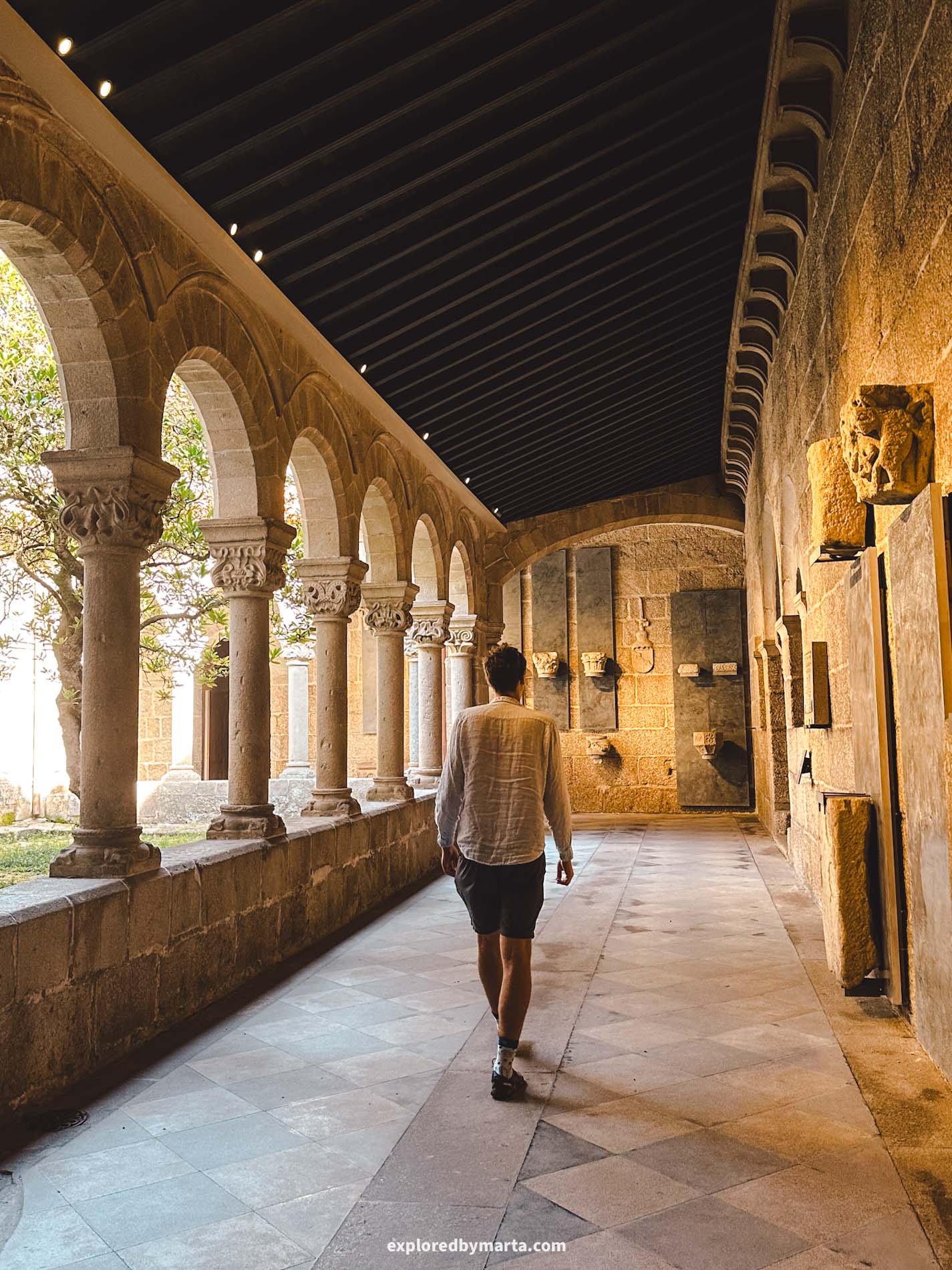
For a couple of euros entrance fee, you’ll be able to stroll through a beautiful cloister and a series of rooms downstairs as well as on the upper floor featuring sculptures, ceramics, textiles, and silverwork dating back to the Middle Ages.
Some highlights of the museum include personal belongings of Alfonso Henriques, the first king of Portugal, as well as other historically significant items connected to the beginnings of the country.
The museum offers a glimpse into the beginnings of the country through a keyhole, so to speak.
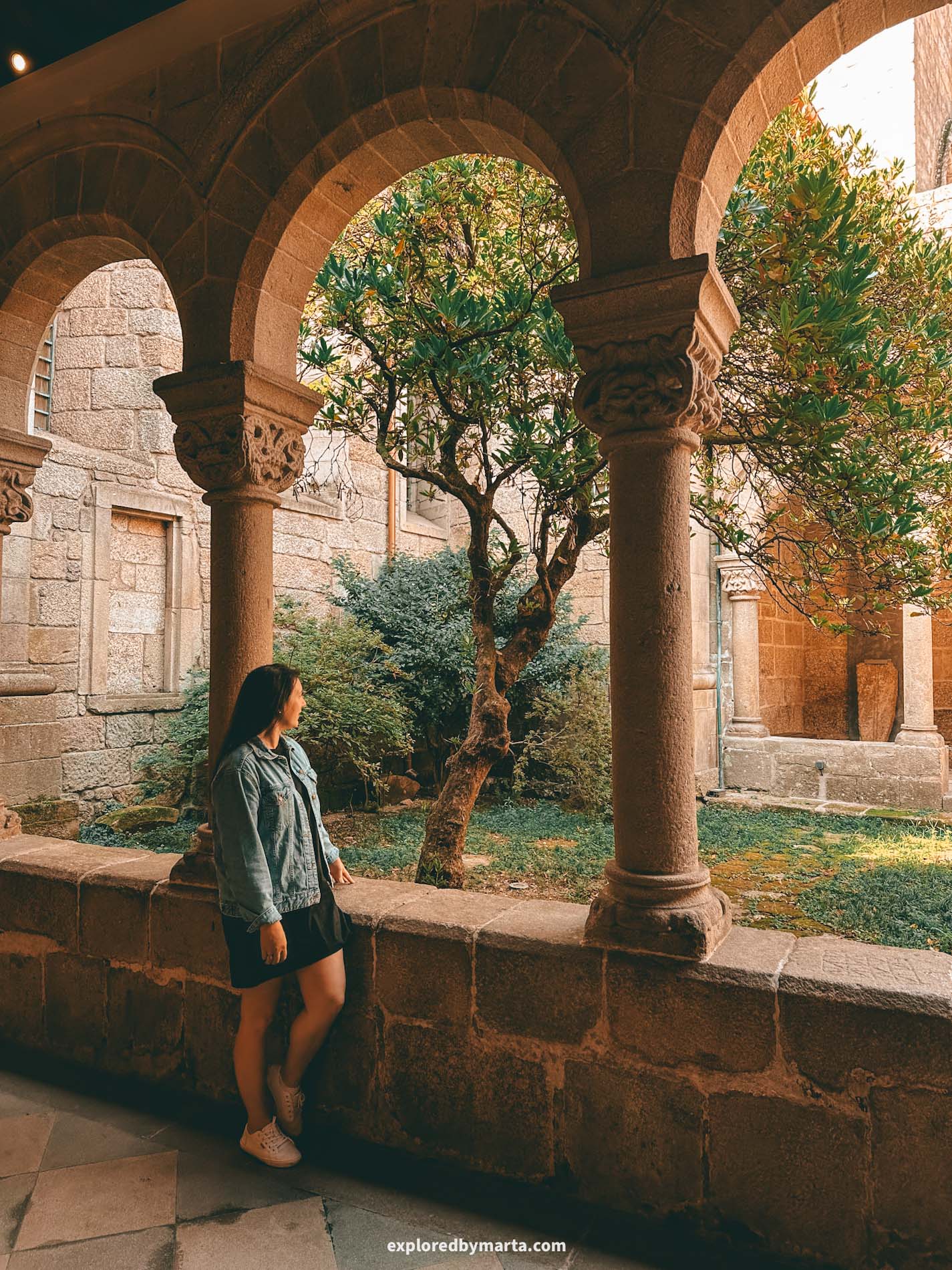
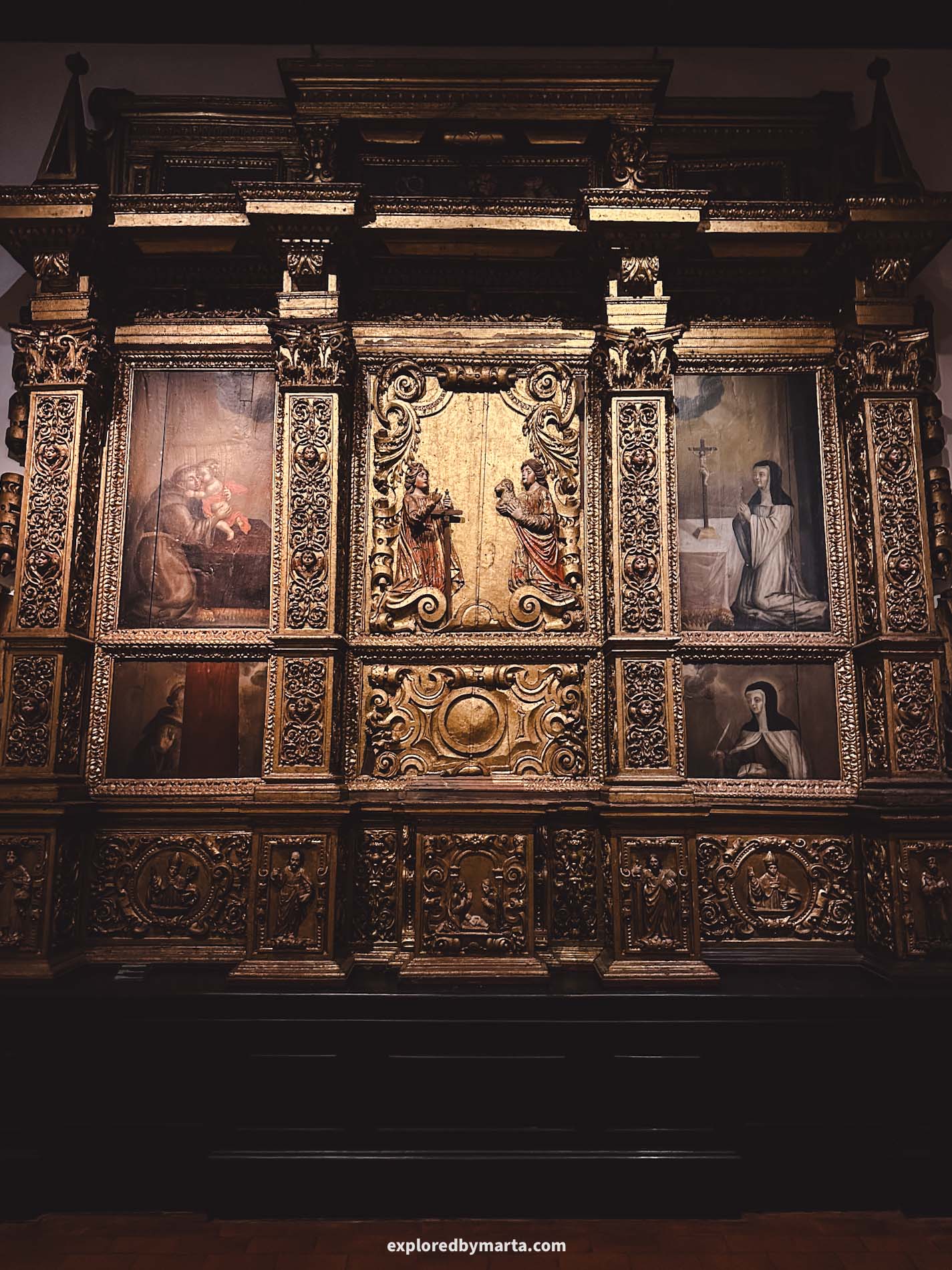
What I liked most about it was how quiet it is compared to the busy square right outside, haha! Such a peaceful oasis!
It is not a big museum and, to be honest, it is not for everyone. My husband said right away that he would not come here if it weren’t for me, haha!
But if you enjoy historical artifacts, religious art, period art, and medieval vibes, then go for it. We spent about 40 minutes exploring both floors and taking some photos in the beautiful courtyard!
Location: Museu de Alberto Sampaio
10. Drink a glass of Vinho Verde at Praça de São Tiago
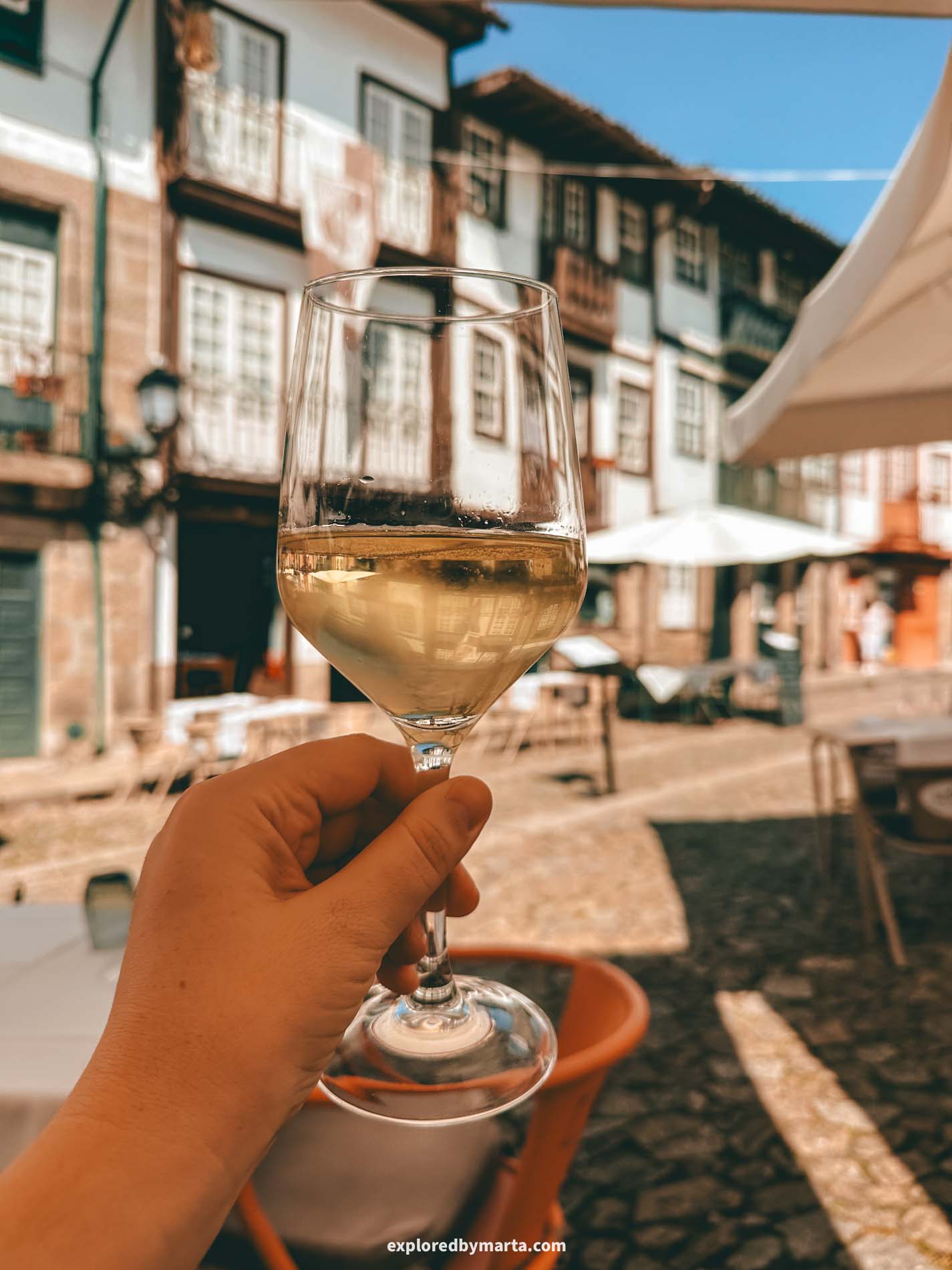
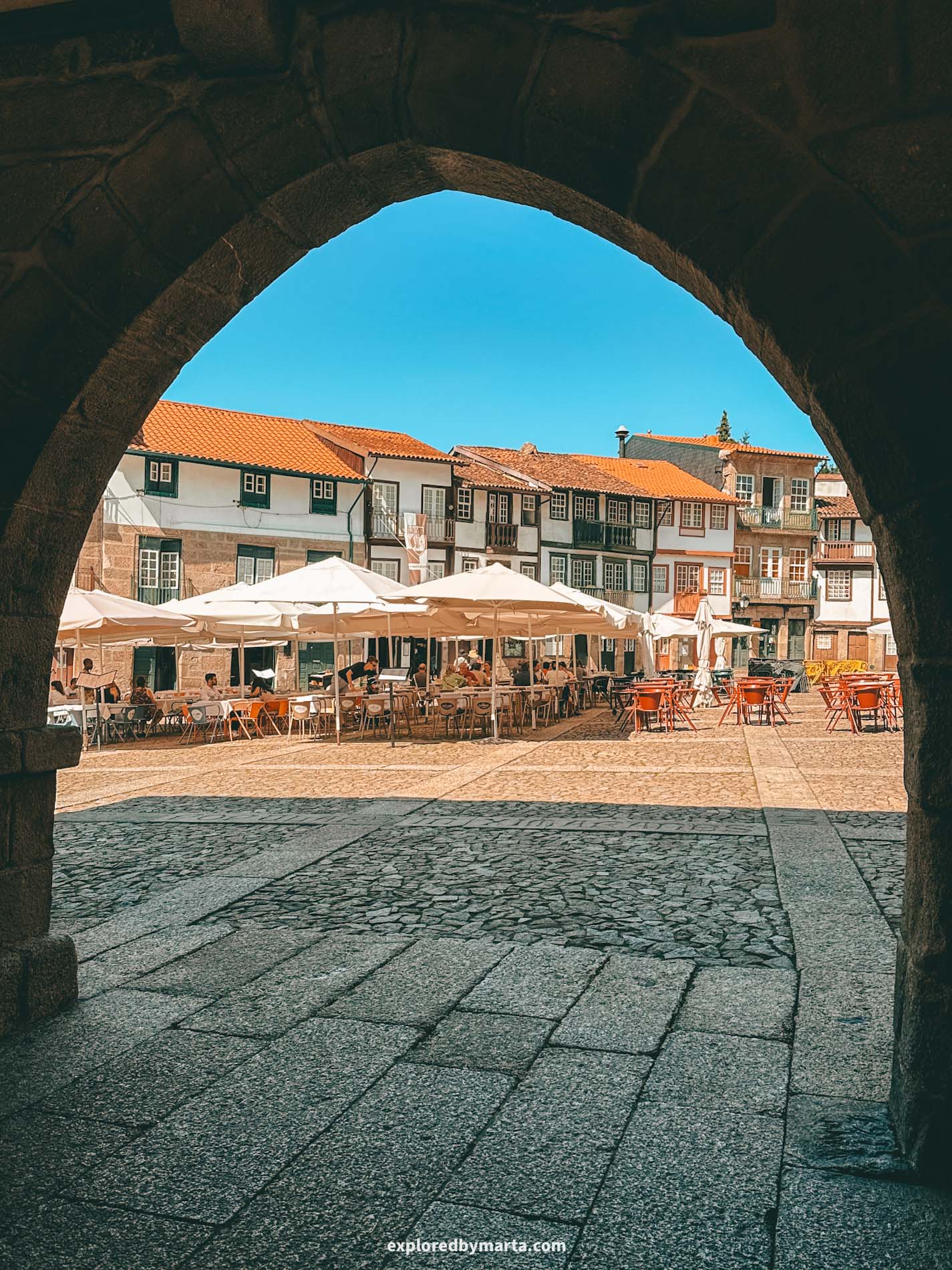
Now it’s time for one of my favorite activities when I’m traveling – eating and drinking!
If you happen to stay in Guimarães until lunch time, you cannot leave this town without sipping a glass of the local Vinho Verde wine, while sitting in one of the old town’s squares.
While Largo da Oliveira square is a great place to do that, it often is overrun with tourists, so I recommend walking over to its adjacent square – Praça de São Tiago, one of the most charming and beautiful squares in Guimarães.
This square has been a social hub for centuries, and historically it has been one of the pilgrims’ gathering spots before continuing the famous Camino de Santiago hike up north. This is how the square got its name – São Tiago = Santiago.
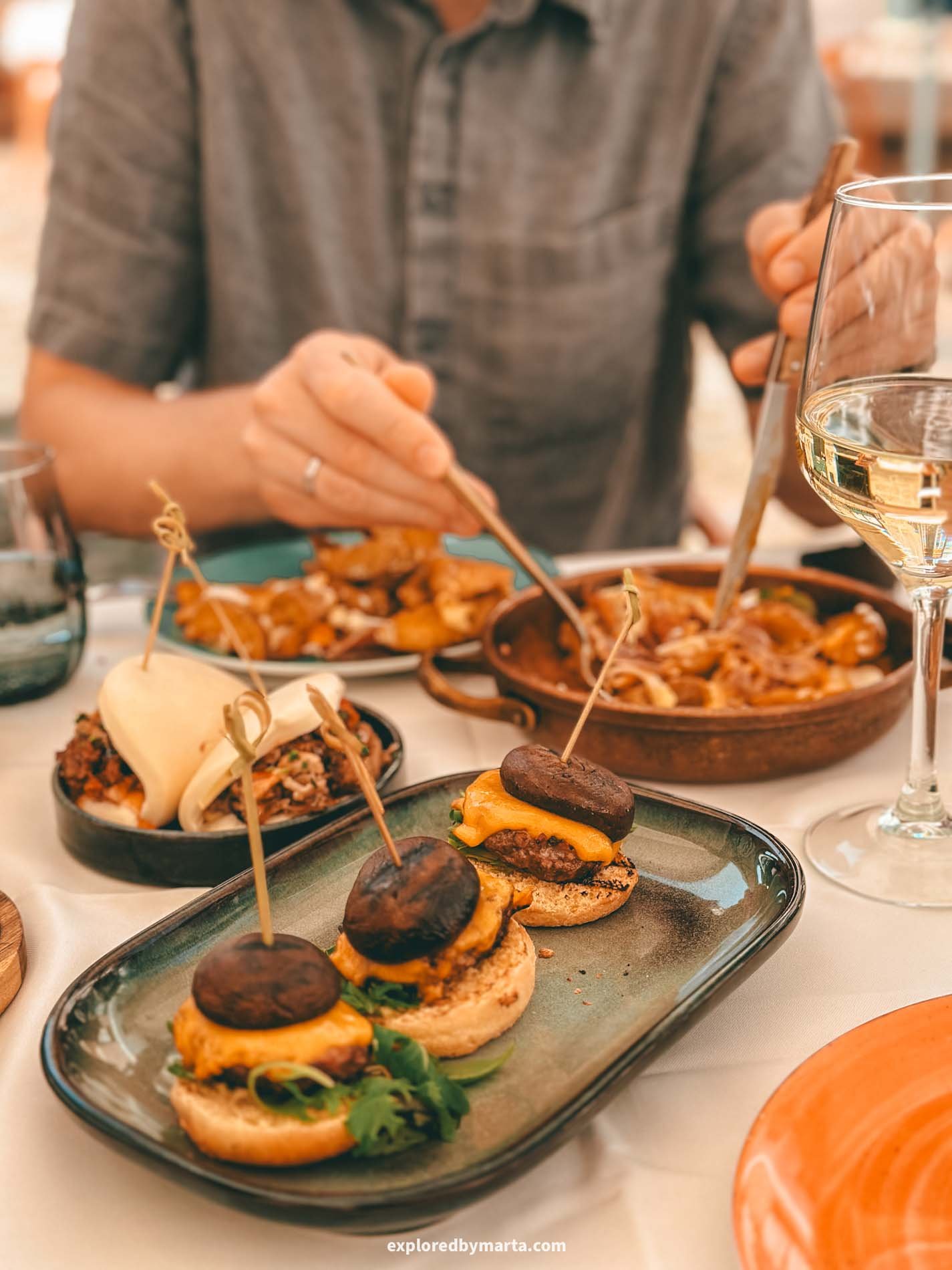
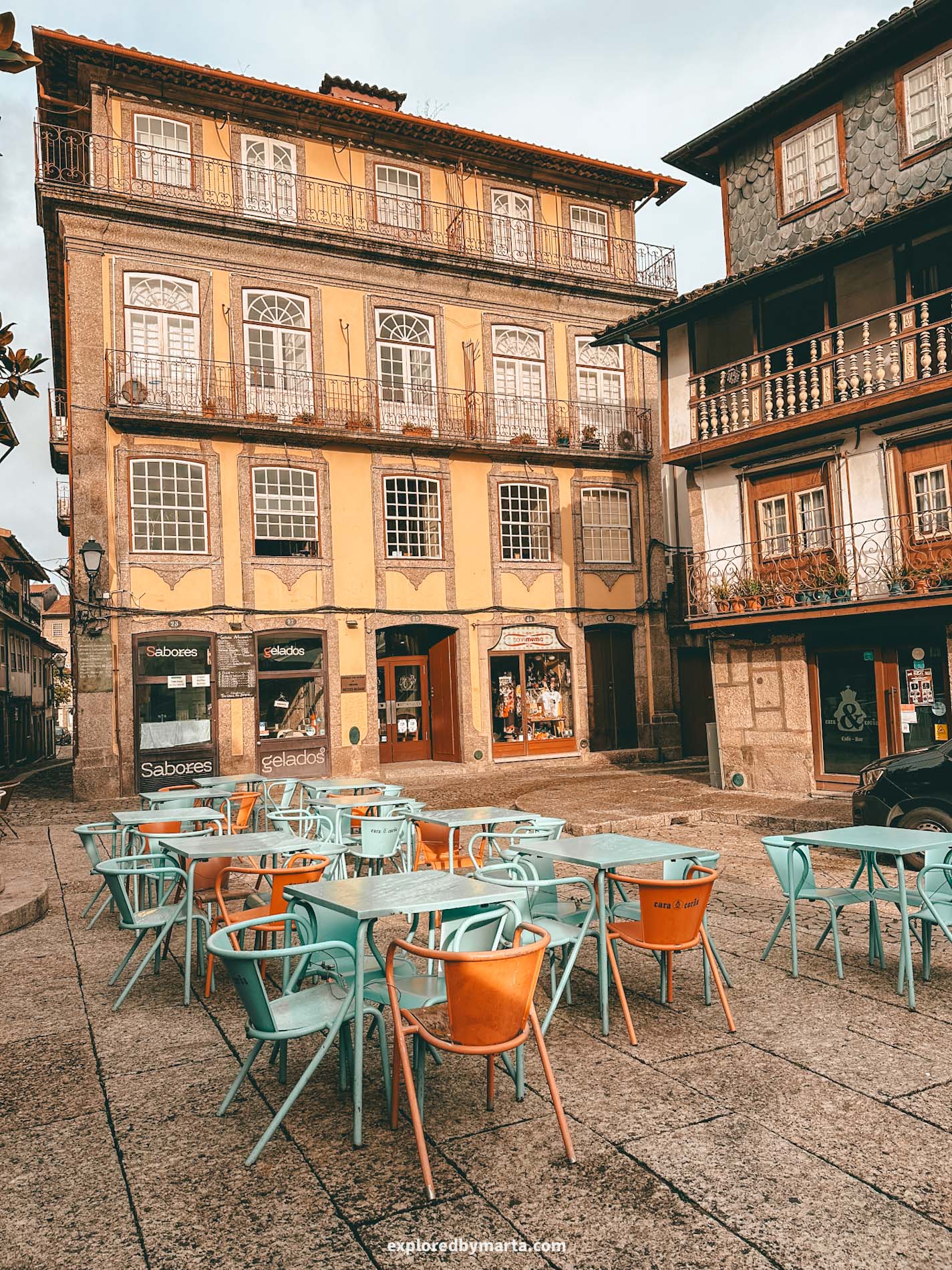
We came here around lunchtime and walked around, choosing a tapas restaurant. There are many bars and restaurants to choose from, but we opted for Amu.Te and ordered various Portuguese tapas and a glass of the famous Vinho Verde.
Vinho Verde wine is a light, crisp, fresh wine that comes from the Minho region, the same region where Guimarães is located, so it is a local wine, but it is known all over the country.
Vinho Verde doesn’t come from a specific grape, but rather it describes the way it is produced. Verde means that the wine is ‘green’ or young, as it is released 3 to 6 months after harvest. I quite liked its fruity freshness! The perfect afternoon drink!
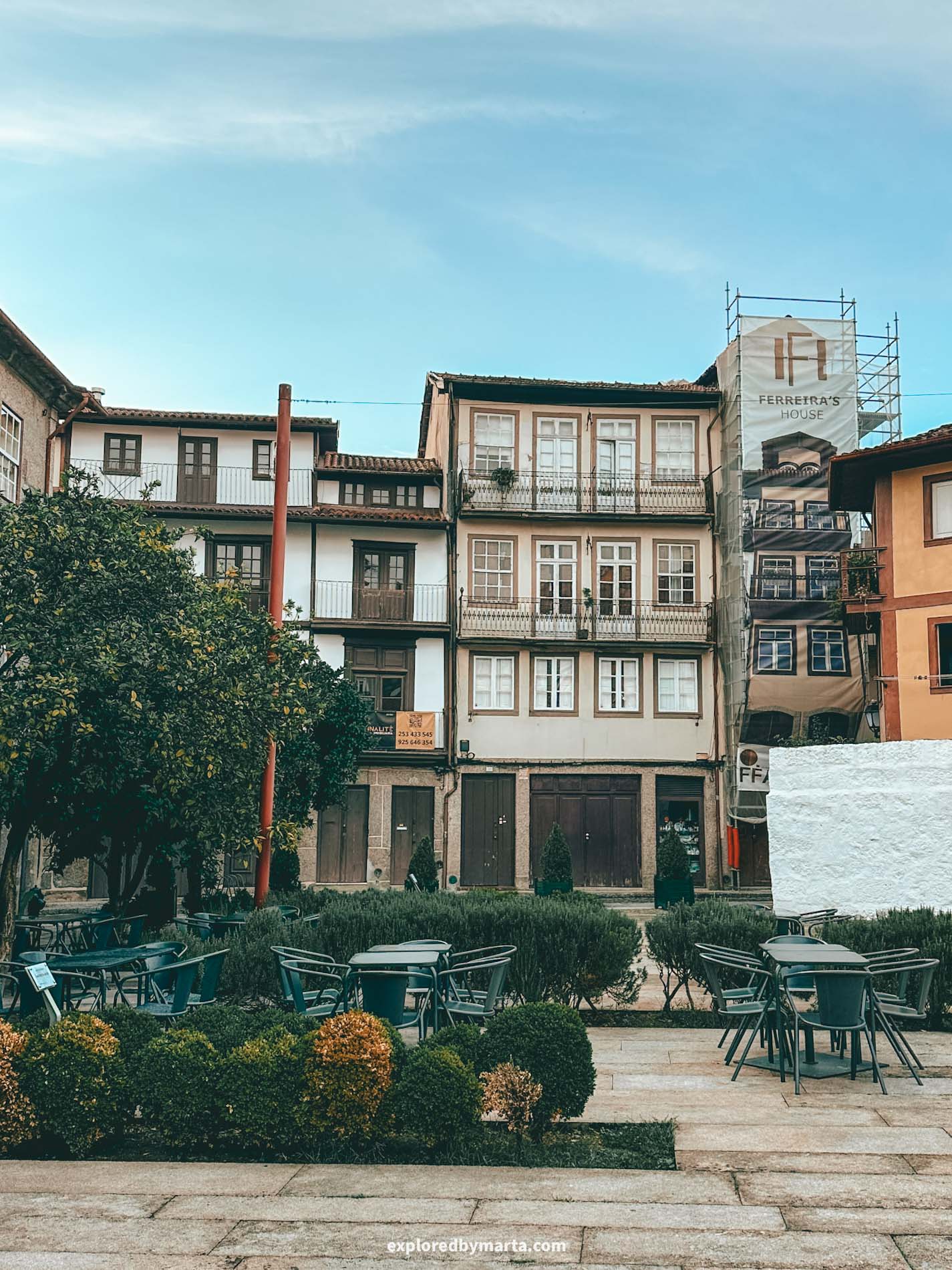
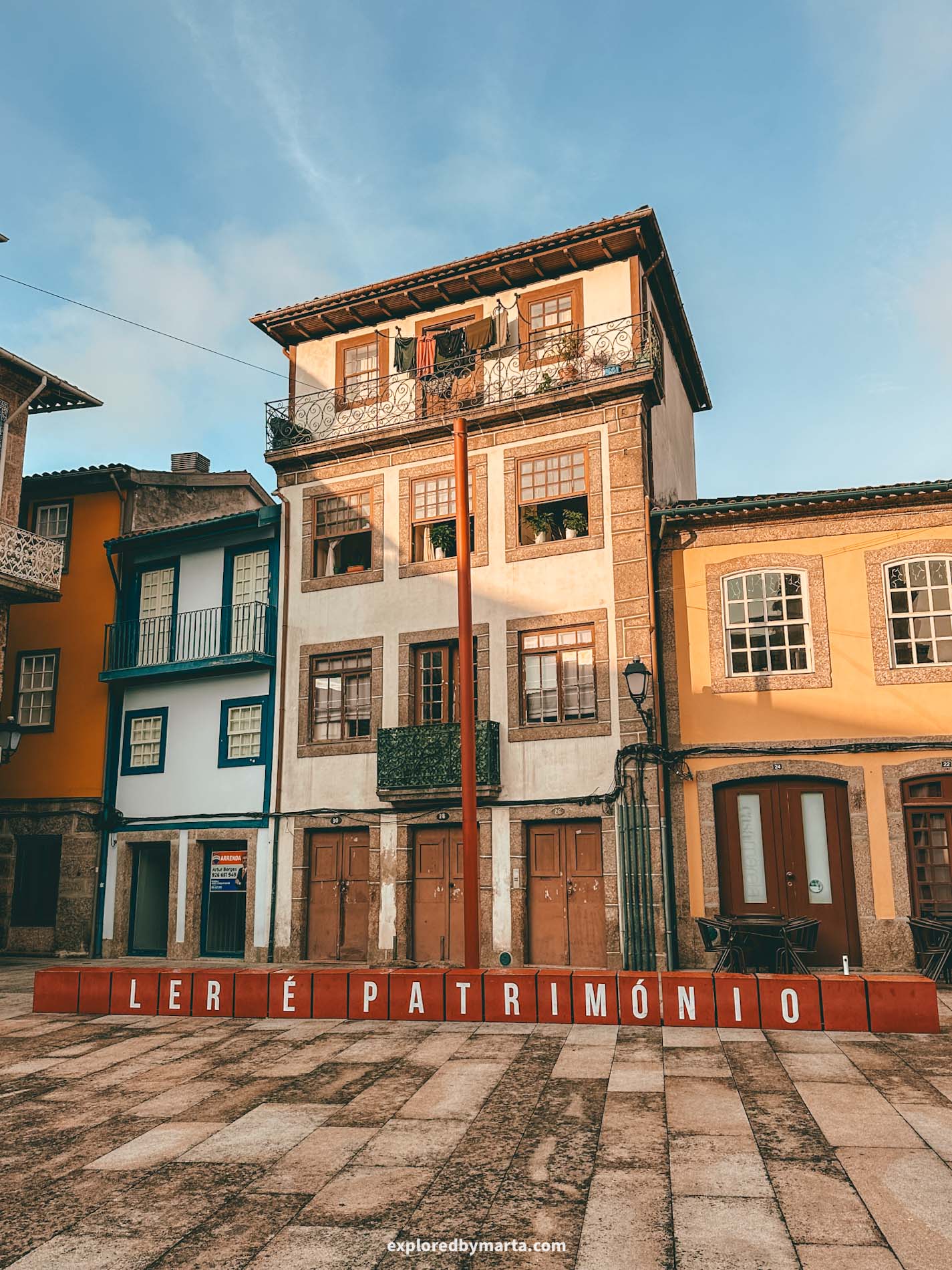
Relaxing in a square with tapas and a glass of Vinho Verde was one of my favorite things to do in Guimarães. However, Praça de São Tiago is quite a central square.
If you are looking for a quieter square for lunch or dinner, I recommend another place close by – Largo de Donães. We had our apartment windows to this square, and it was overrun with joyful laughter every evening.
No matter which place you choose, lunch or dinner in a charming medieval square is one of the best ways to experience the local atmosphere. It is just the way of doing life in this town (and in most places around Portugal)!
Location: Praça de São Tiago
11. Take a photo of the striking Largo da República do Brasil
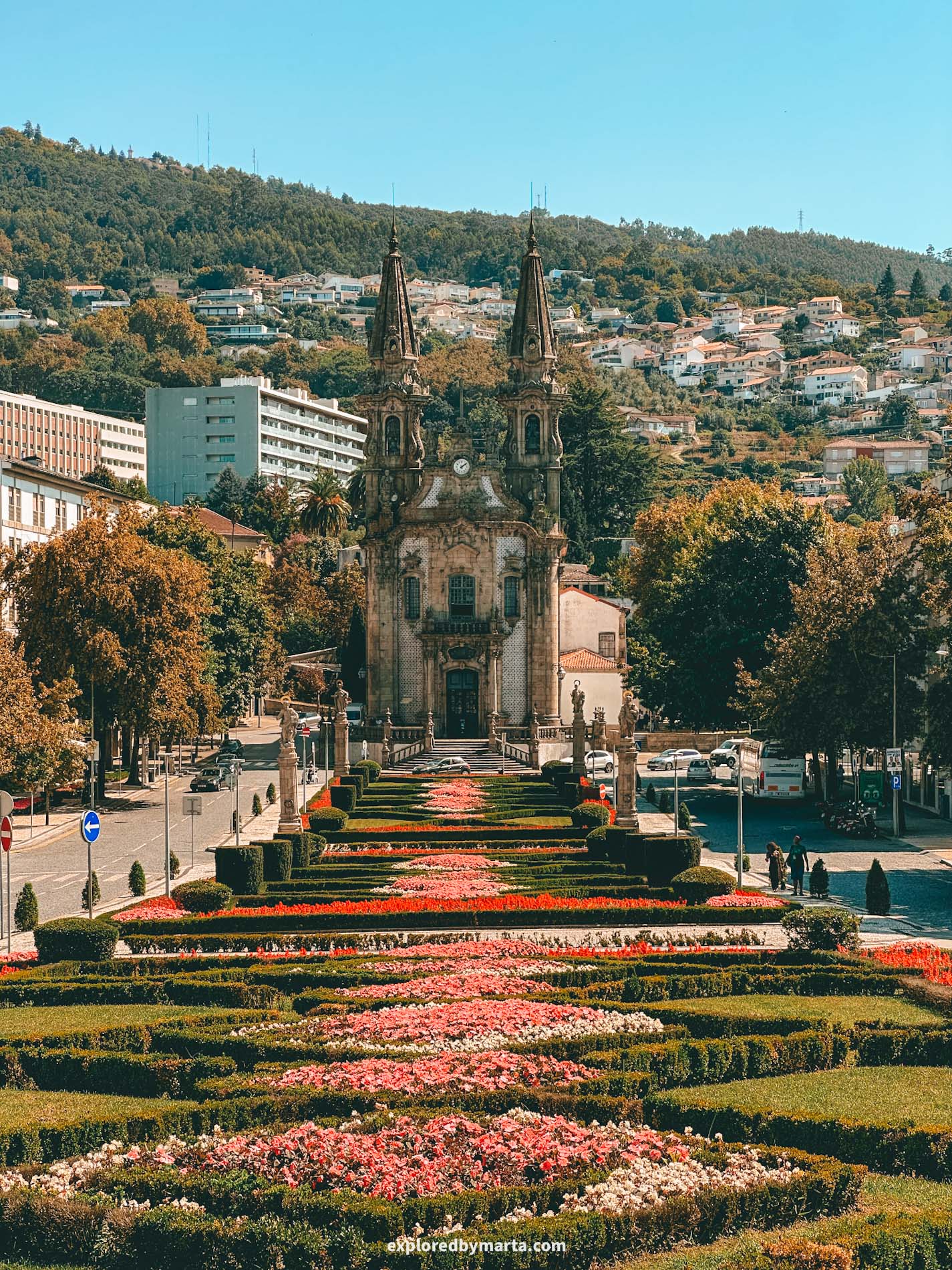
Largo da República do Brasil, the beautiful avenue with vibrant flower gardens and the striking Baroque church, Santos Passos Church, at the end of it, is one of the most iconic places to visit in Guimarães. A must-visit place in this town!
The ‘largo’ was designed in the 19th century when the town began expanding beyond the medieval walls. If you come here in spring, summer, or fall, you’ll be able to enjoy long rows of vibrant flowers in full bloom. It is one of the most photogenic views in Guimarães!
Location: Largo da República do Brasil
12. See the best view in town from Santos Passos Church
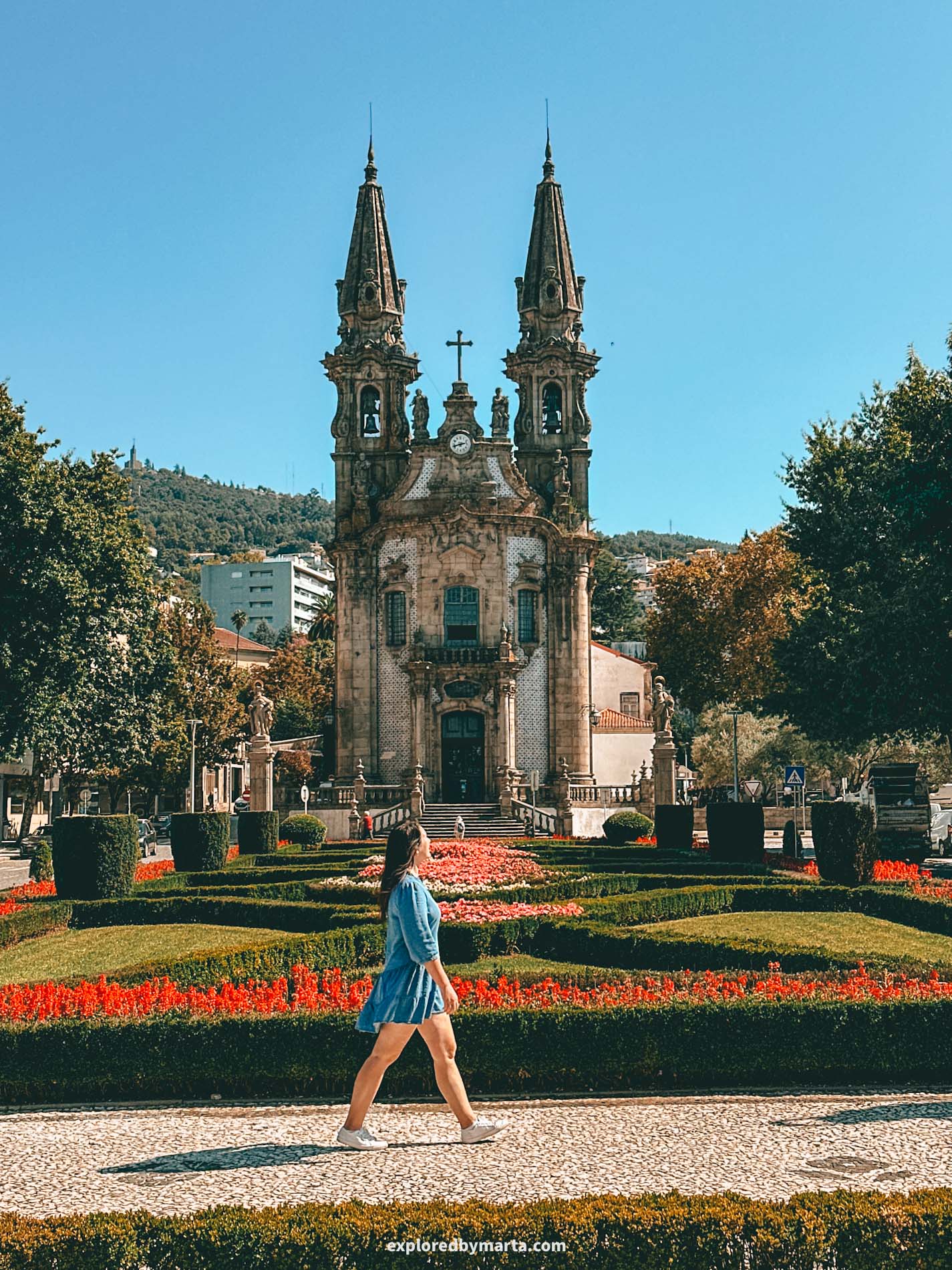
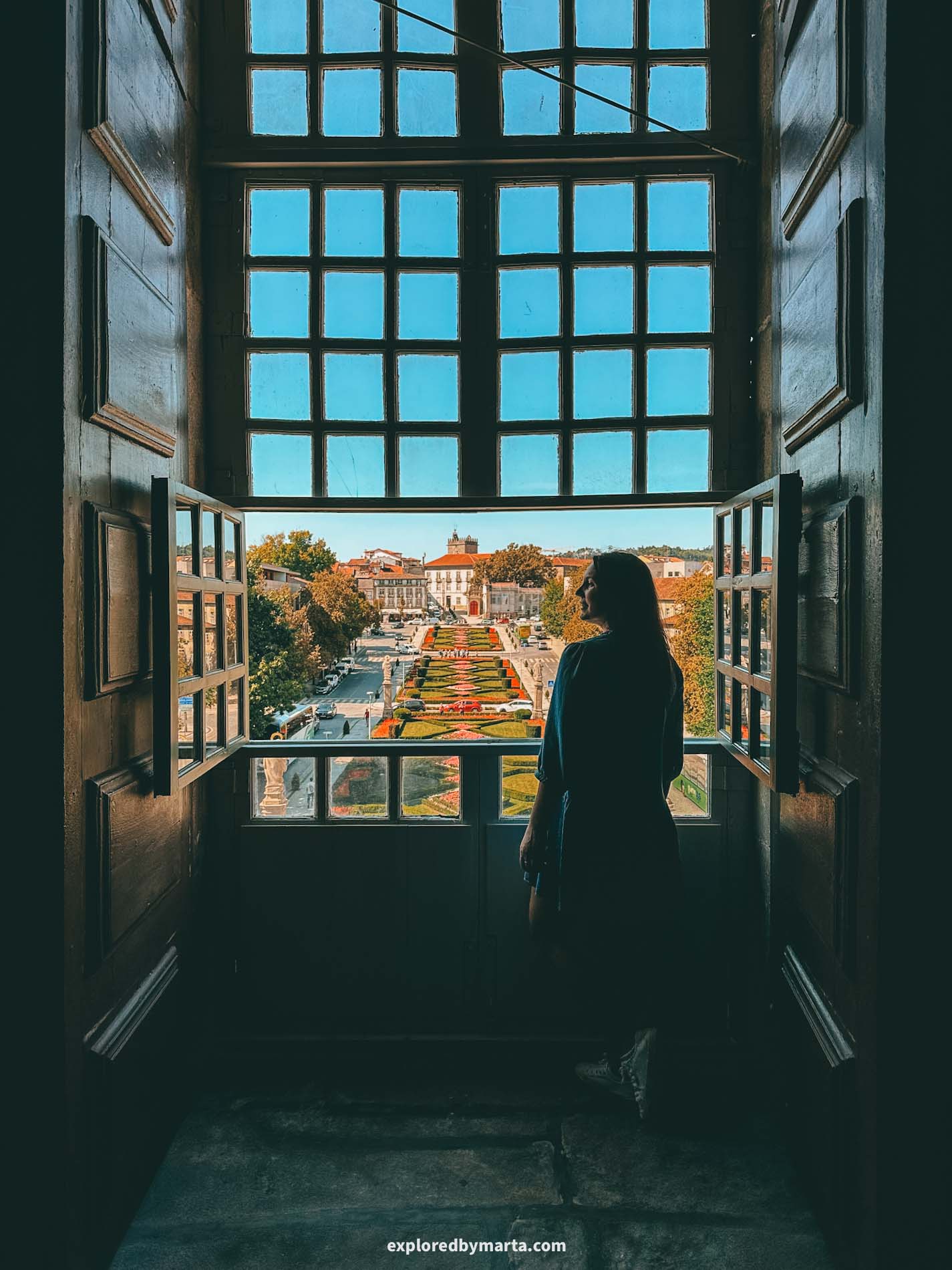
The Santos Passos Church, or Igreja e Oratórios de Nossa Senhora da Consolação e Santos Passos, is the church you see at the very end of the beautiful Largo da República do Brasil avenue.
Seeing the garden with the church at the end is one thing, but I highly recommend walking all the way along the avenue and visiting the church! It is one of the most iconic churches in Portugal!
Entrance to the church is free, but there is a secret spot you need to know about.
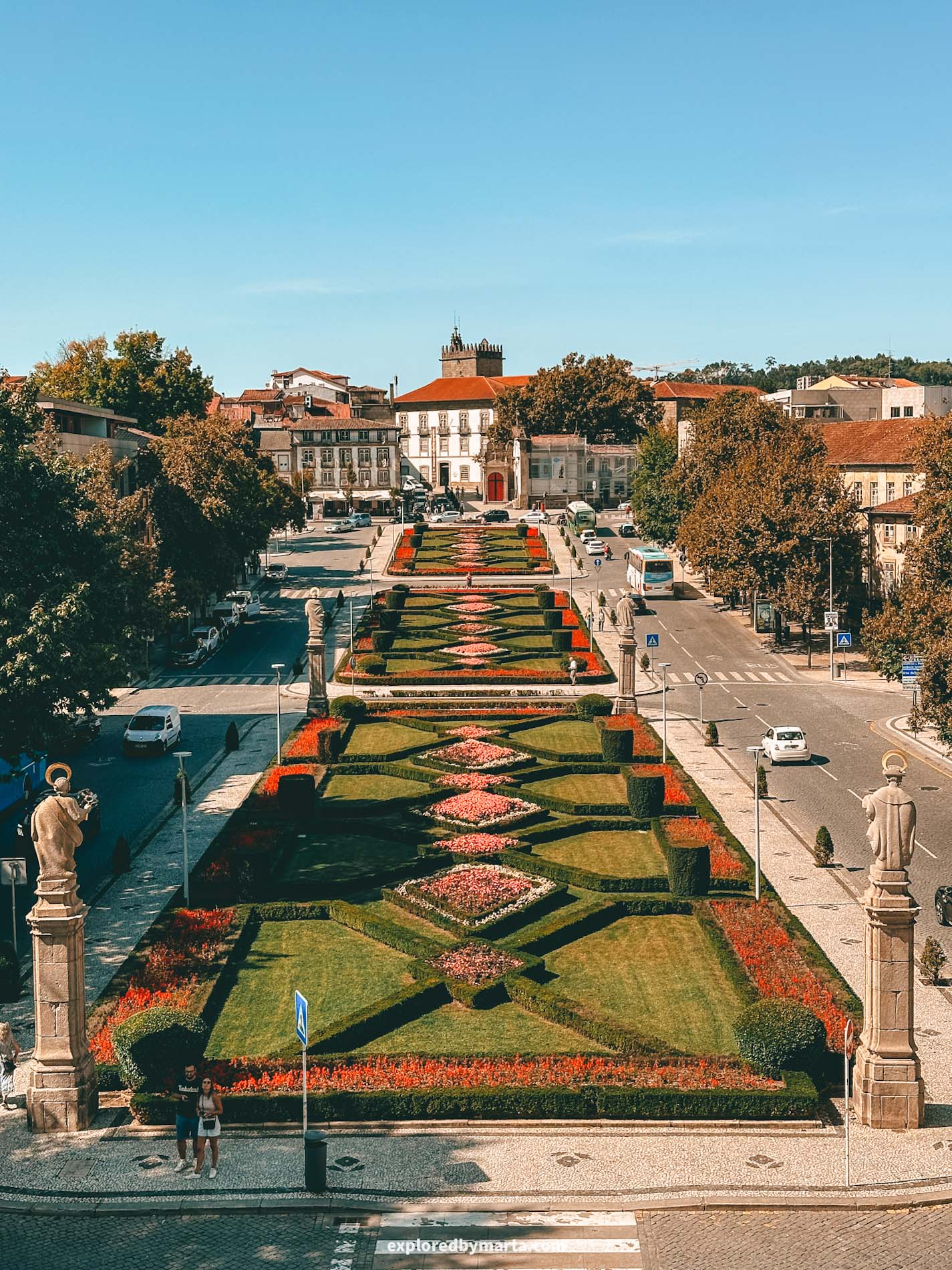
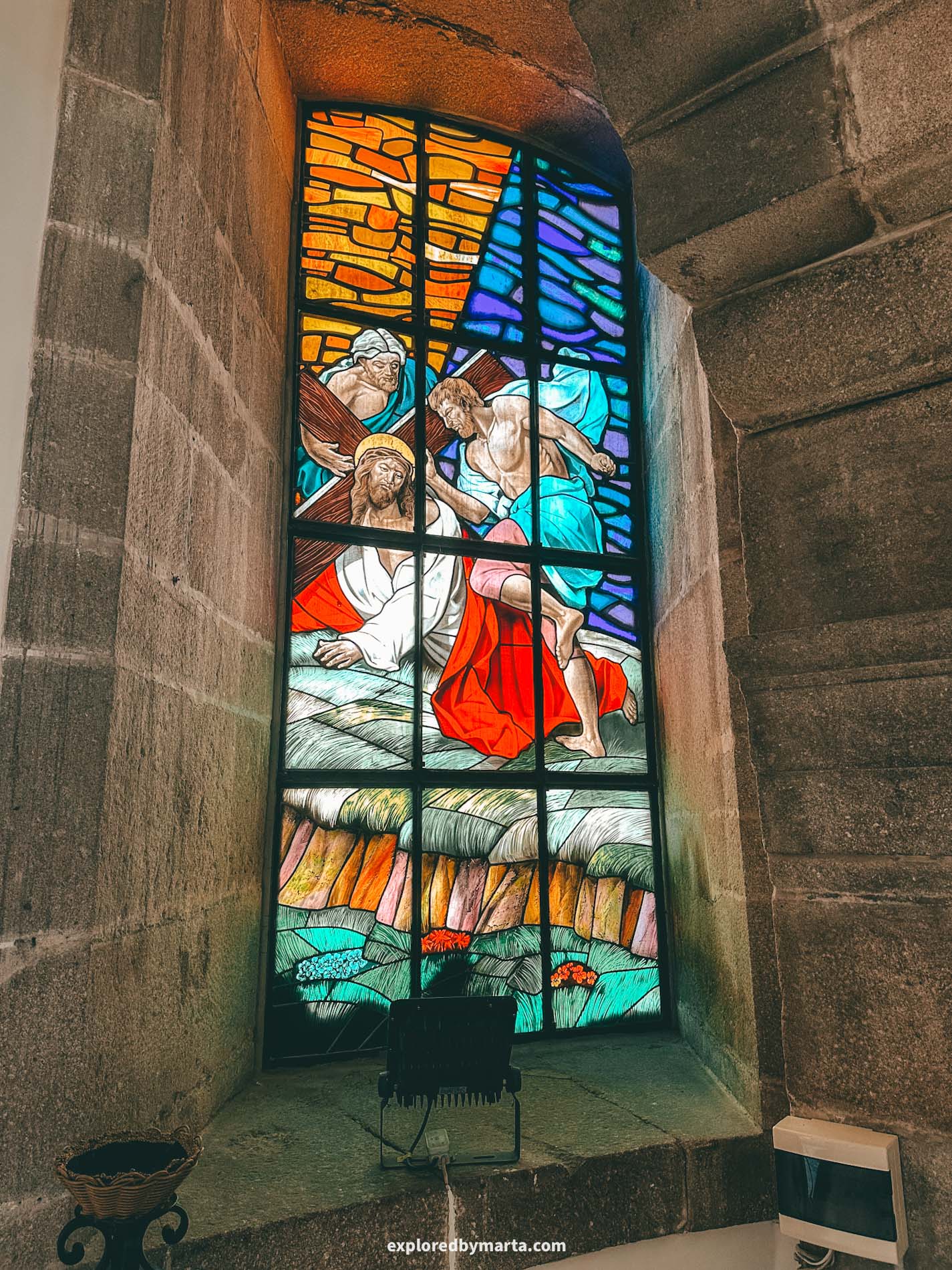
Advertised as the best and most beautiful view in Guimarães, is an option to climb up to the upper floor of the church and see the view of the beautiful avenue from the church’s perspective.
When we visited, they asked for a 1 EUR donation to be able to climb to the upper floor, so we didn’t think twice and got up there. The view was very beautiful. I love seeing places from above, so this was one of my favorite things to do in Guimarães!
Now I don’t know which view I liked best – the one looking from the old town with the church at the end of the avenue, or the view from this church and the Guimarães old town in the background.
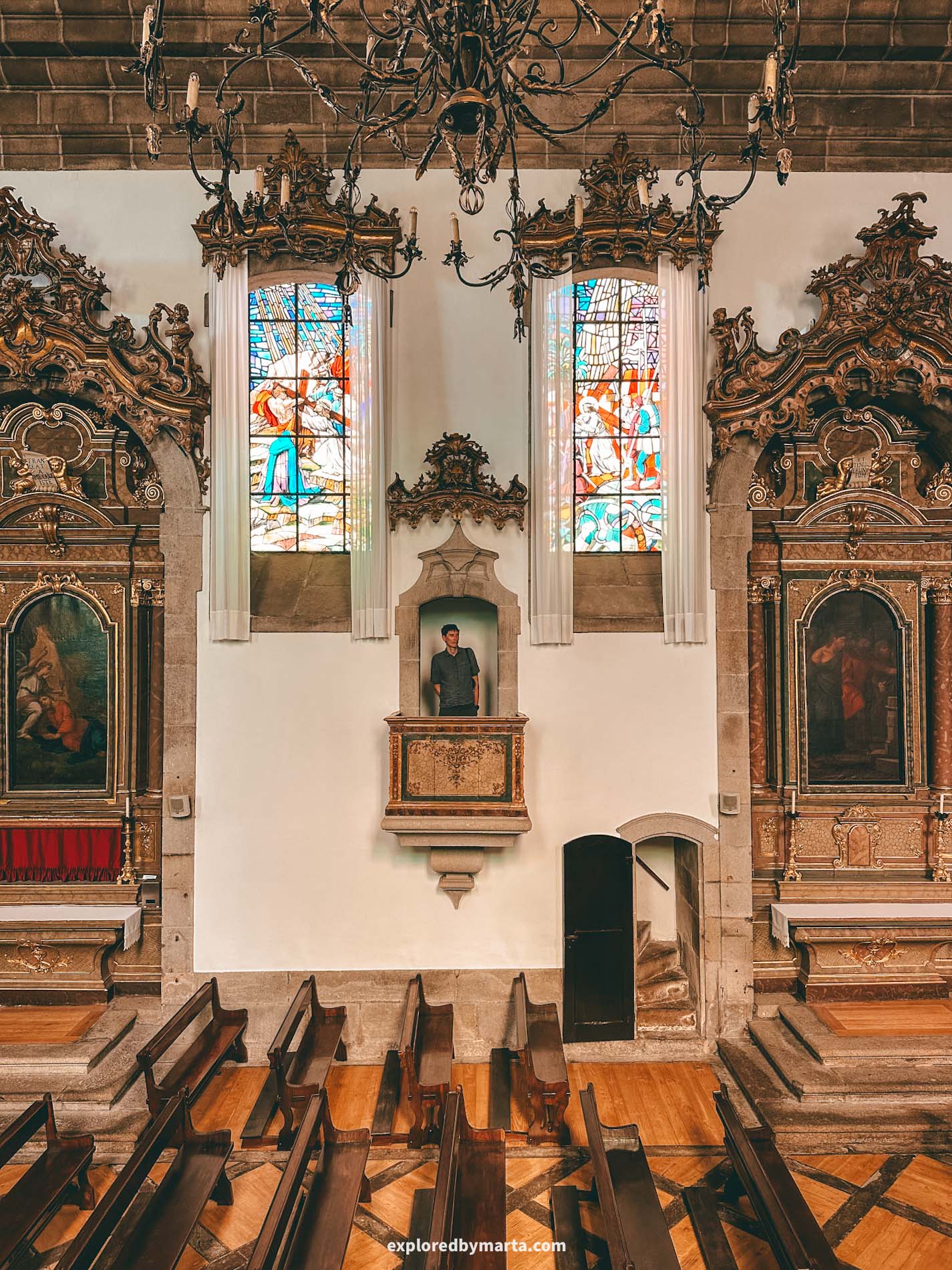
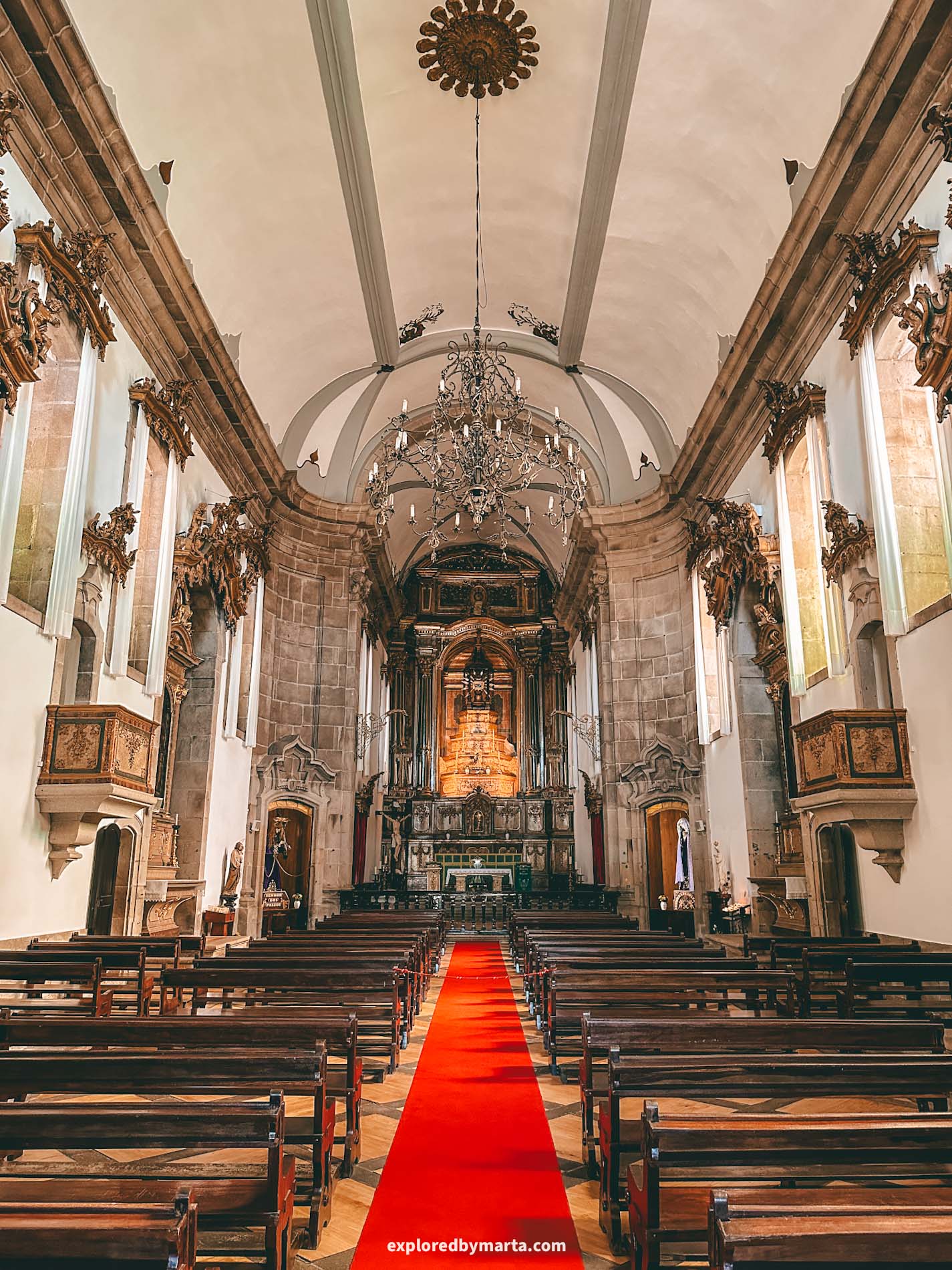
We spent a few minutes admiring the view and then continued on to explore the church. It is a beautiful 18th-century church proudly displaying the Baroque architectural style.
The kind host of the church made sure we got to see all of the church, including climbing up to the pulpits, the tiny balconies along the church’s walls.
The church has a single nave and beautiful altars. It isn’t the most spectacular church you’ll ever see, but it has its own beauty for sure. If you have a couple of minutes to spare, I definitely recommend visiting this place!
Location: Santos Passos Church
13. Explore the old leather tanneries, or tanques de couros
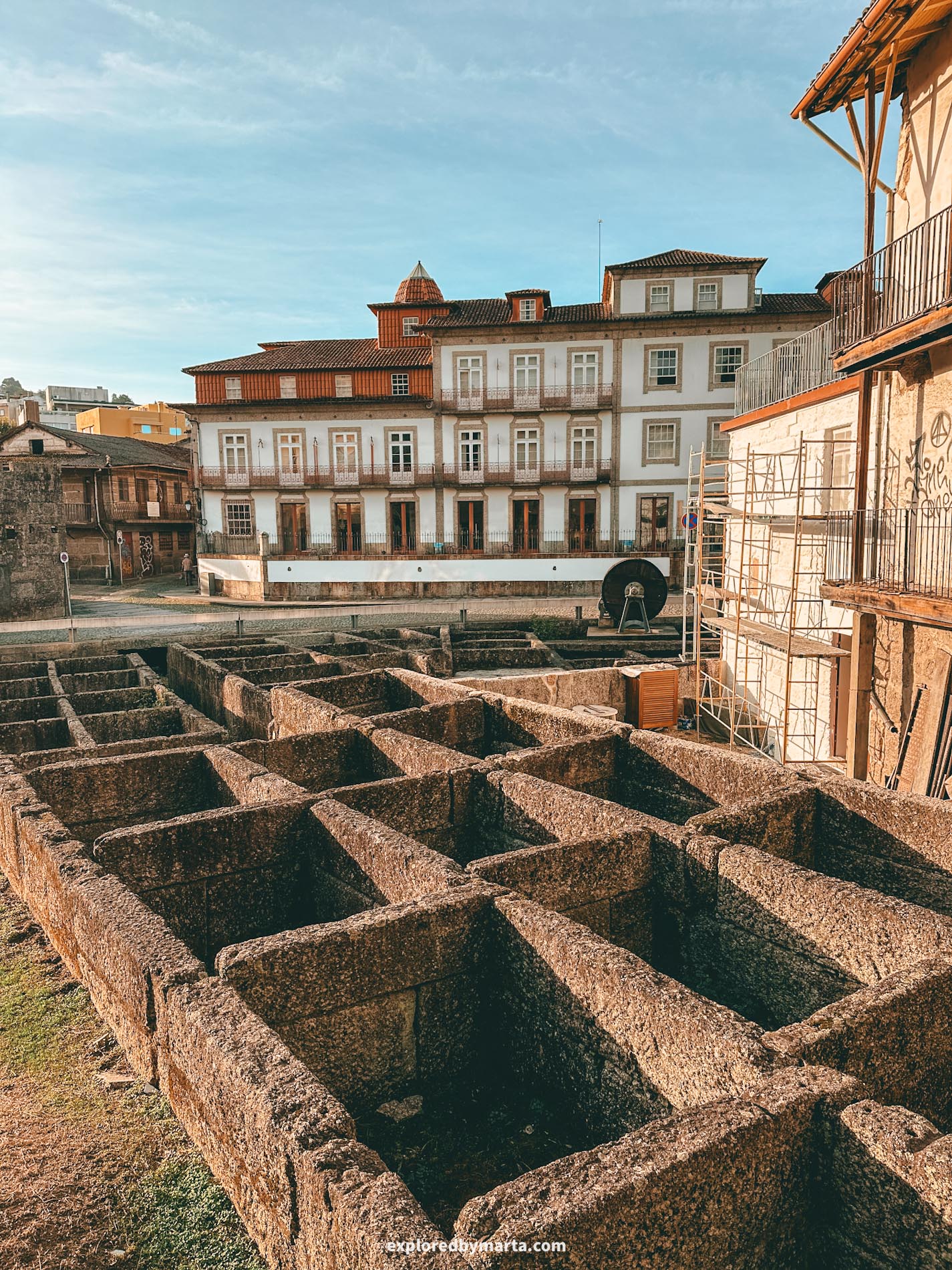
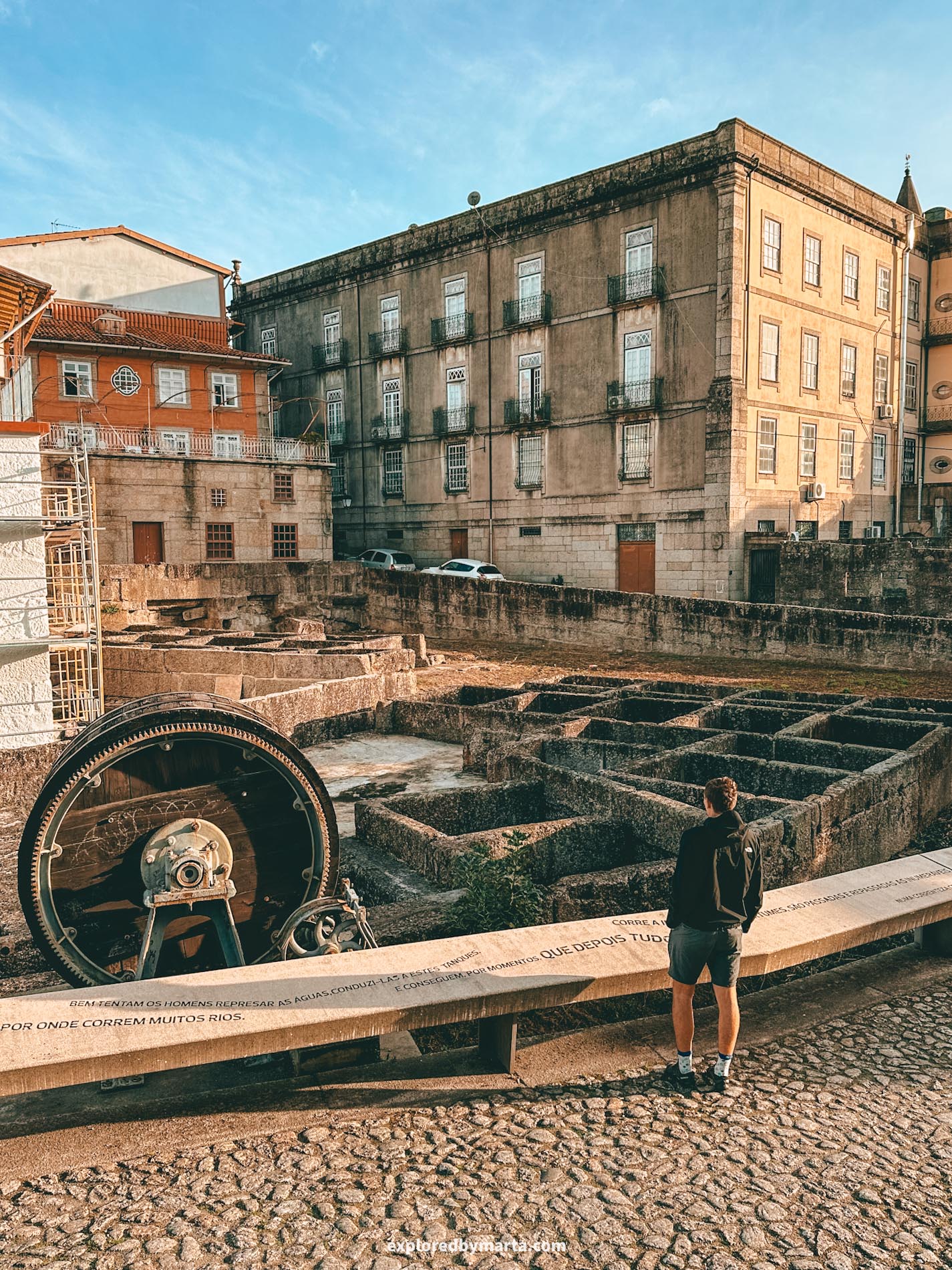
Located just outside the old city walls of Guimarães is a unique area known as the Tanques de Couros, or Leather Tanks. This small neighborhood preserves the remains of the once-popular tanning industry that used to be a big part of the town’s economy.
The leather tanning industry in Guimarães dates back to the Middle Ages, when local artisans used these stone water tanks and flowing water to soak, wash, and dye animal leather, and then turned it into a material used to make shoes, belts, and clothes.
To be honest, you can find these leather tanks in many places around this neighborhood. However, the one we visited (the one in the photos) is the best place to go to see them.
You can visit this place for free. There are no working hours, it is just out in the open, and you can pass by this place at any time of the day.
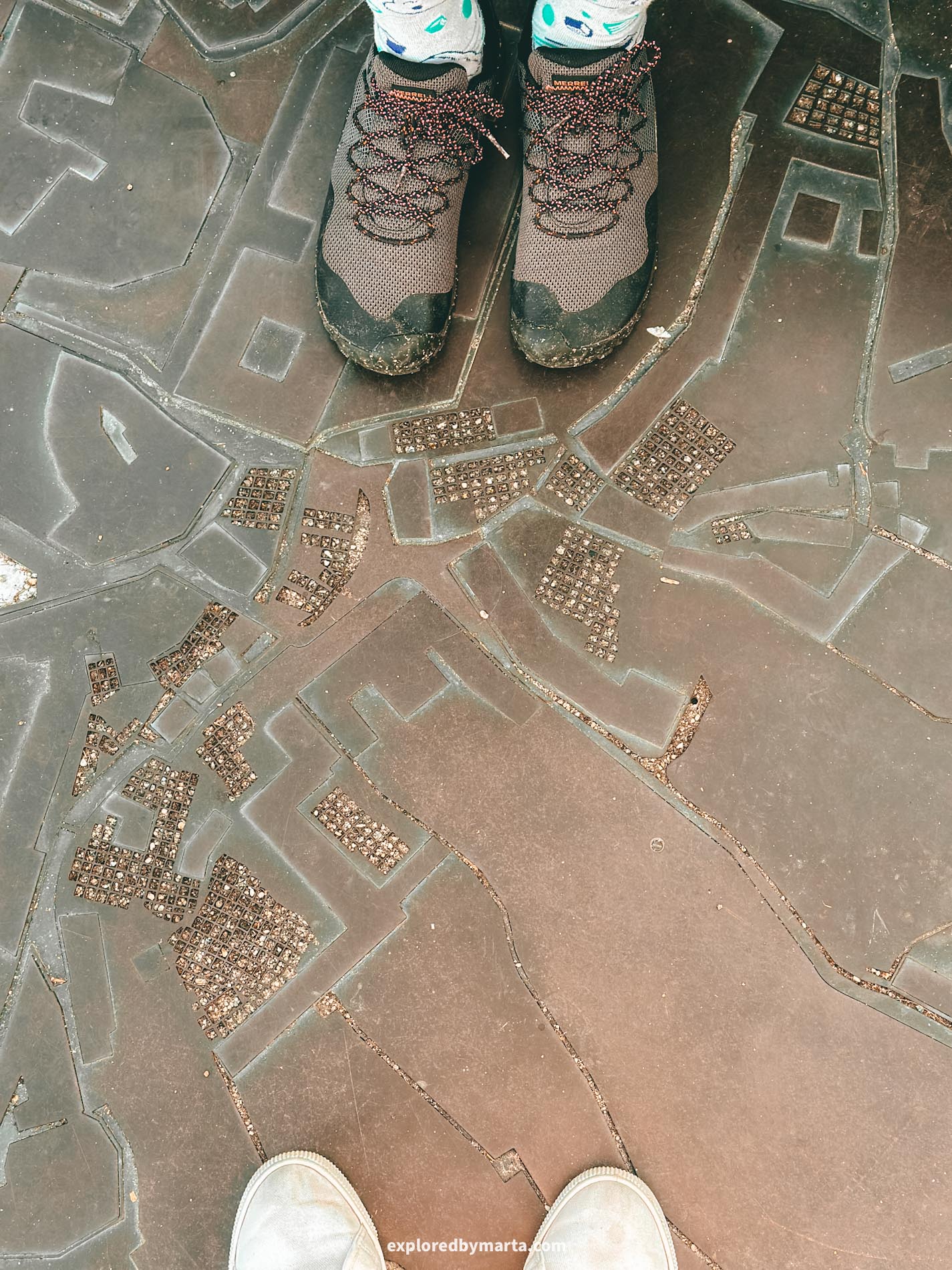
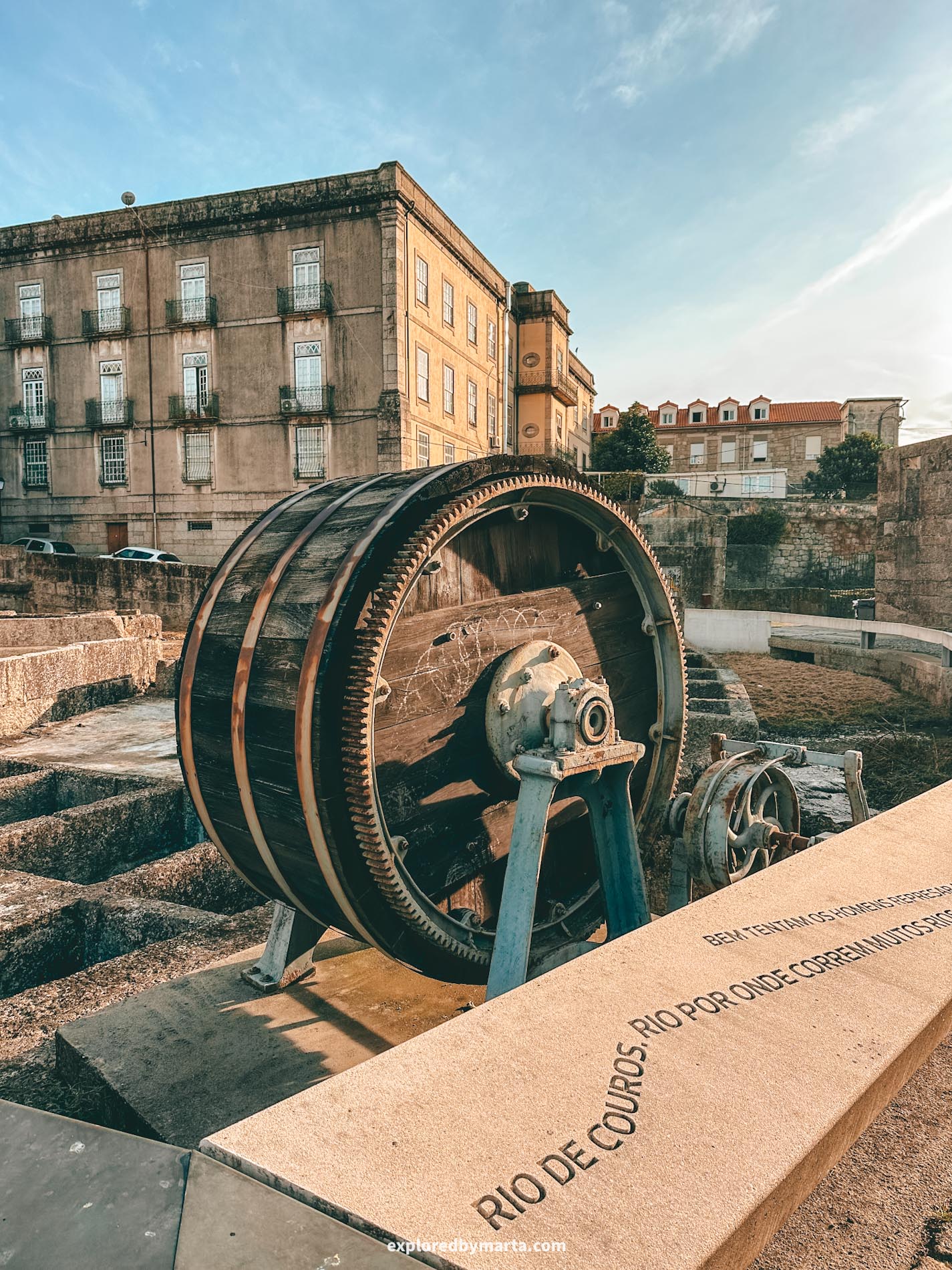
It is not the most impressive attraction in Guimarães, however, it’s quiet, authentic, and full of character, especially compared to the busier medieval squares in the town center.
The last tannery in this neighborhood shut its doors in 2005, which marked the end of an era that lasted in Guimarães for almost a millennium. In September 2023, it officially became a UNESCO World Heritage Site as an extension of Guimarães’ historic center.
I liked this seemingly insignificant place. We, as tourists, mostly visit castles, palaces, and grand cathedrals that were built for rich people and the upper classes, but these tanneries are something that displays the everyday life of regular people in this city.
If you have time, do pass by this place!
Location: Tanques de Couros
14. Admire the grandeur of the Church of Saint Francis
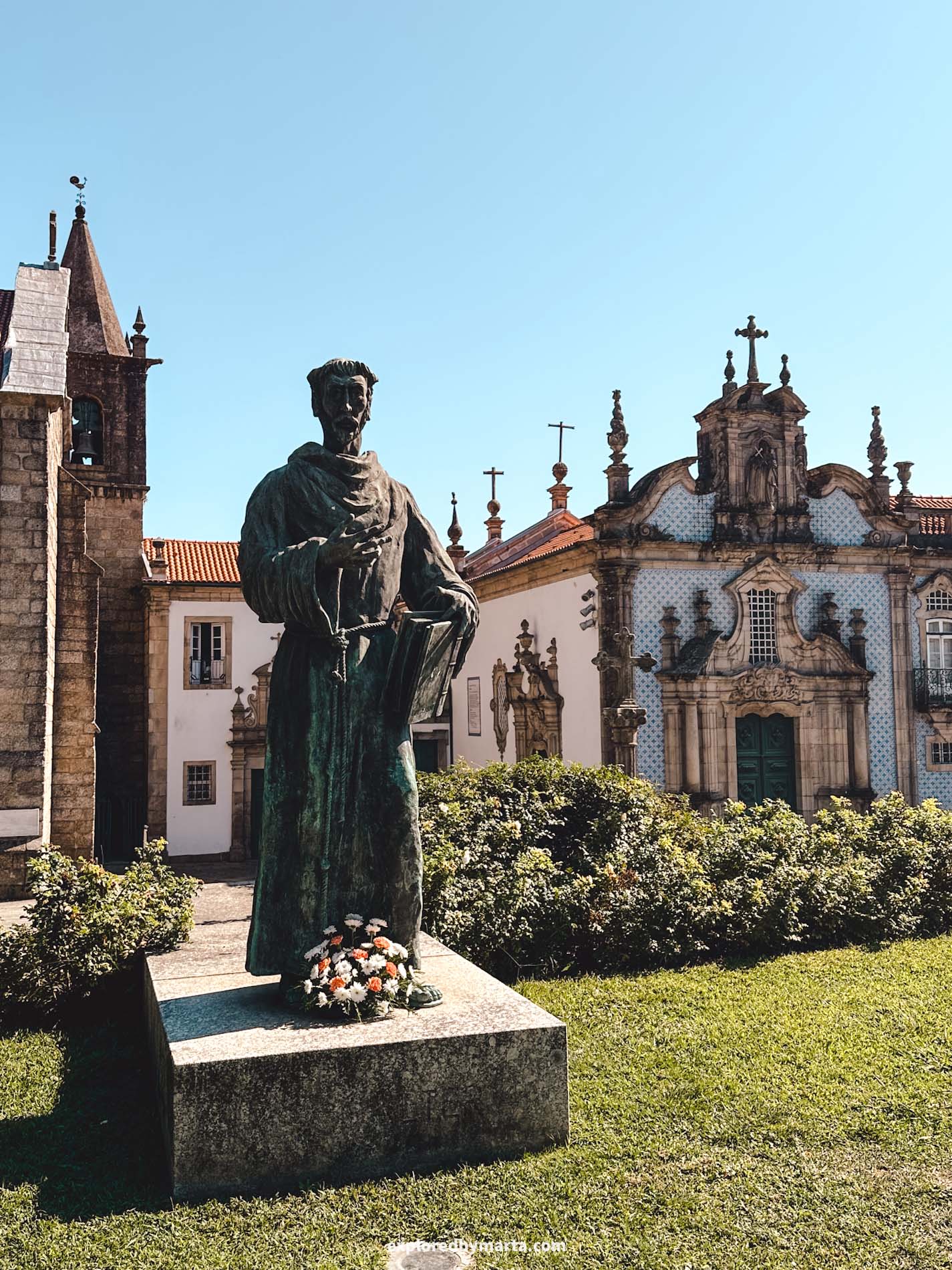
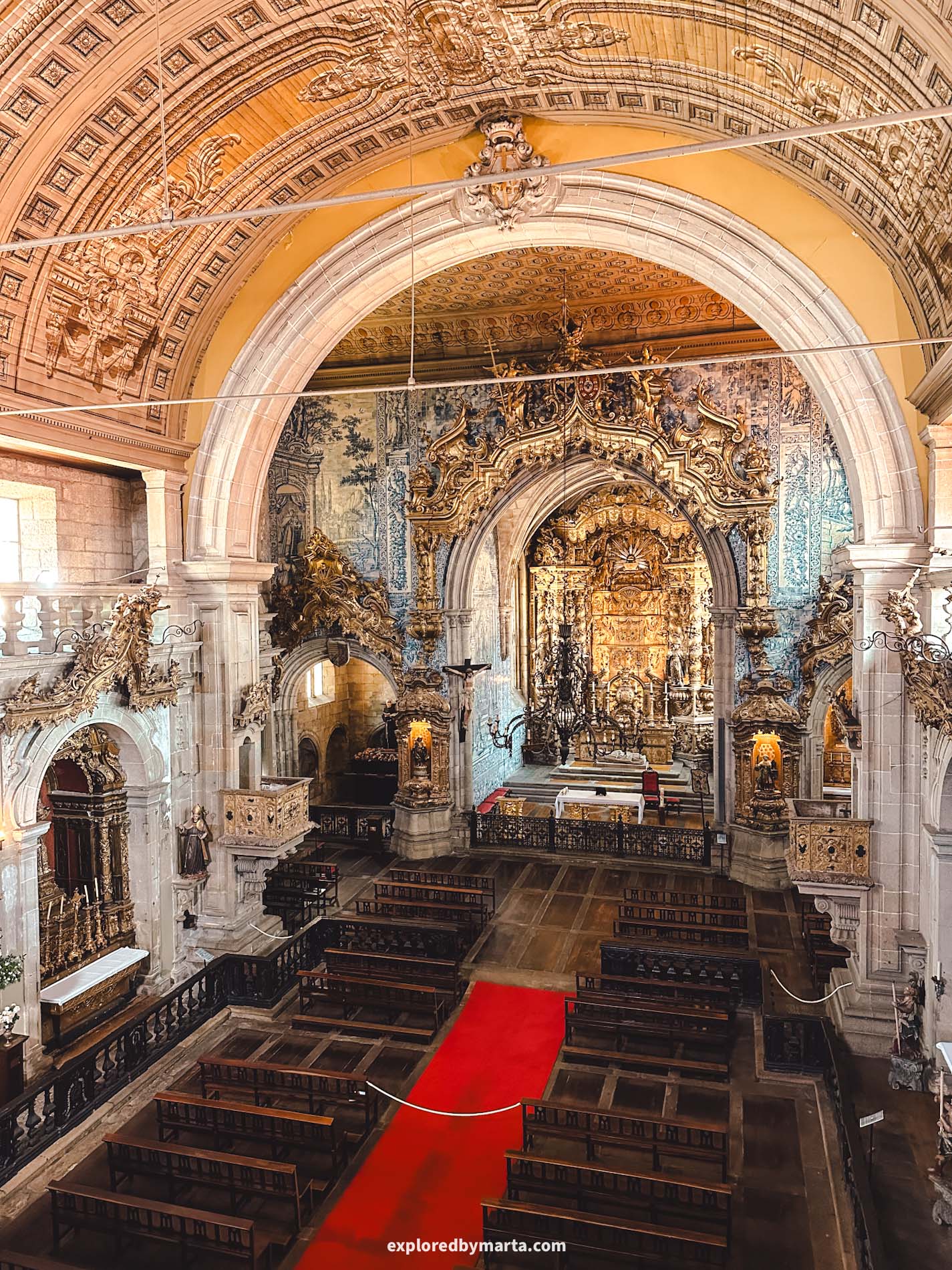
If you are all about grand historical buildings, then look no further!
Igreja de São Francisco, or Church of Saint Francis, is one of the most impressive churches in Guimarães and a great example of how different architectural styles can beautifully blend together over time.
Located just a short walk from the leather tanks (and steps away from the historical center), this church was originally built in the 13th century as part of a Franciscan convent.
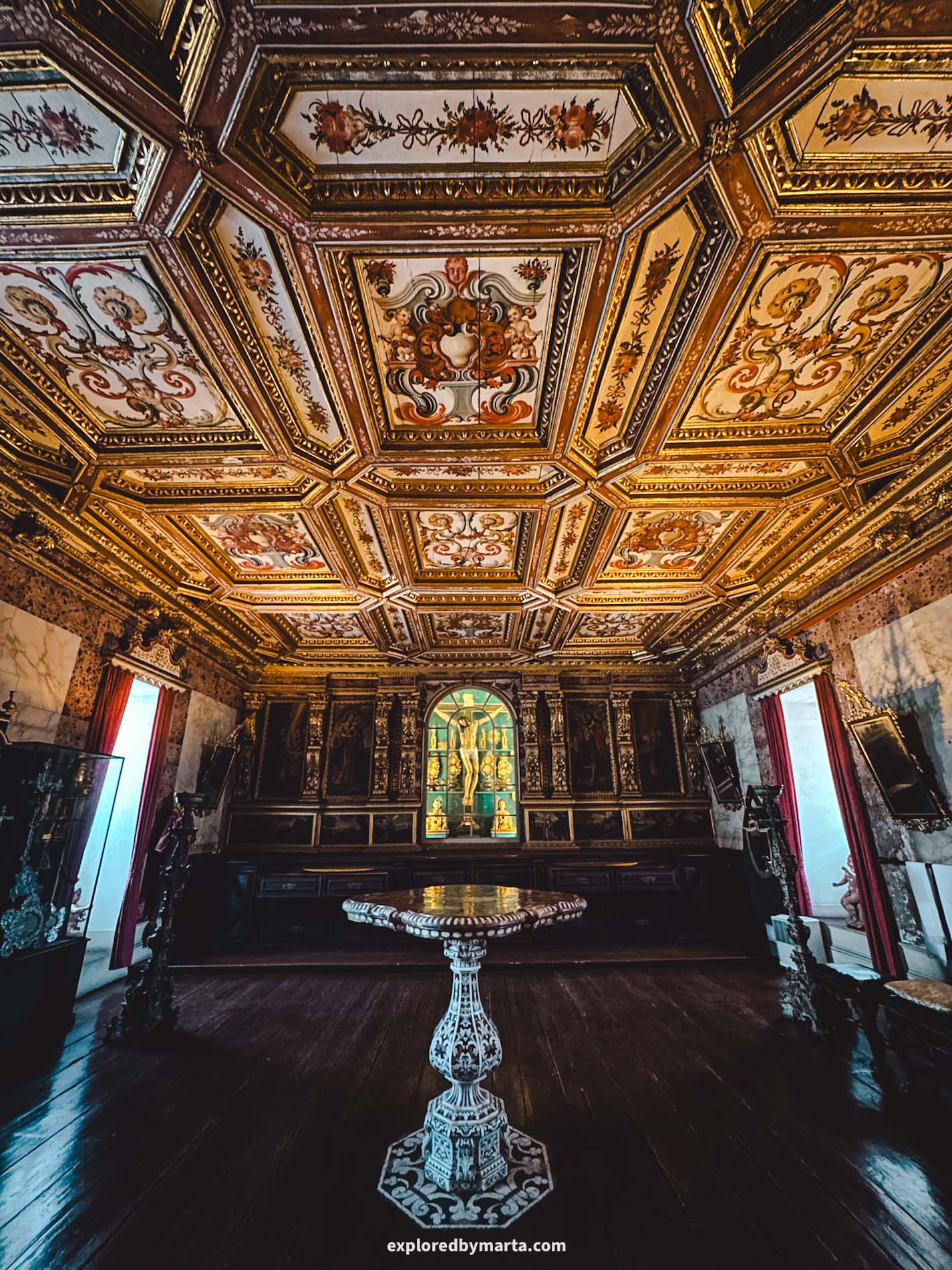
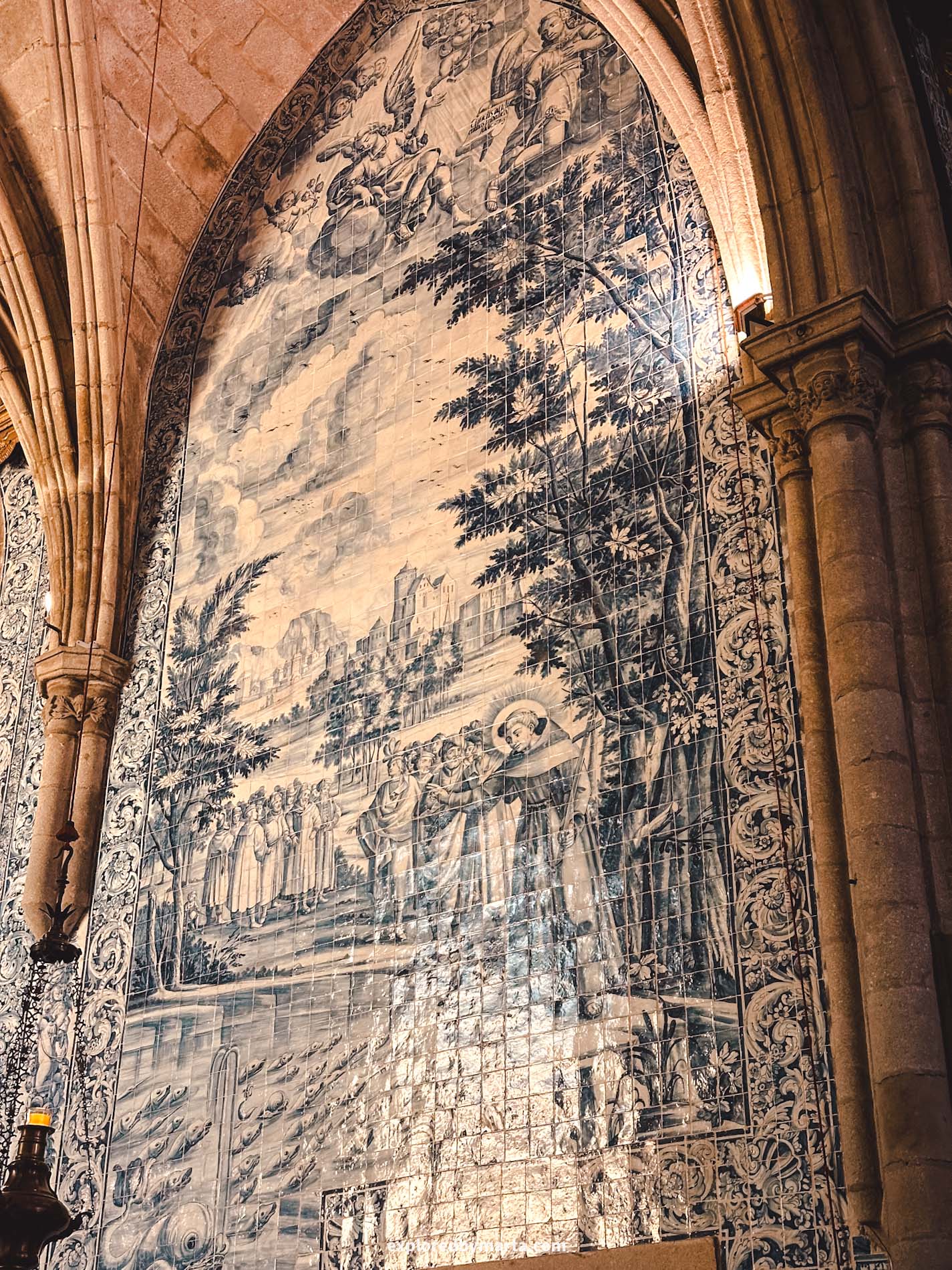
From the outside, it looks simple, but once you step inside, it’s a completely different story, because the interior is richly decorated with gilded wood carvings, detailed azulejo tile panels, and ornate Baroque altarpieces.
I especially loved the vaulted wooden ceilings with paintings, and the blue-and-white tiles which depict scenes from the life of Saint Francis.
There is a small entrance fee (a donation) to enter the church. You get to admire the main nave, all its altars, as well as peek into other backrooms, walk over to the cloister, and visit the church’s balcony, where you will find a beautiful organ.
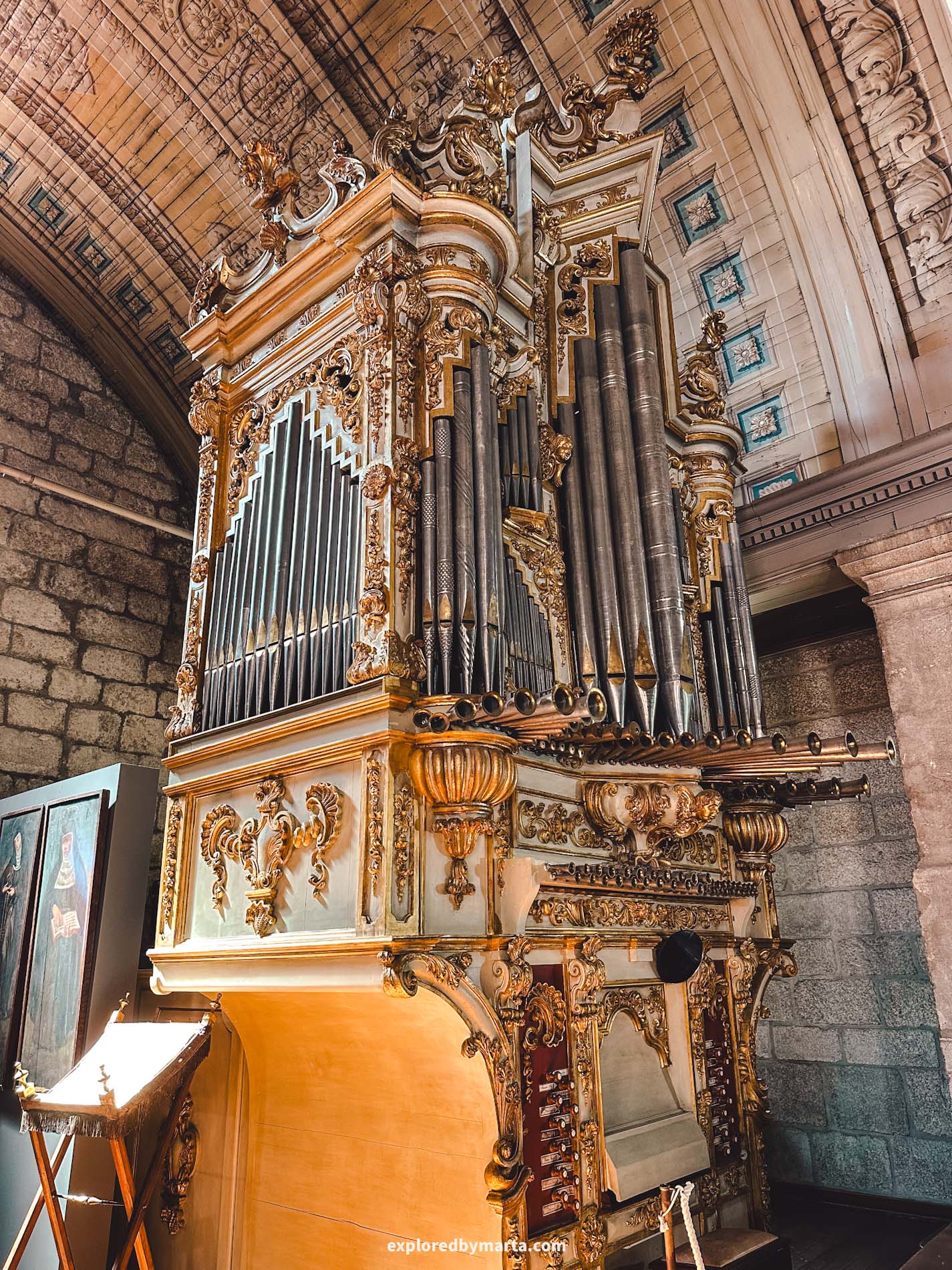
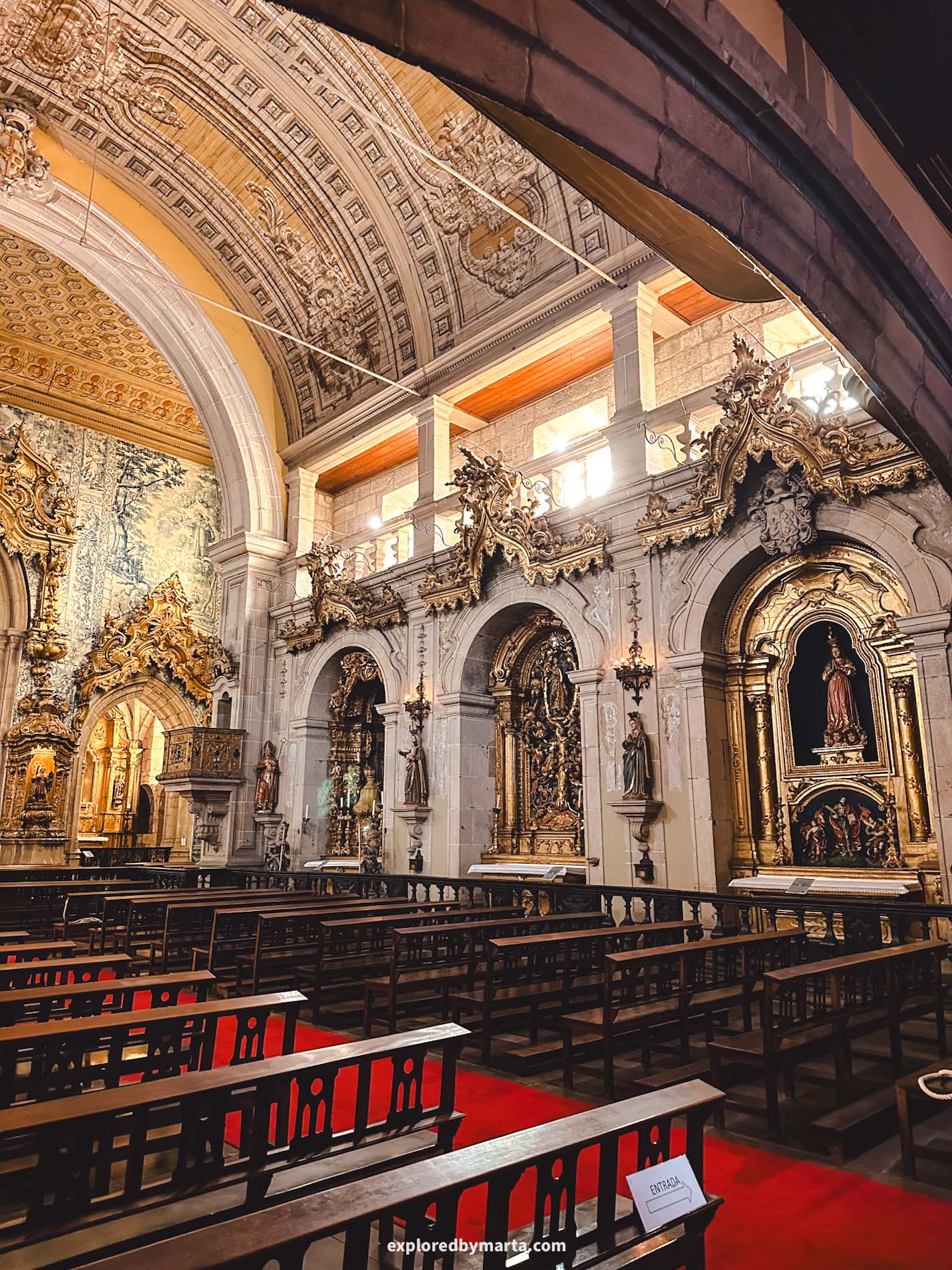
Walking around Saint Francis Church feels like stepping back into the 18th century.
Igreja de São Francisco is definitely quieter than some of the other attractions in Guimarães, like its main church in Largo da Oliveira square. It helps that only a few visitors ever come here. There were only a few people besides us!
If you are looking for hidden gems, a quiet and serene atmosphere, and you have time to spare in the town, I recommend coming over here. It is one of the churches that are actually worth seeing! And they only ask for a symbolic fee.
Location: Igreja de São Francisco
15. Take a photo at the ‘Portugal Was Born Here’ wall
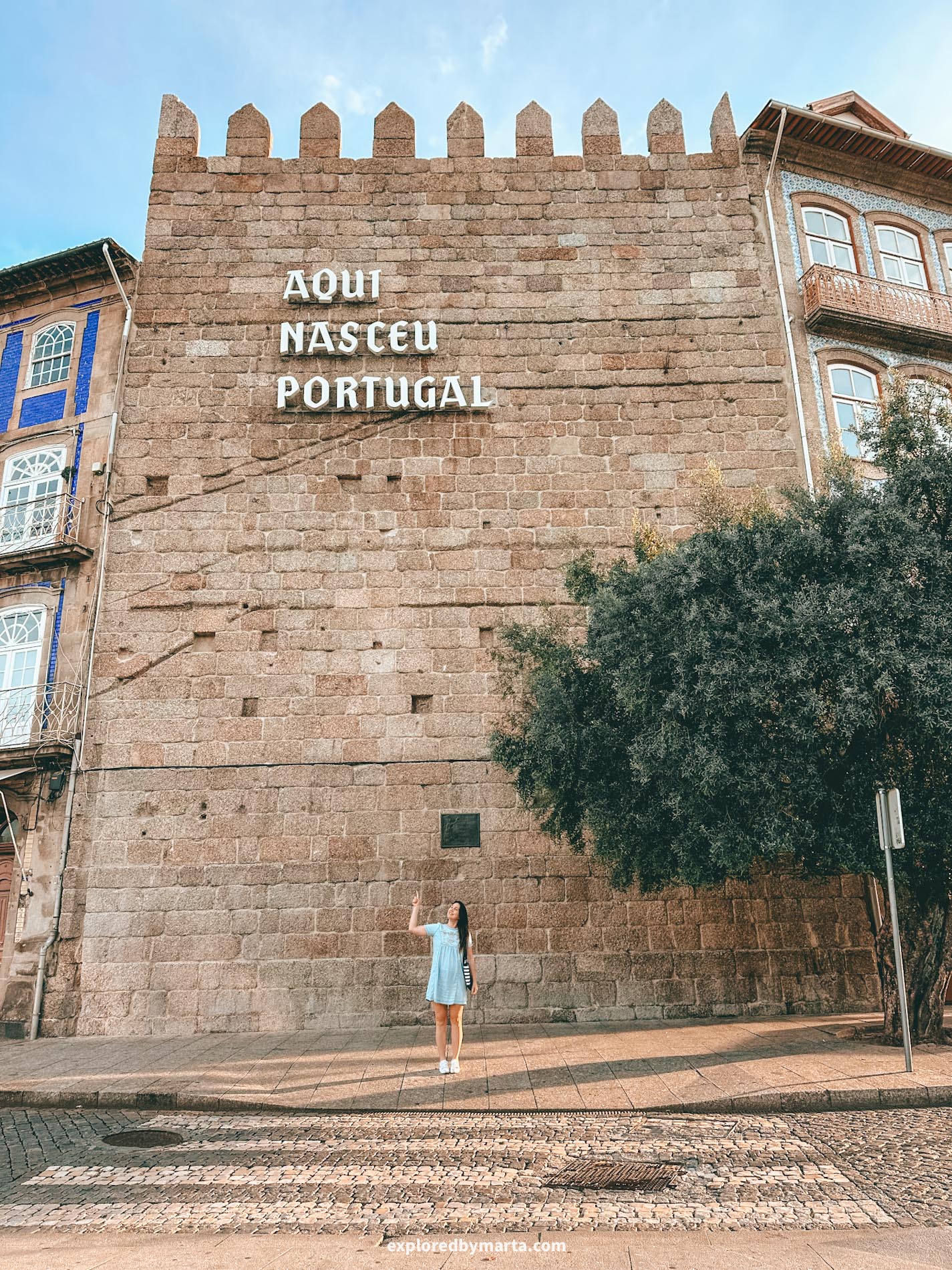
Guimarães is known as the birthplace of Portugal, and there is one special place you can visit in the city that symbolizes this significant historical event – the stone wall with an inscription that reads ‘Aqui Nasceu Portugal,’ which means ‘Portugal Was Born Here’.
The inscription was placed there only in the 20th century, but it stands exactly where the original medieval walls protected the town. If you pay attention to the stone wall, you’ll notice that it looks exactly like the remaining original medieval city walls.
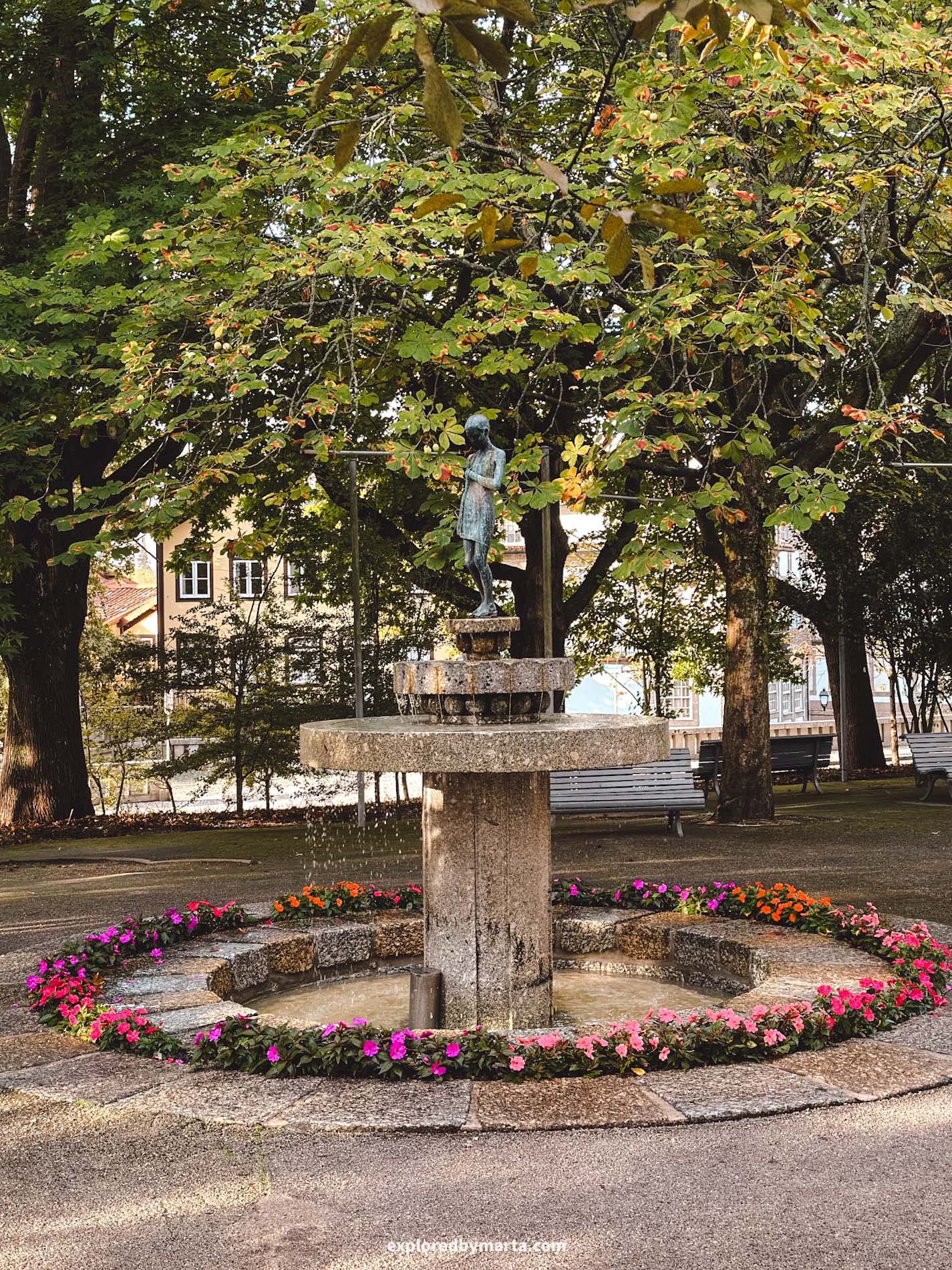
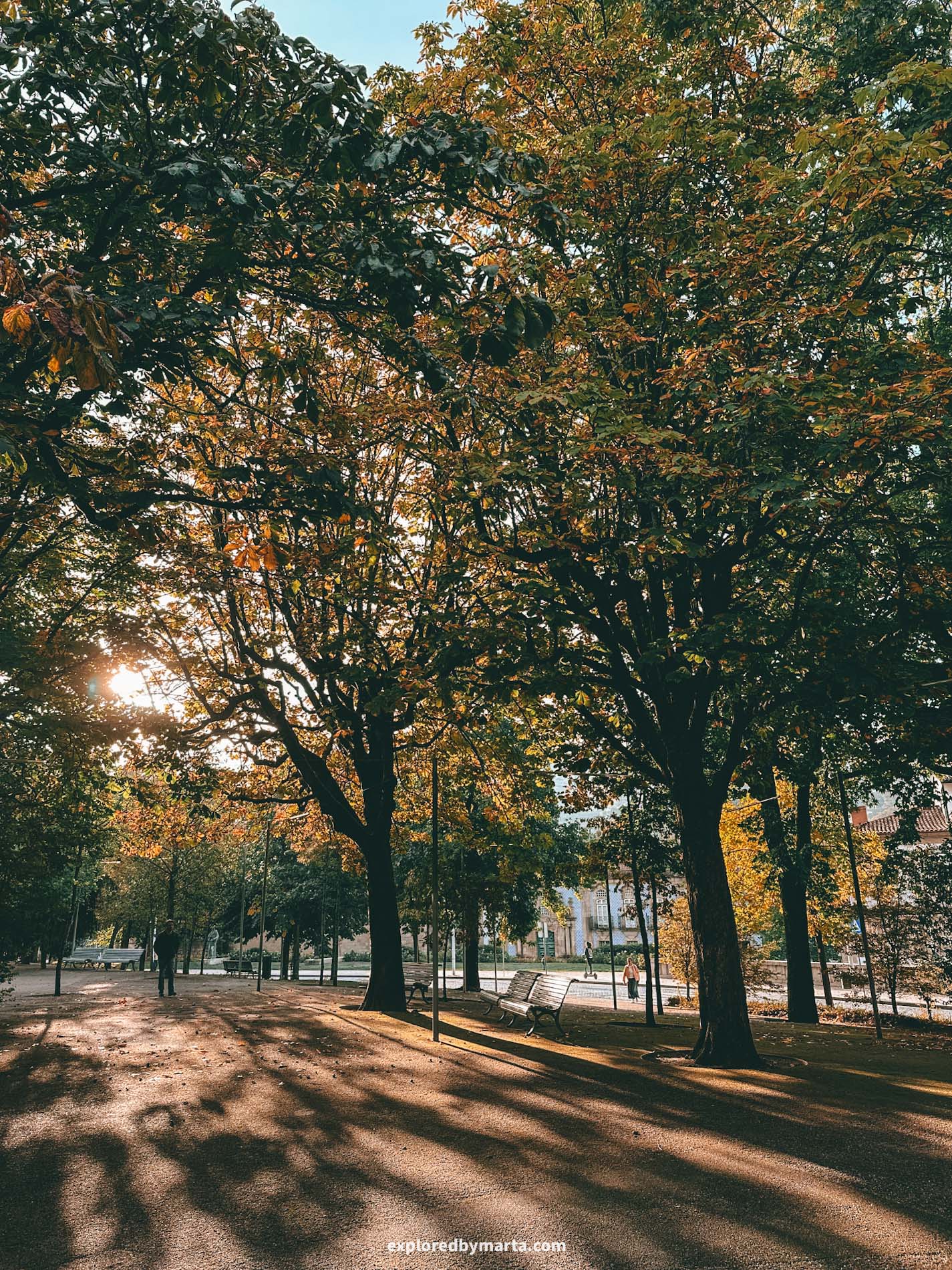
The location of the inscription on the wall is supposedly the area where the first king of Portugal spent part of his childhood back in the 12th century. It may be just a piece of wall, but it still represents the beginning of a country, so definitely stop by to take a photo!
If you come over here from Church of Saint Francis, definitely walk through the beautiful Jardim Público da Alameda, one of the prettiest green spaces in Guimarães! The 19th-century garden features beautiful fountains, flowers, and benches under the shade of trees.
Location: Aqui Nasceu Portugal
16. Stroll through the beautiful Largo do Toural
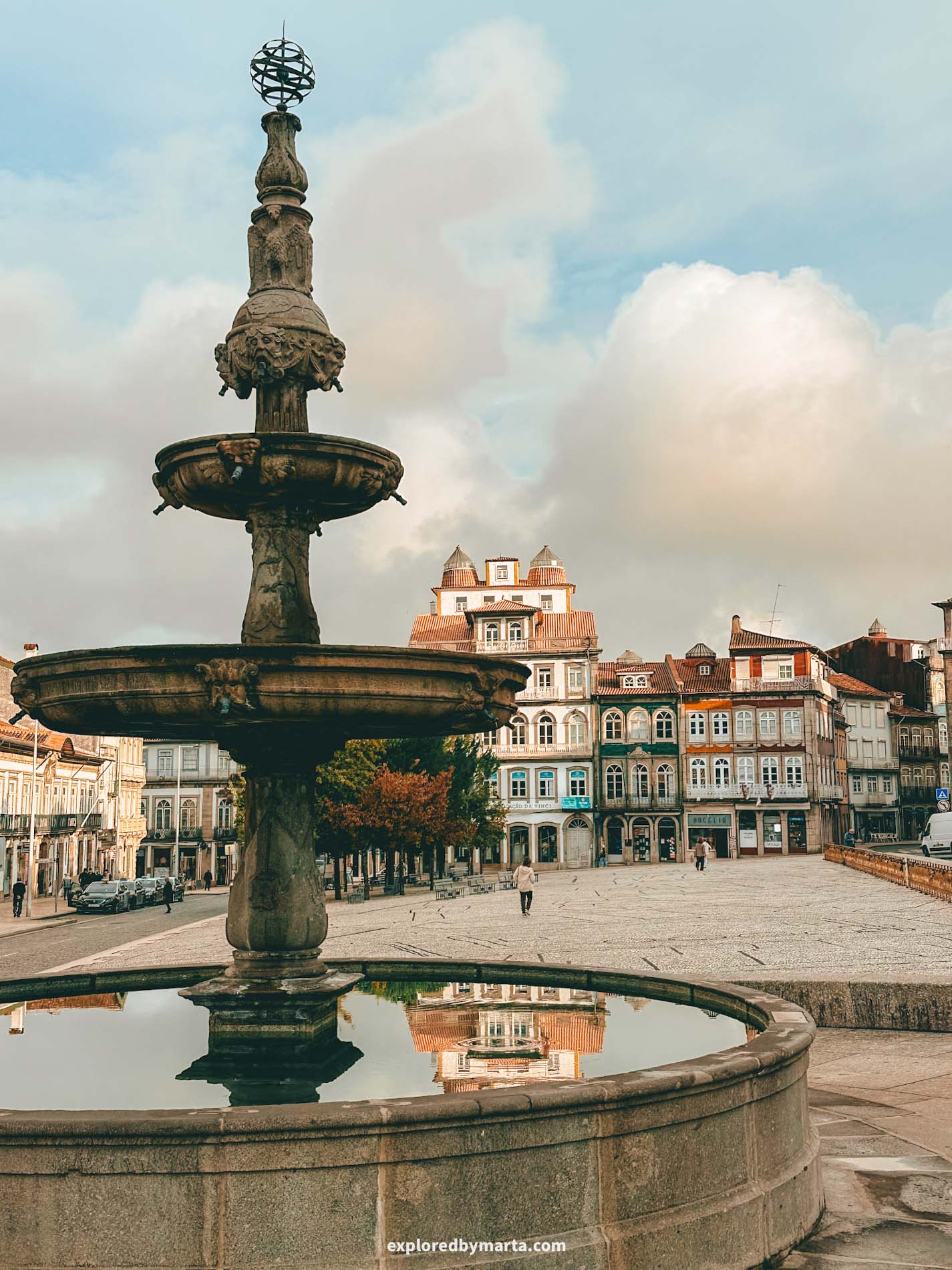
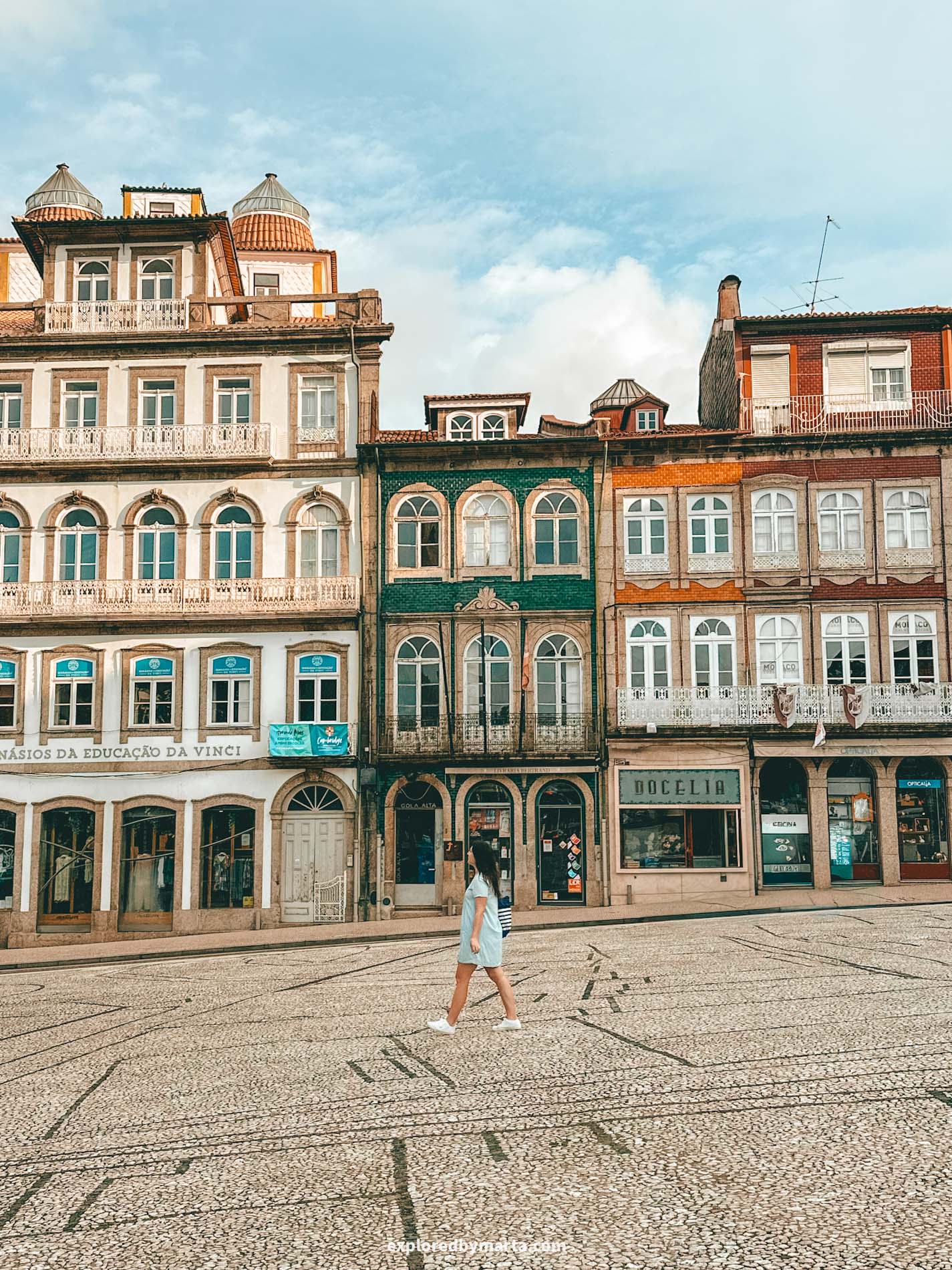
Now, there’s only one thing left to do in Guimarães town – visiting the iconic Largo do Toural square. It is located right next to the ‘Portugal Was Born Here’ wall and features a beautiful fountain and colorful 17th and 18th-century buildings.
Largo do Toural is one of the largest and most beautiful squares in the center of Guimarães. We passed through many times during our stay, and I always stopped to admire the traditional Portuguese-style buildings (see photos above).
If you are into photography and love these traditional Portuguese-style buildings as much as I do, then this square is a great place to go to take some photos.
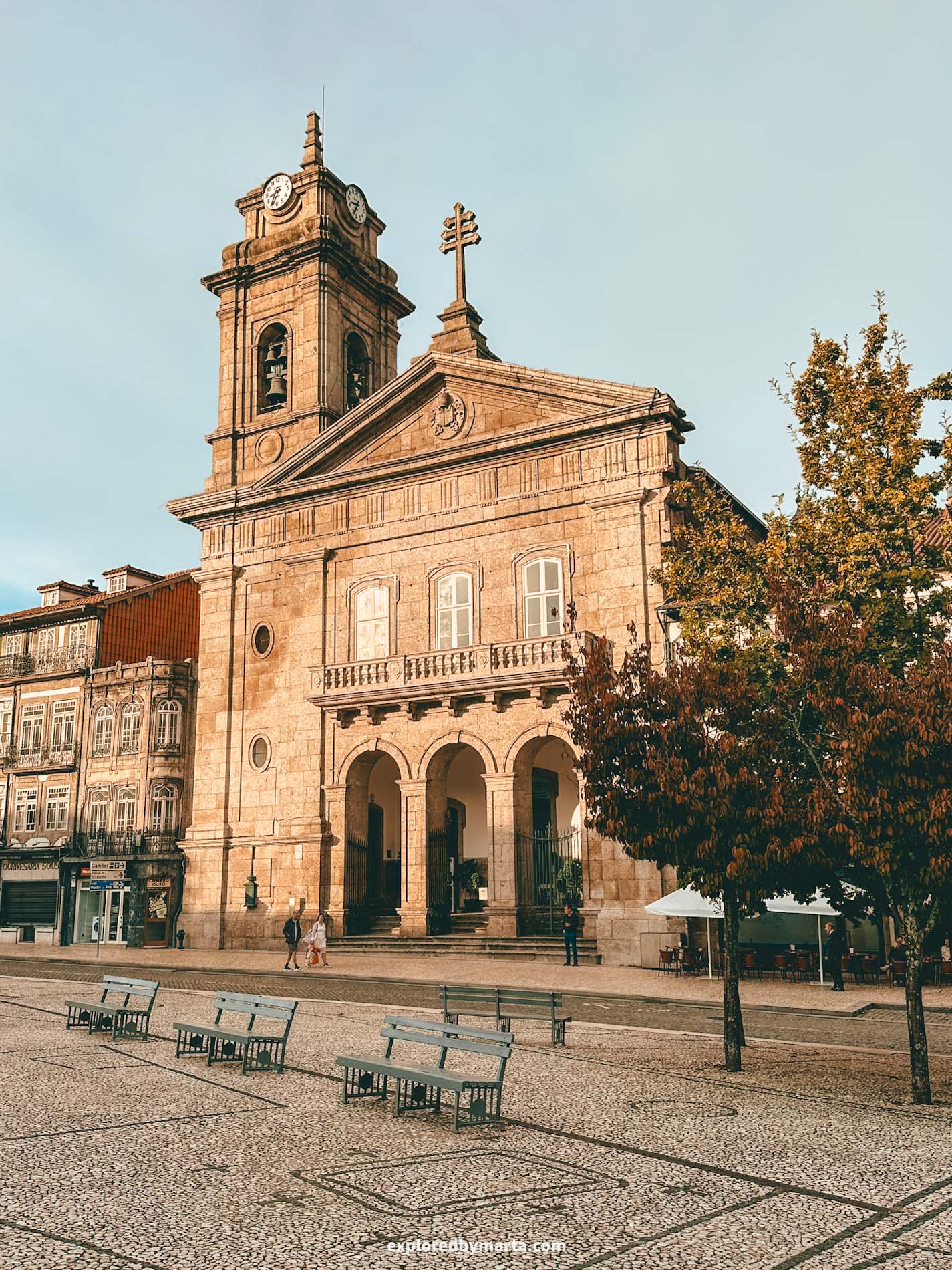
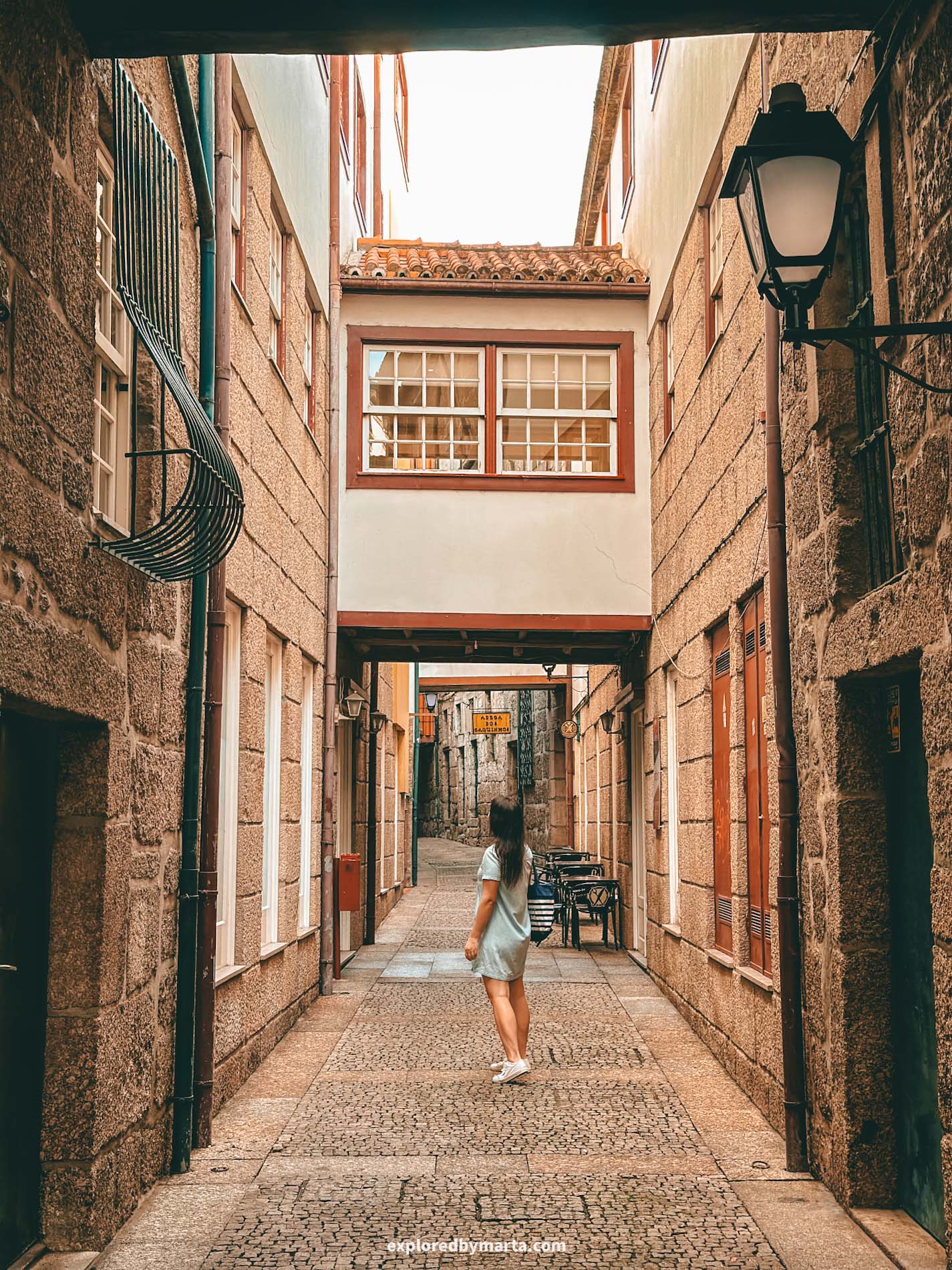
Originally, the square was located just outside the city walls and used to serve as a cattle market during medieval times. This is where its name comes from – the word ‘toural’ comes from ‘touro,’ meaning ‘bull’.
In later centuries, Largo do Toural transformed into a more refined urban square, becoming the social and commercial center of the town with beautiful tiled buildings, stylish cafés, and shops.
This is where many local events take place, and it’s a great spot to relax for a while, people-watch, or enjoy a drink on one of the terraces before continuing your travels outside Guimarães.
Location: Largo do Toural
17. See Guimarães from above at the Sanctuary of Penha
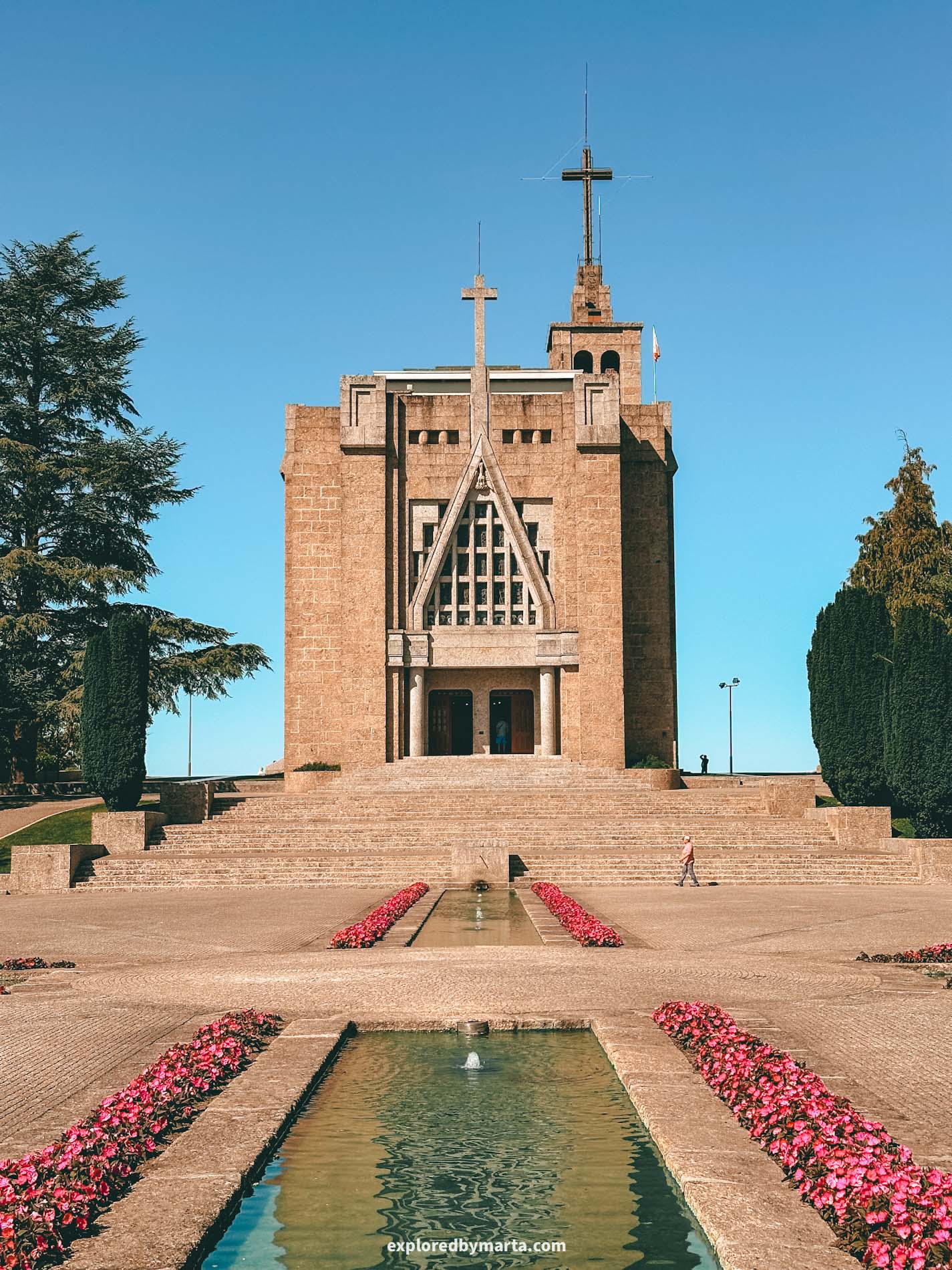
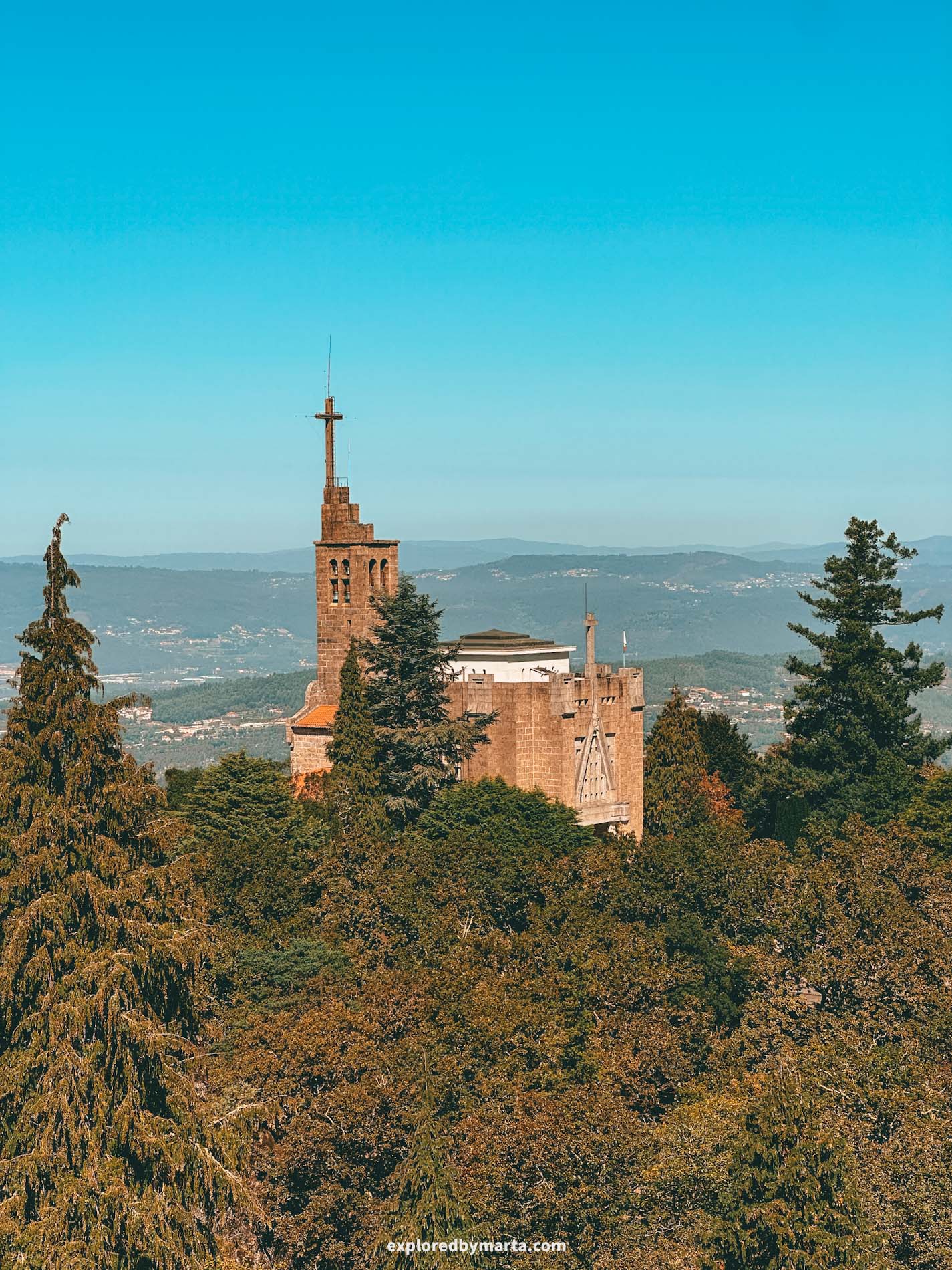
There is one unique place I highly recommend visiting next to Guimarães, and it is Santuário de Nossa Senhora do Carmo da Penha, or simply Sanctuary of Penha.
It is a beautiful, modern hilltop sanctuary sitting on Mount Penha next to Guimarães, offering one of the most breathtaking panoramic views of the city and the surrounding area. They do love building churches and sanctuaries on top of hills here in Portugal!
Visiting this hilltop was one of my favorite things to do in Guimarães!
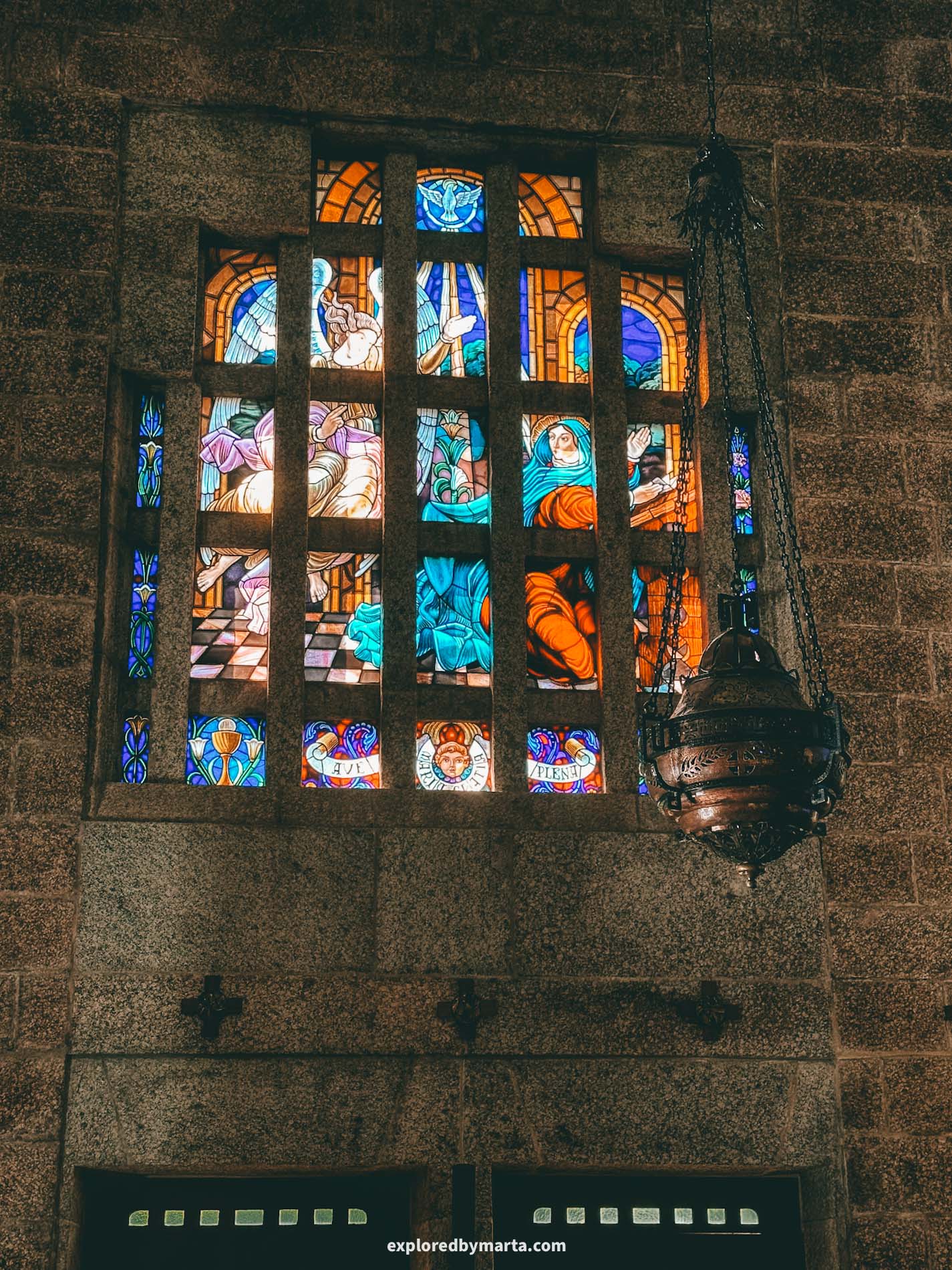
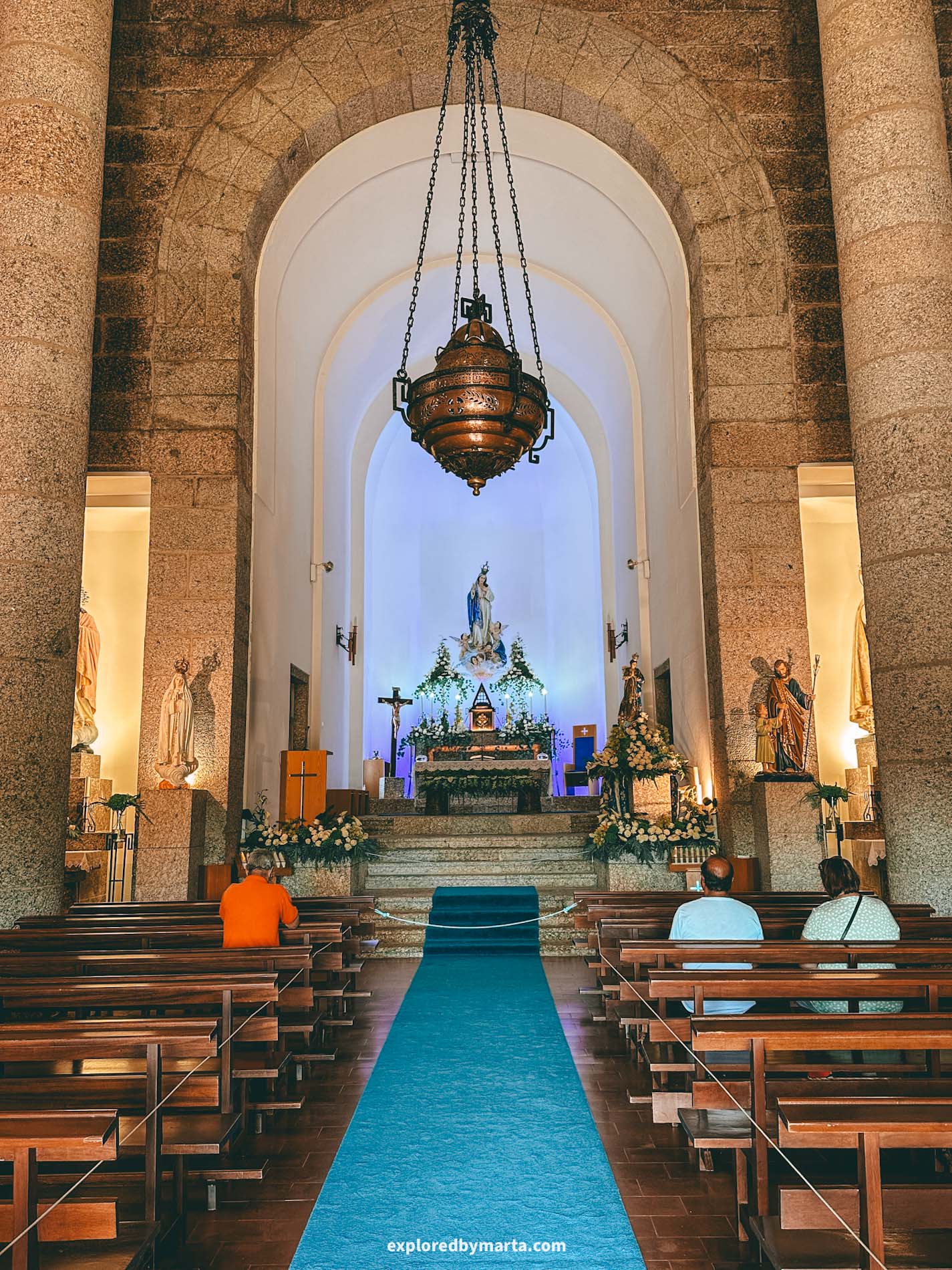
You can get up there by the Penha cable car (Teleférico de Guimarães), by public transportation, or by rental car, if you have one. We had our own transportation, so we went there by ourselves. There’s a large parking area with cafés and other activities on top of the hill.
This is a popular place to gather for religious events.
The sanctuary was built in the early 20th century and is dedicated to Our Lady of Mount Carmel, as the name suggests. It was designed by the Portuguese architect José Marques da Silva, who also designed many iconic buildings in Porto, like the São Bento railway station.
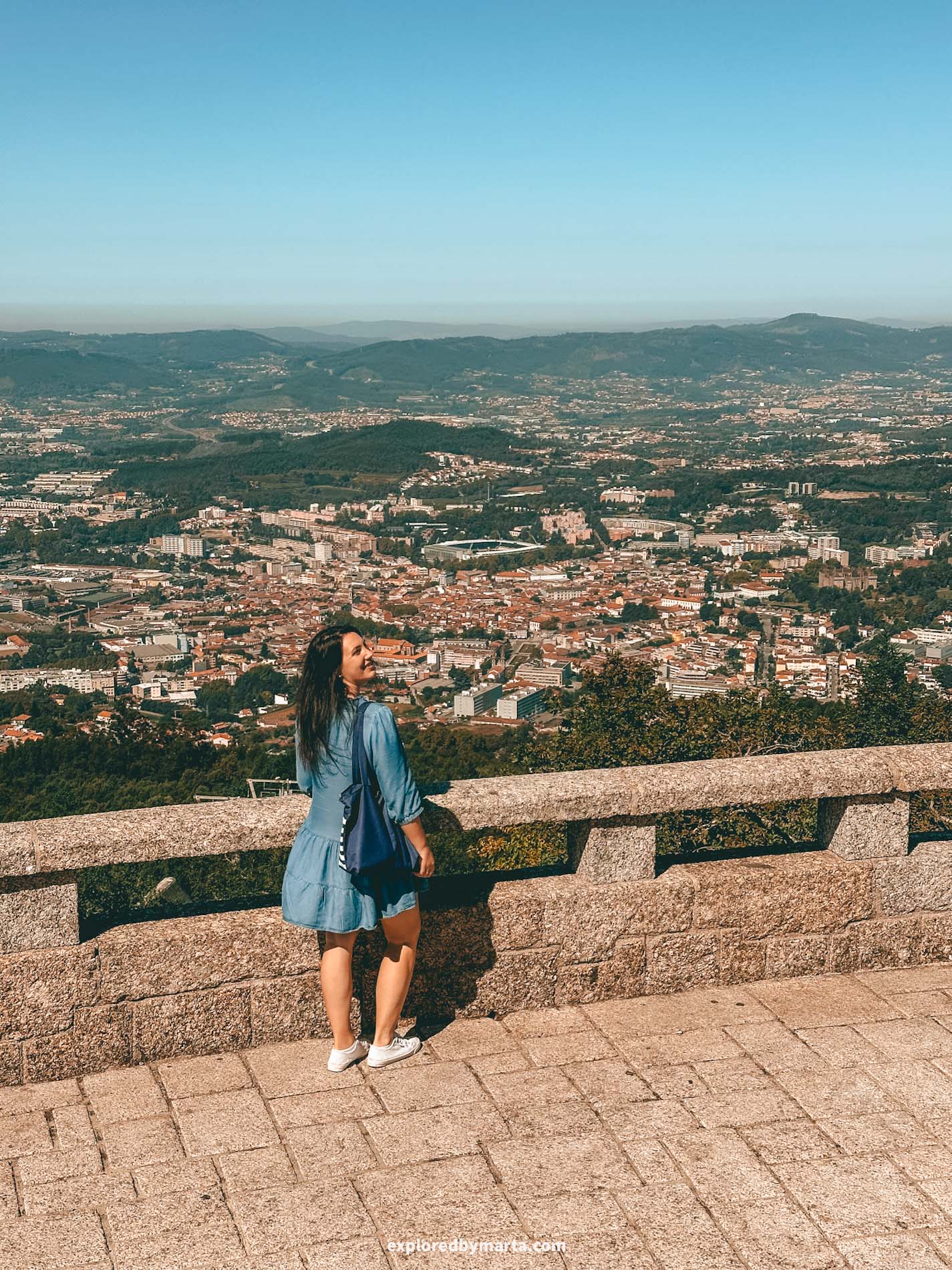
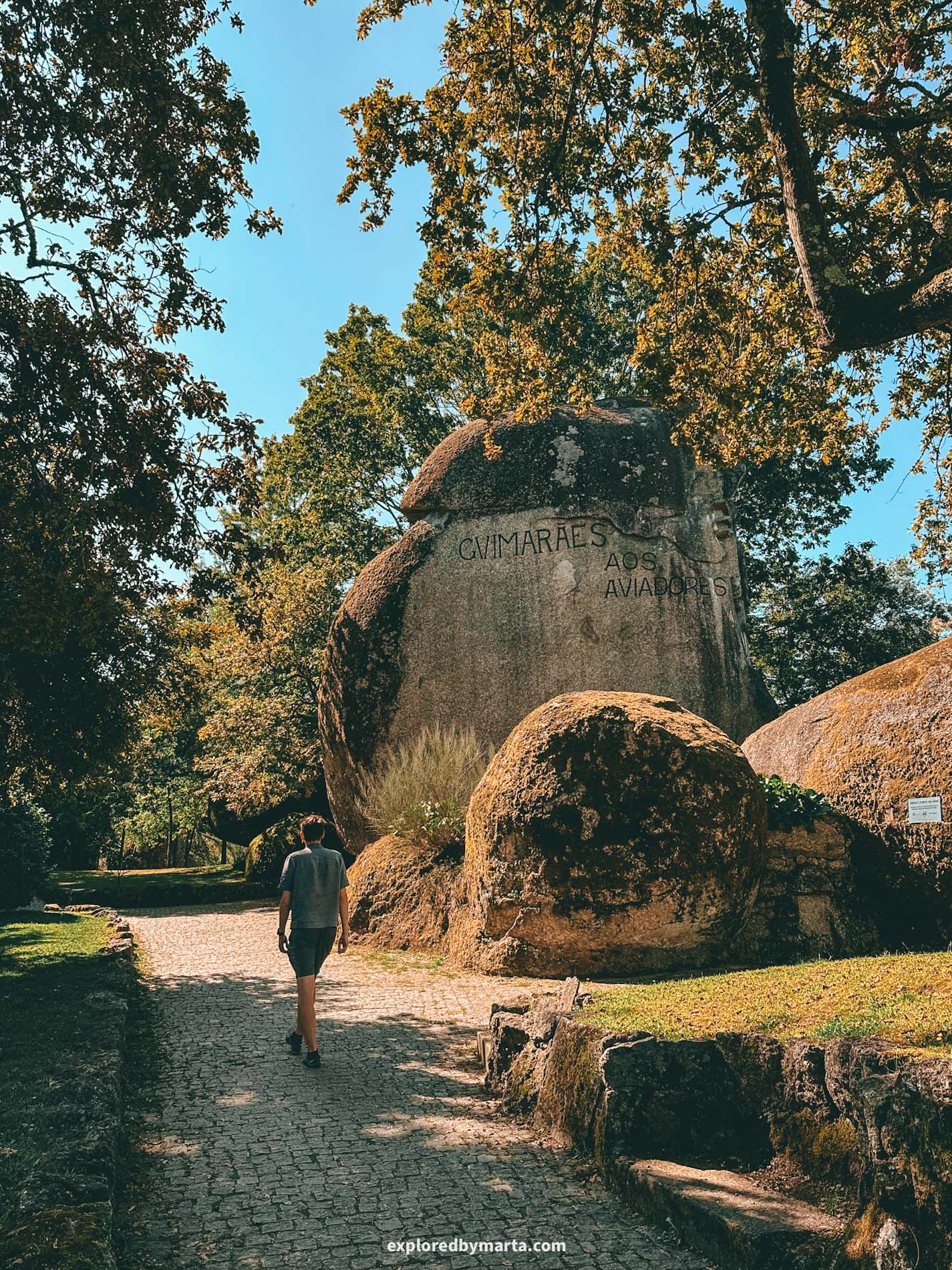
The church is made of granite and has a simple, but unique design. The moment you arrive at the top of the hill, you may notice how it is quite rocky with big boulders scattered around the hilltop. The church, with its granite design, fits there perfectly!
However, like always in such places, my favorite thing about this place was the view!
If you go to the front of the church, you’ll find a panoramic view of Guimarães below you. We went there in the morning, but this would definitely be a spectacular place for a beautiful sunset!
Location: Sanctuary of Penha
18. Explore the trails in Parque da Penha boulder park
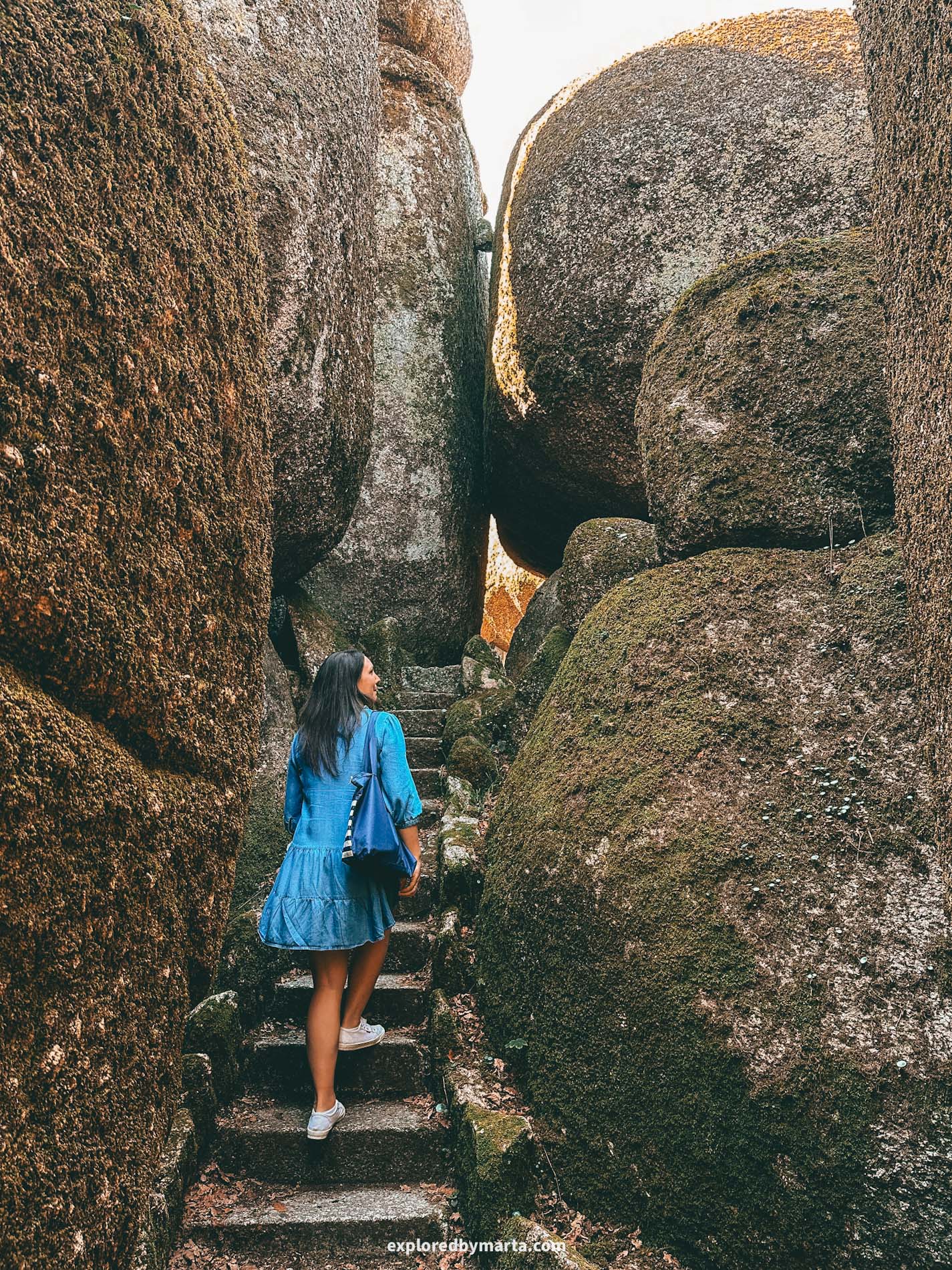
Once you finish admiring the sanctuary and the panoramic views, no matter what you do, don’t leave just yet! To be completely honest, the sanctuary or the view weren’t my favorite places up there on that hill! It was actually the park itself!
Parque da Penha is one of the most beautiful natural spots in Guimarães. It offers sweeping city views, picnic areas, and my favorites – secret caves and forest trails hidden between the large boulders covering the mountain!
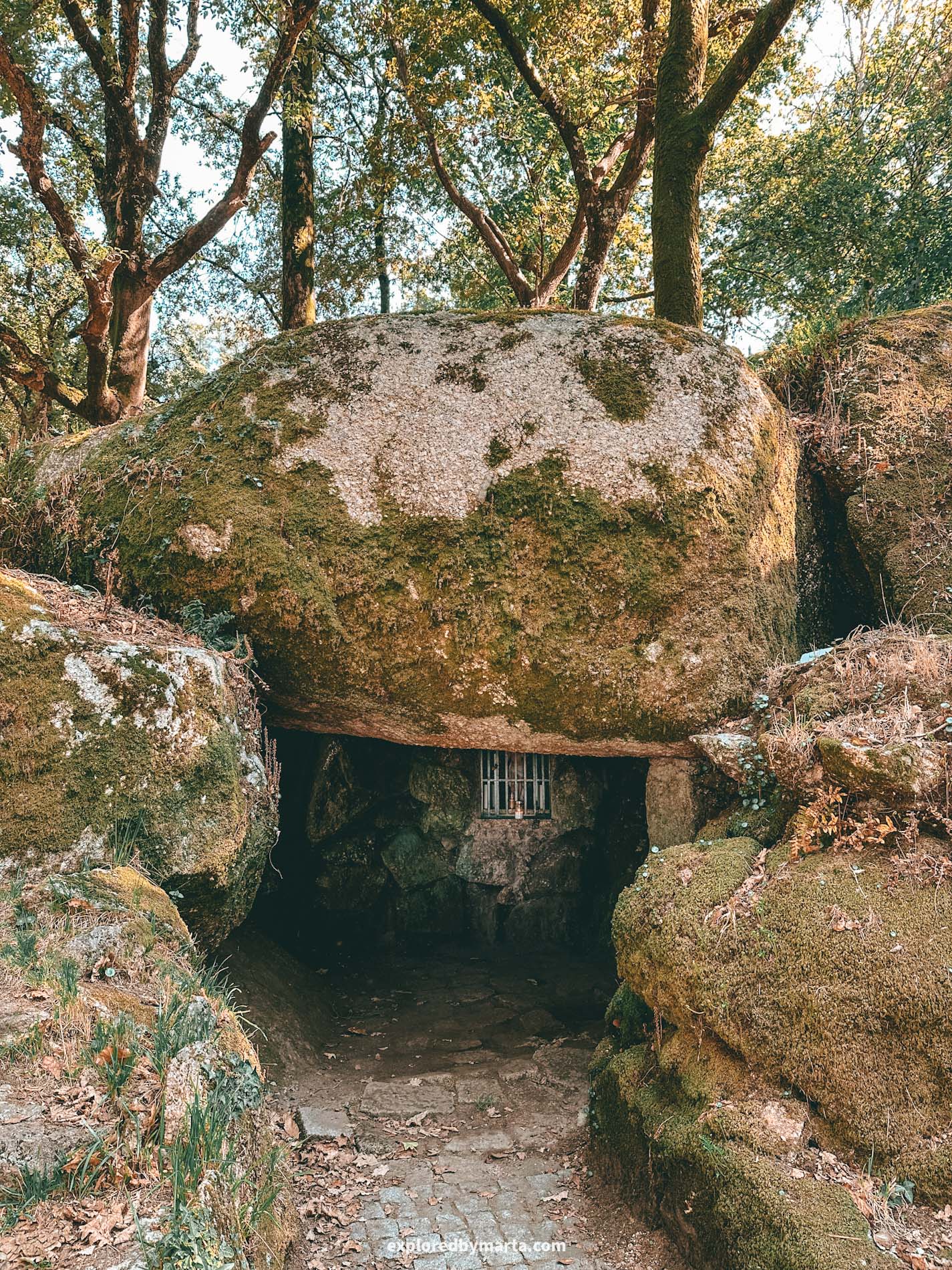
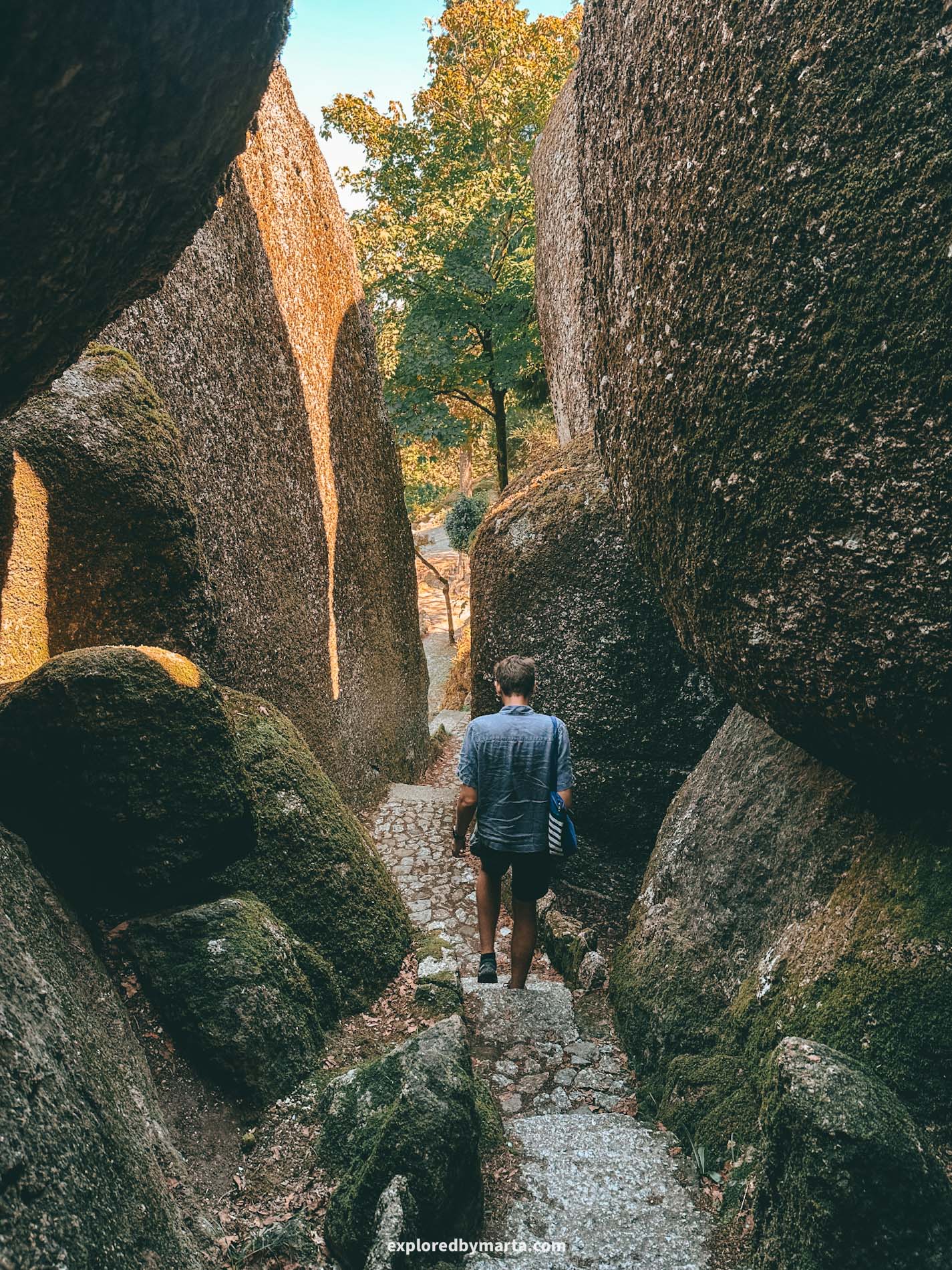
After visiting the sanctuary, we spent an hour exploring all the hidden paths in the park. They have made paved paths and stairs between the boulders. The paths are so hidden, it makes it difficult to figure out where you are and where you will end up at the end of the trail!
I absolutely loved it! If you are looking for a place for a picnic, there is no better spot in Guimarães!
We walked to Gruta de San Sebastián, the viewpoint on top of Monte de Santa Catarina (the highest point on the mountain), and walked through almost every narrow slot we found between the boulders in the park.
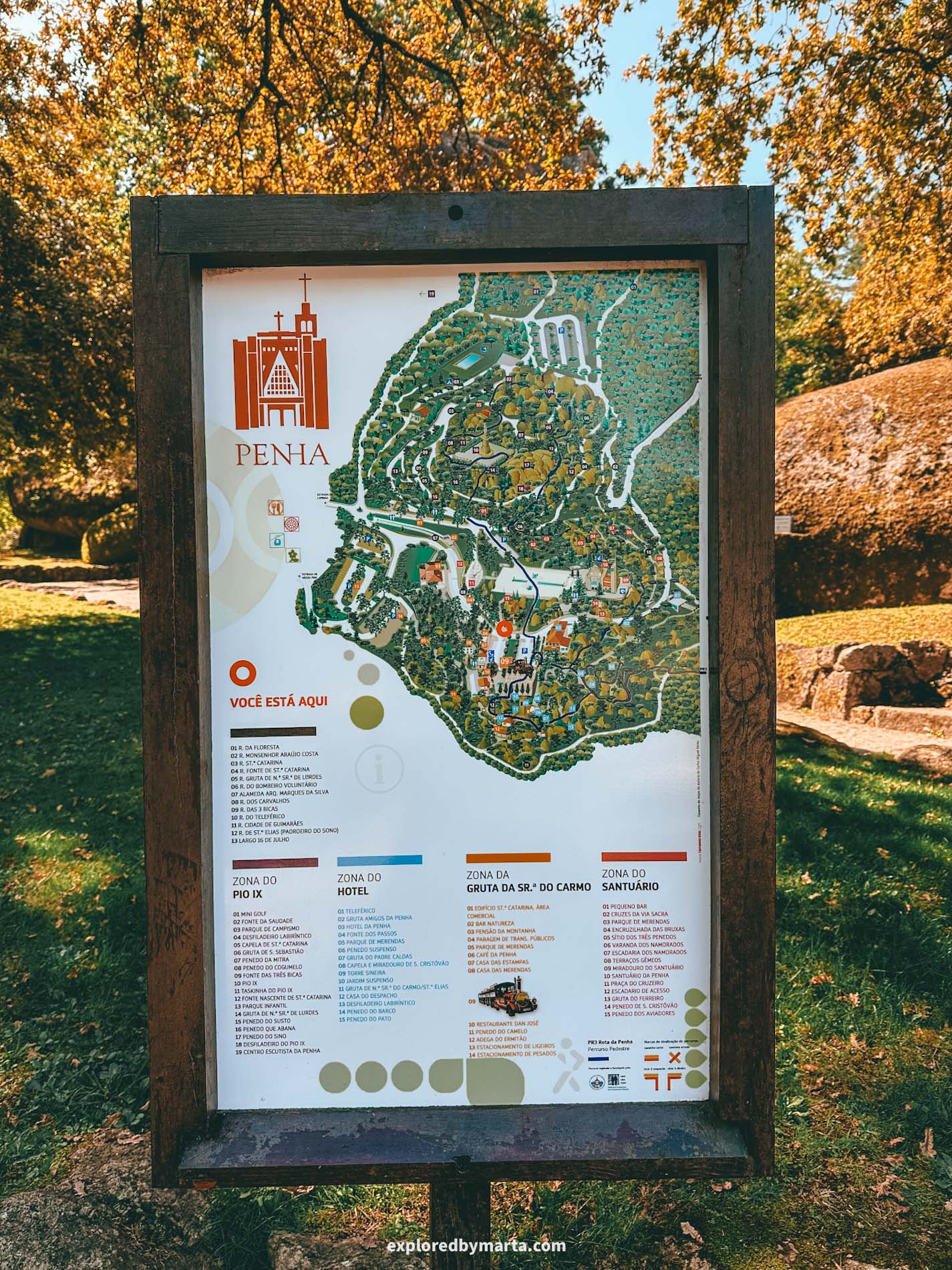
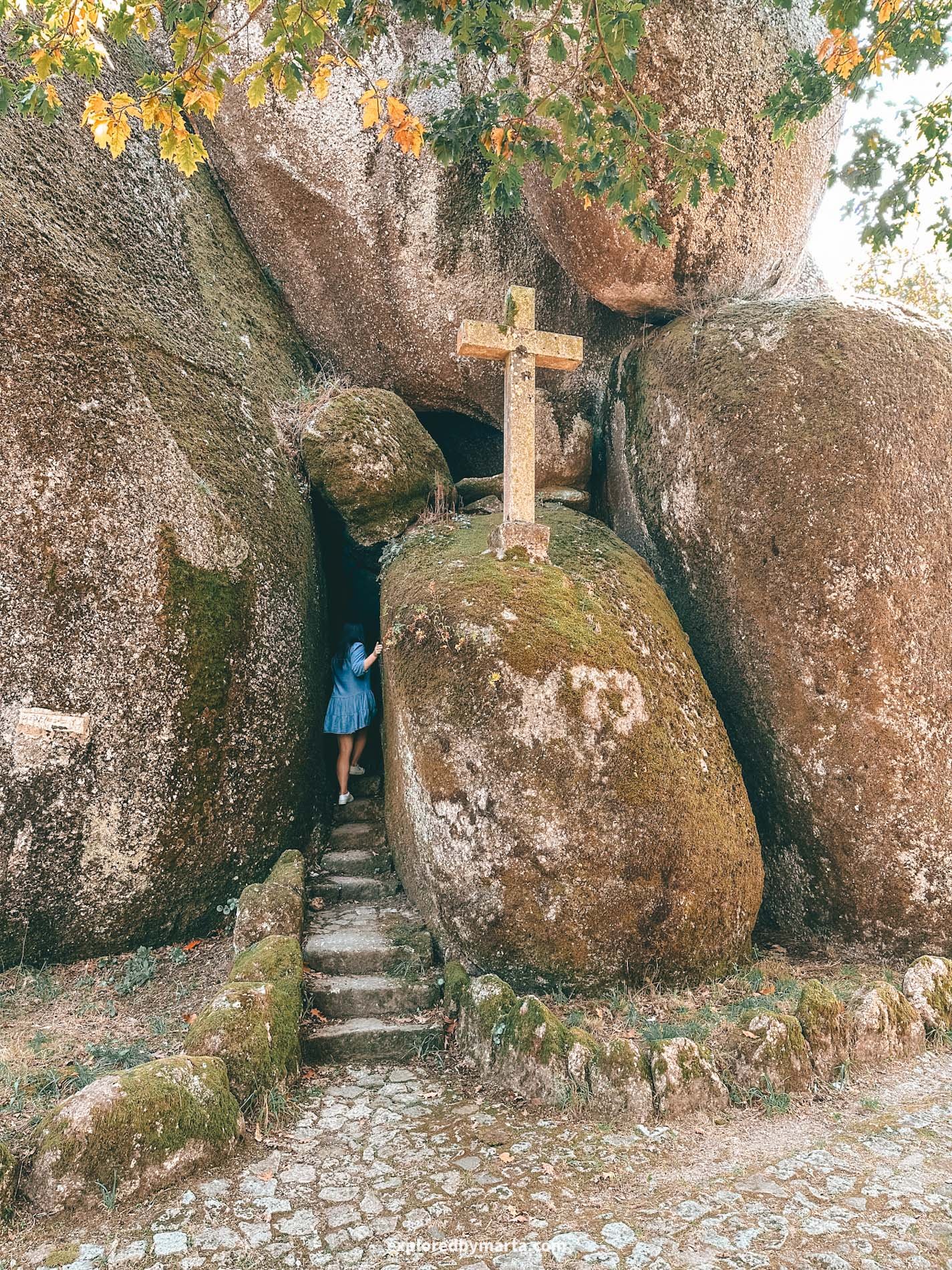
This place was so much fun to explore! At least, we had fun, and I imagine kids would love it too! It is also a popular place among locals, but the area is big enough to find a quiet spot to enjoy the scenery and relax.
We also saw a couple of maps in the park, so I recommend taking a photo of the map and going on a self-guided adventure. This was one of my favorite activities we did in Guimarães. Overall, we spend around 1.5 hours on top of the hill.
Parque da Penha is definitely a must-see when visiting Guimarães.
Location: Parque da Penha
19. Go on a trip to the ancient Citânia de Briteiros
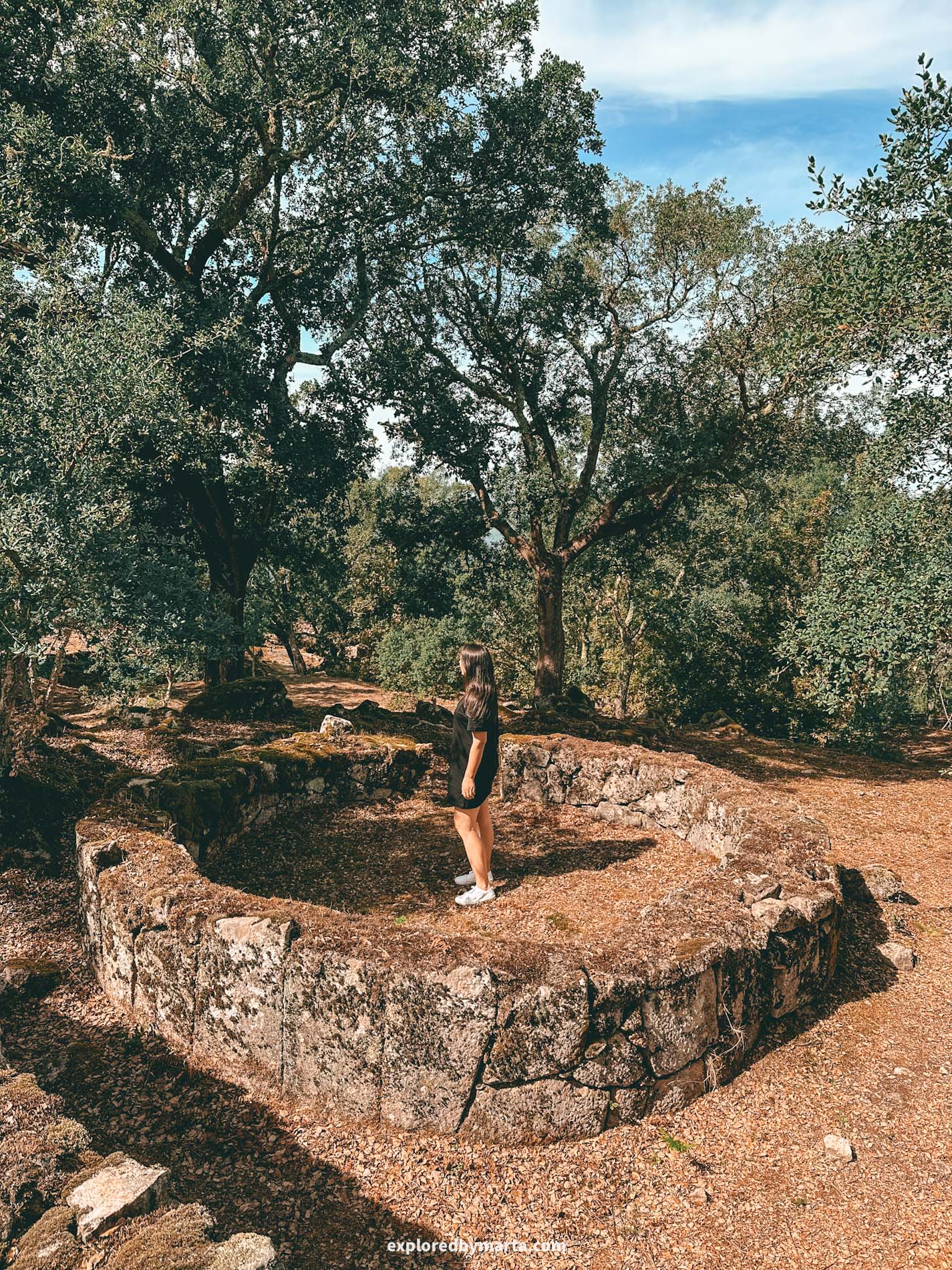
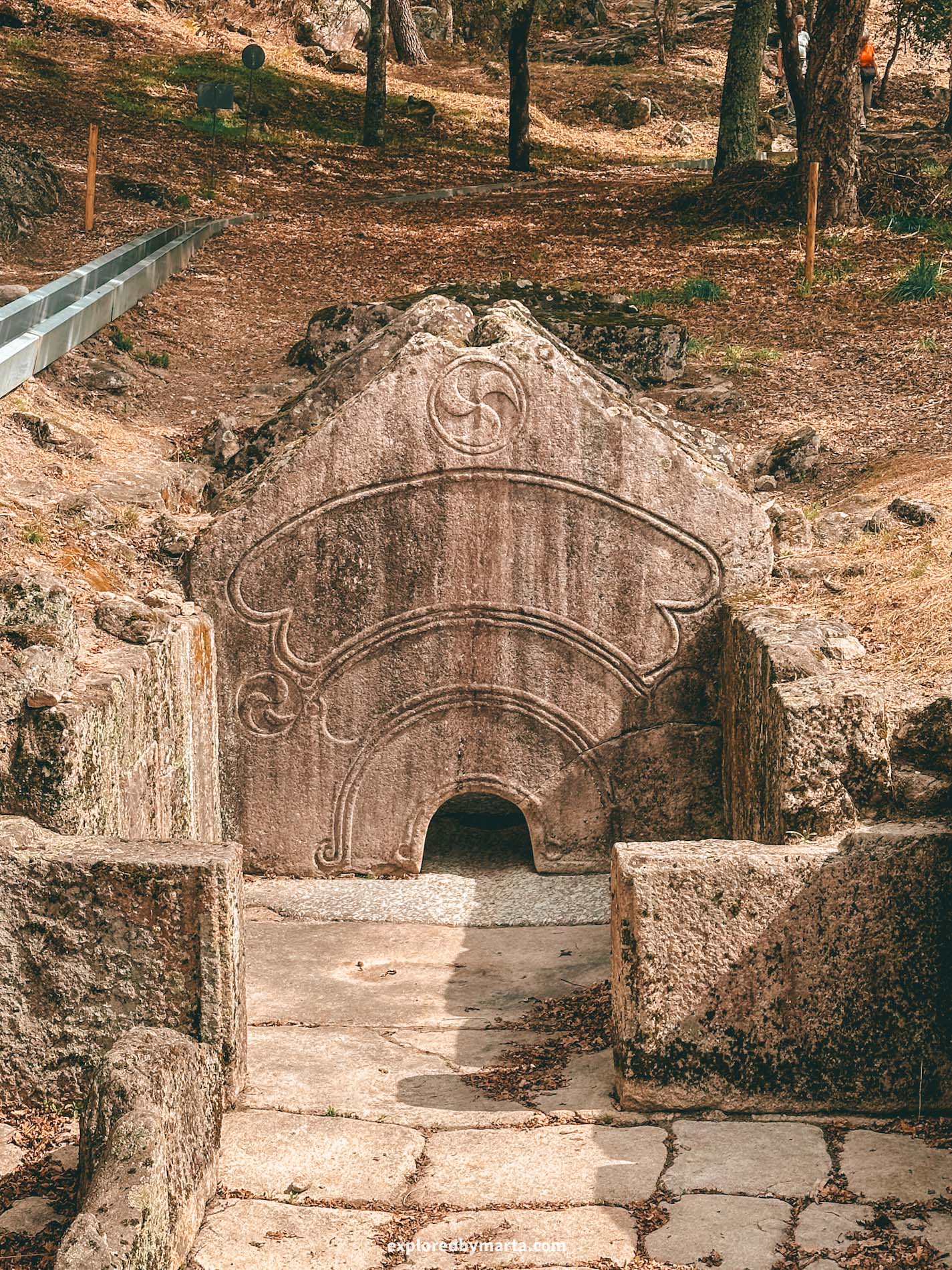
Now this is a place for you if you love ancient archaeological sites, and are fascinated by how people lived back in the day thousands of years ago.
Located between Braga and Guimarães, is one of the most fascinating archaeological sites in Northern Portugal – Citânia de Briteiros.
The ancient settlement sits on a small hill overlooking the Ave River valley and offers an incredible glimpse into life more than 2,000 years ago.
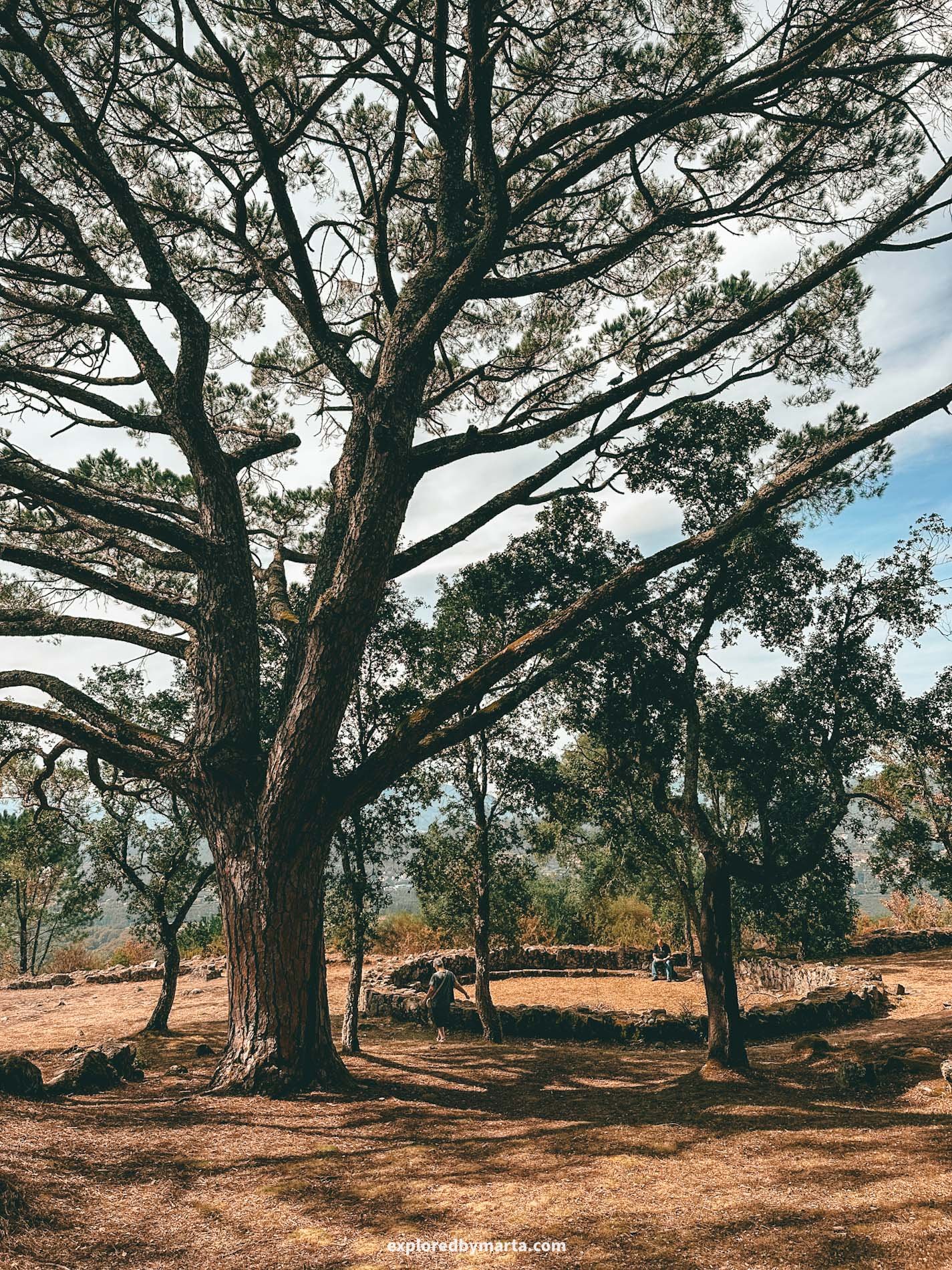
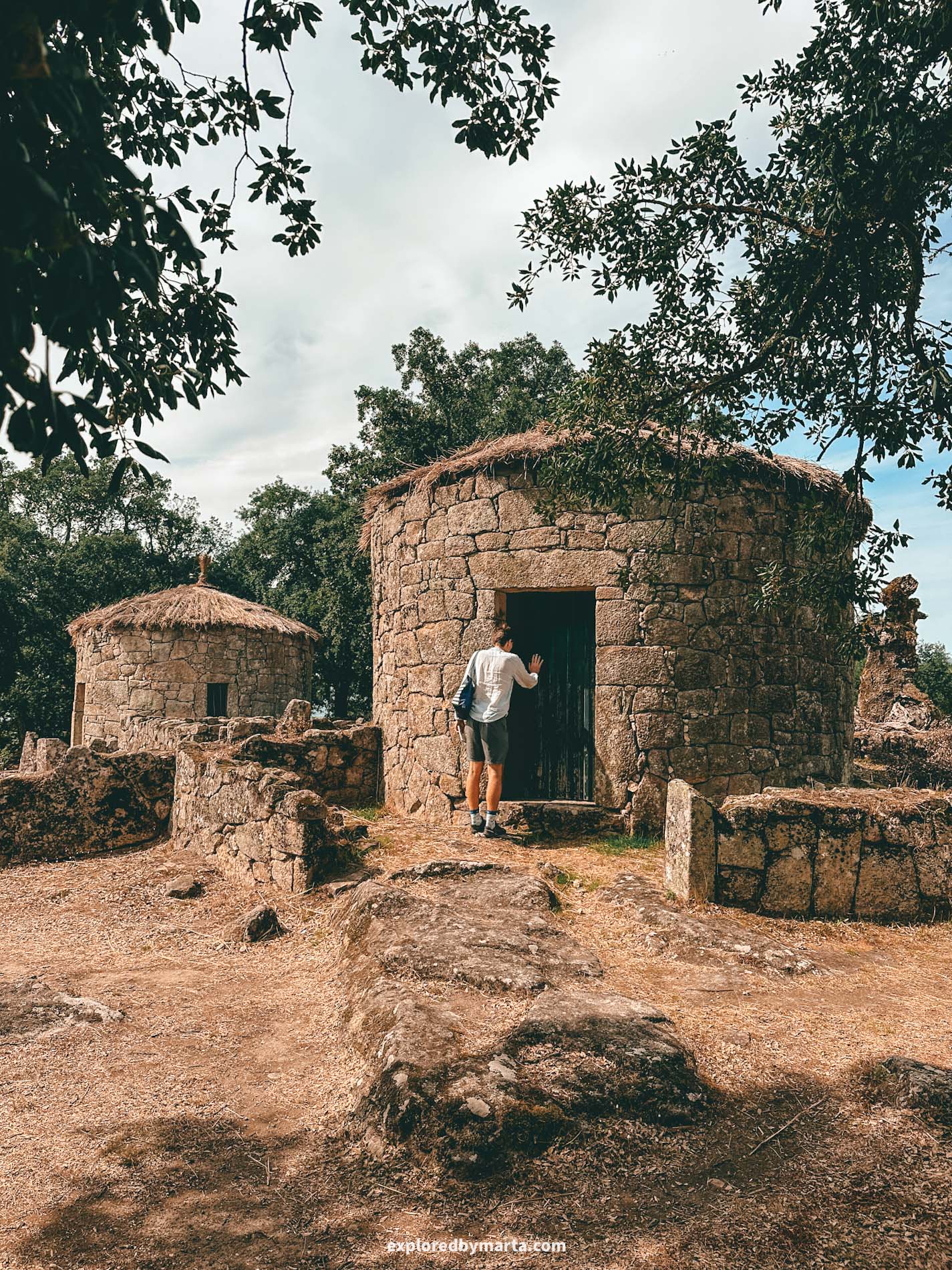
The site dates back to the Iron Age and was inhabited by the Castro tribe that lived in fortified hill settlements known as castros. Later on Romans came here.
Some of the most interesting features in Citânia de Briteiros are their circular stone houses. Most of them are only ruins with only the foundations visible today, but you will stumble upon some circular home replicas, too!
It was wild to wander around and imagine how people lived up on a hilltop many centuries before Portugal even existed. And how did they bring all this stone to the hilltop to build all the buildings and defensive walls? Crazy.
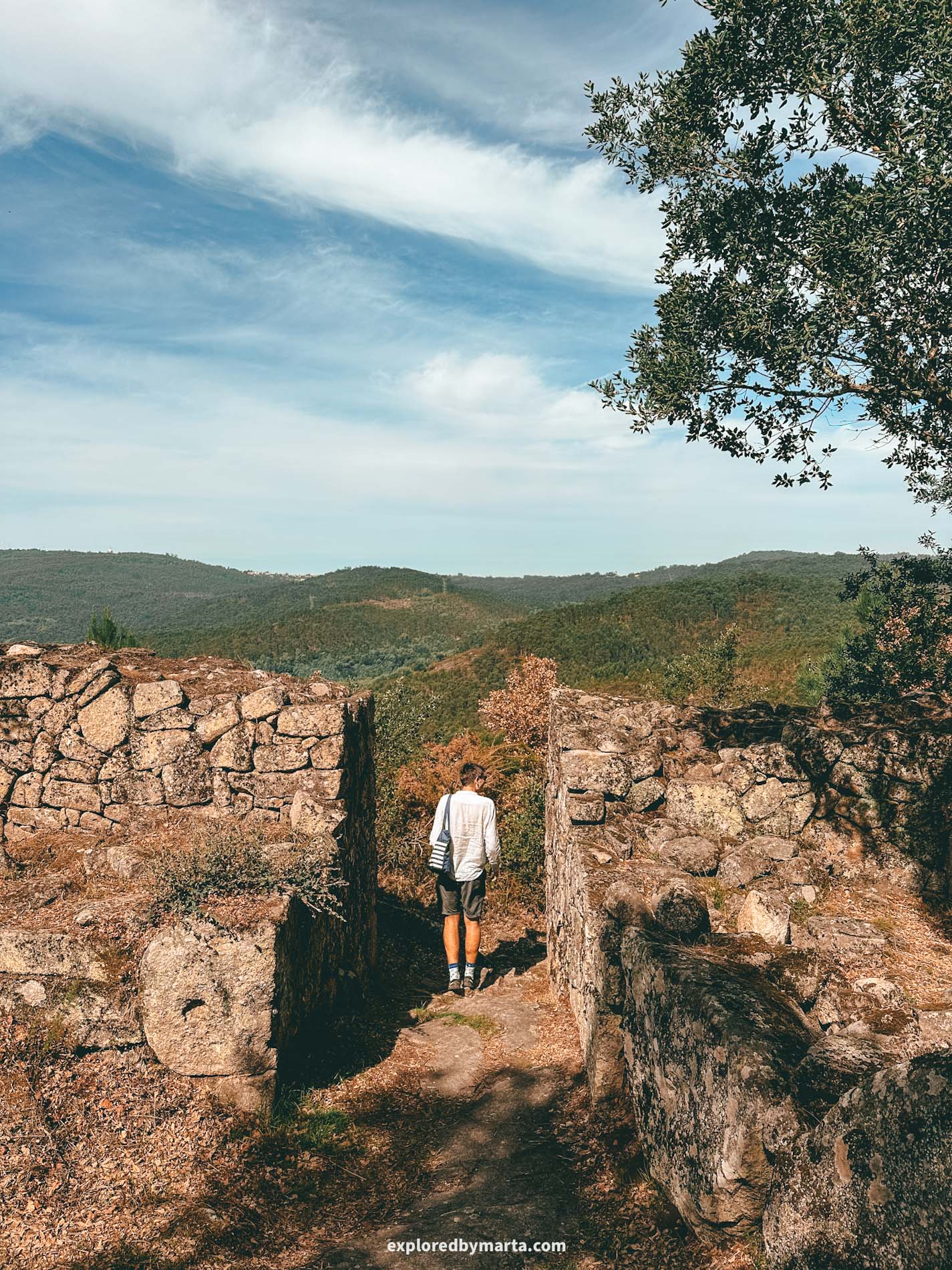
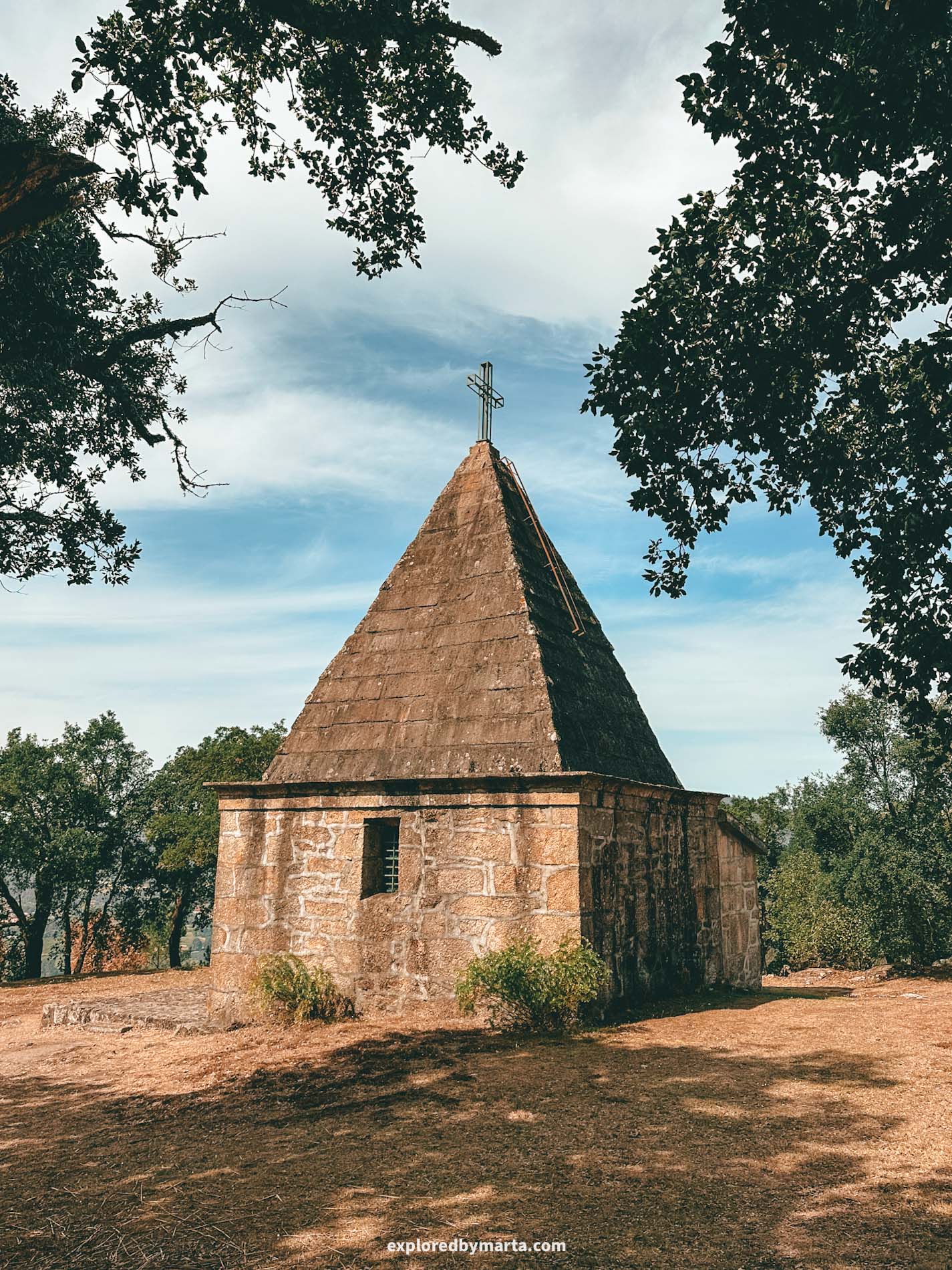
My favorite place was the ancient bathhouse right next to the road. It was decorated with beautiful carvings in stone (see picture above), but I also liked the beautiful views of the surrounding area we got from the hilltop.
Overall, it is quite a peaceful and quiet place. There were only a couple of tourists when we visited.
I don’t think this is a must-visit place for everyone, but those who appreciate archaeology and ancient ruins will love it! It only adds to the complex and rich history this country has!
There is a small entrance fee to visit Citânia de Briteiros, and we paid it in cash. They will give you a map of the territory and explain the best route to visit all the must-see spots.
Location: Citânia de Briteiros
20. Go on a day trip to the iconic Braga
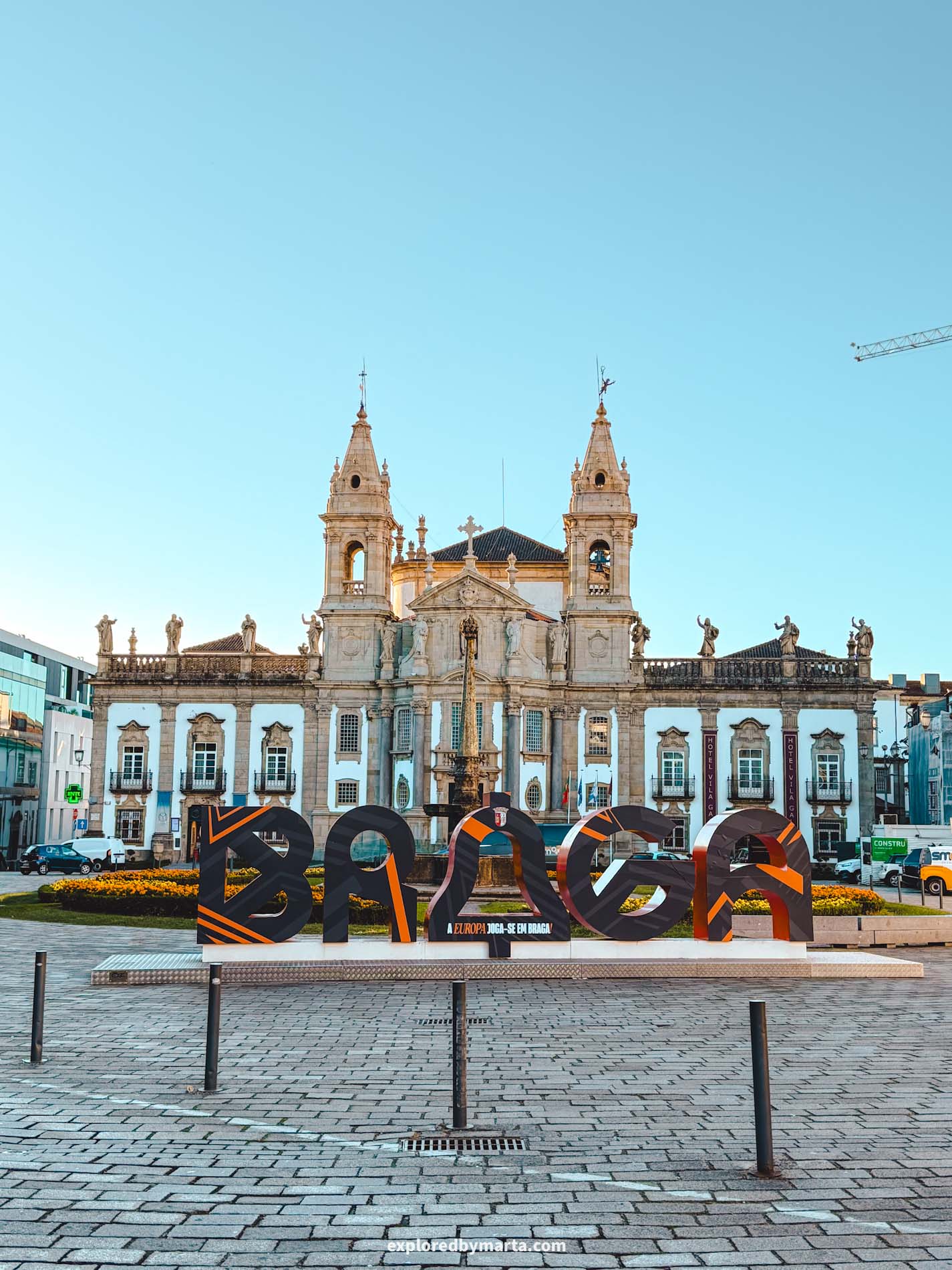
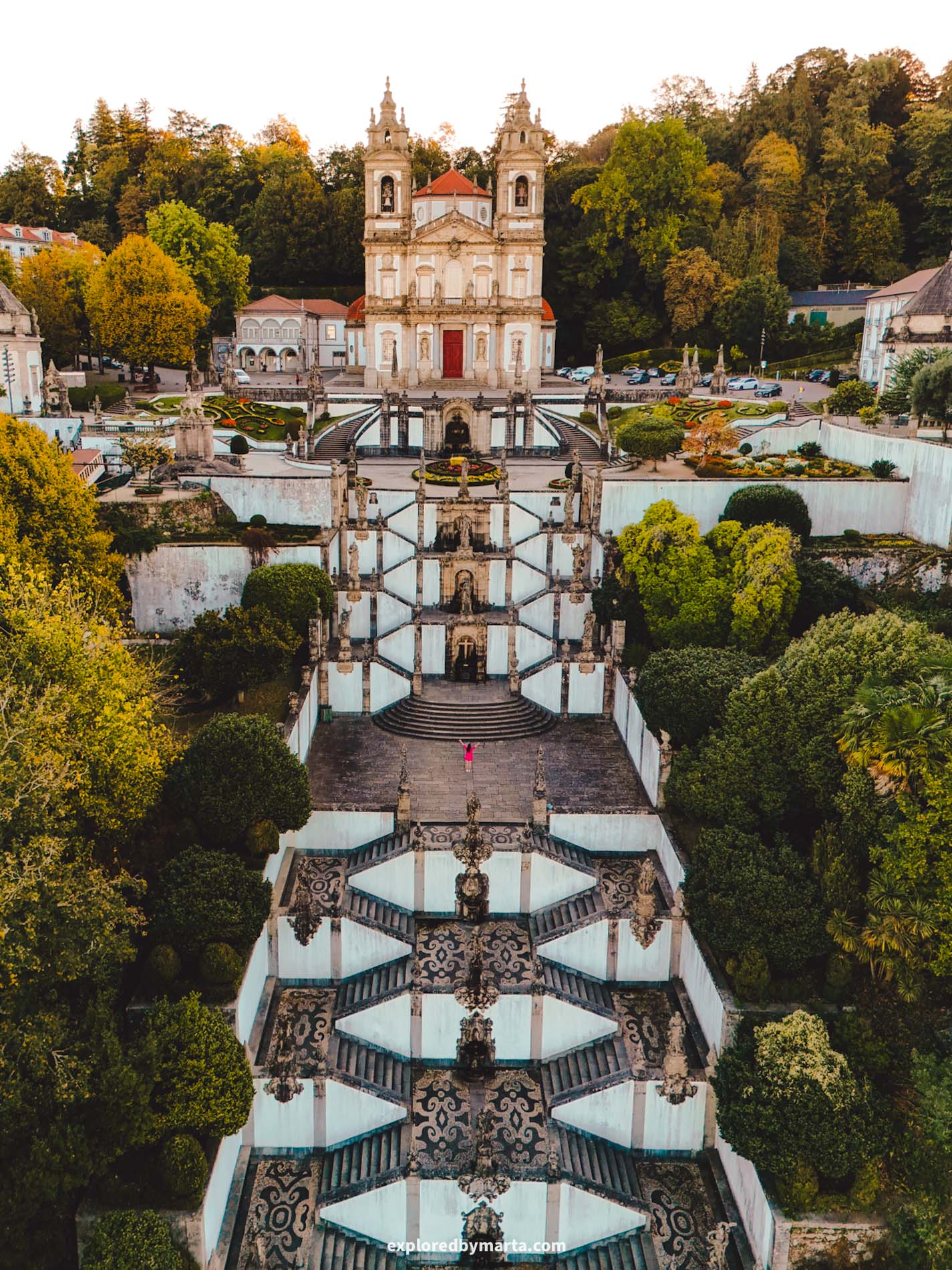
I don’t know what your plans are, but many travelers combine a visit to Guimarães with a visit to Braga. Some even do it in one day, which is not the best, but better than not visiting them at all.
So I’m just going to mention it here, so that you don’t forget to plan a visit to Braga, one of the most iconic cities in Portugal!
Braga is one of Portugal’s oldest and most beautiful cities, and it is located a mere 30-minute drive from Guimarães. You don’t have any excuses not to visit this iconic city.
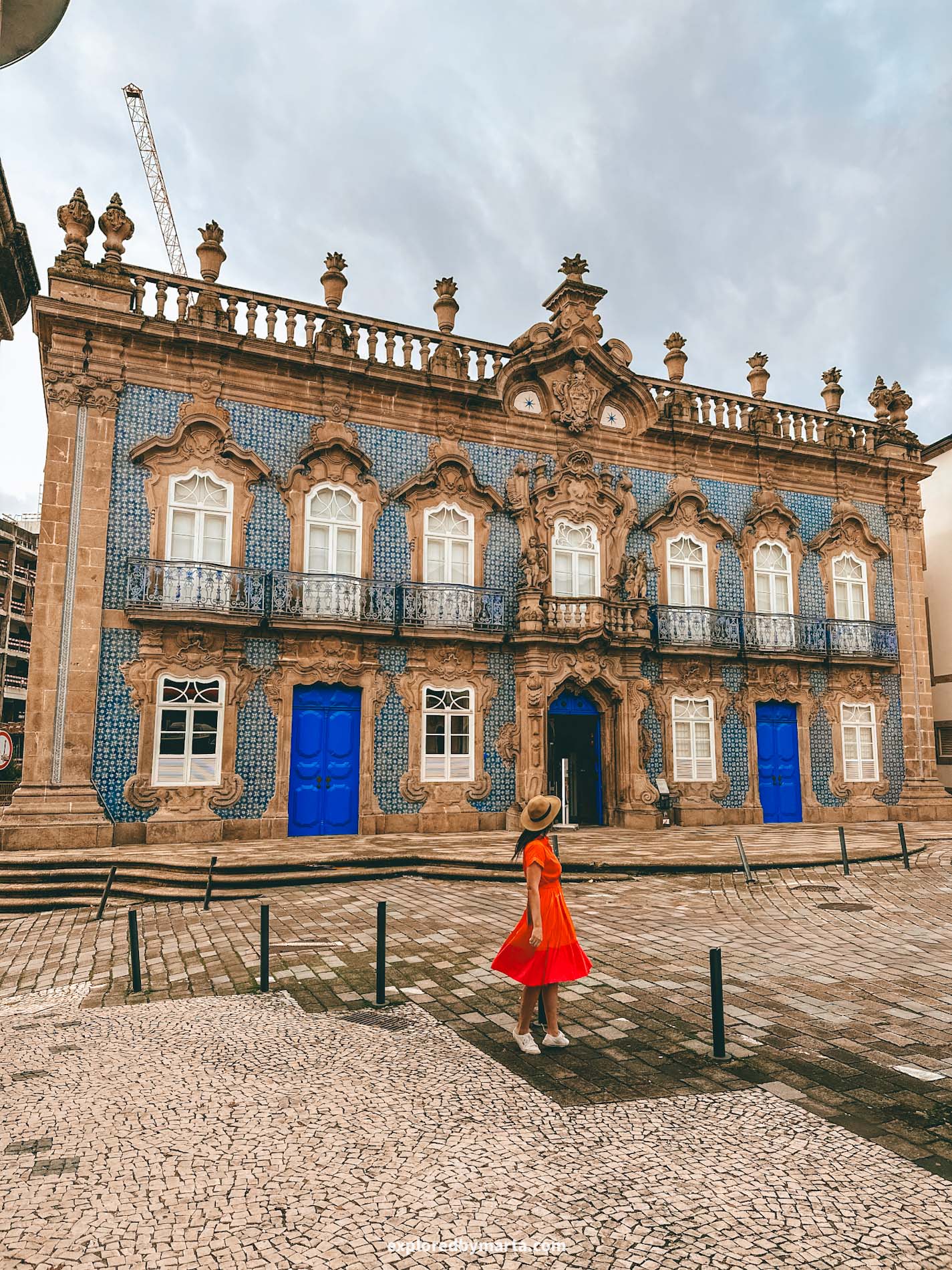
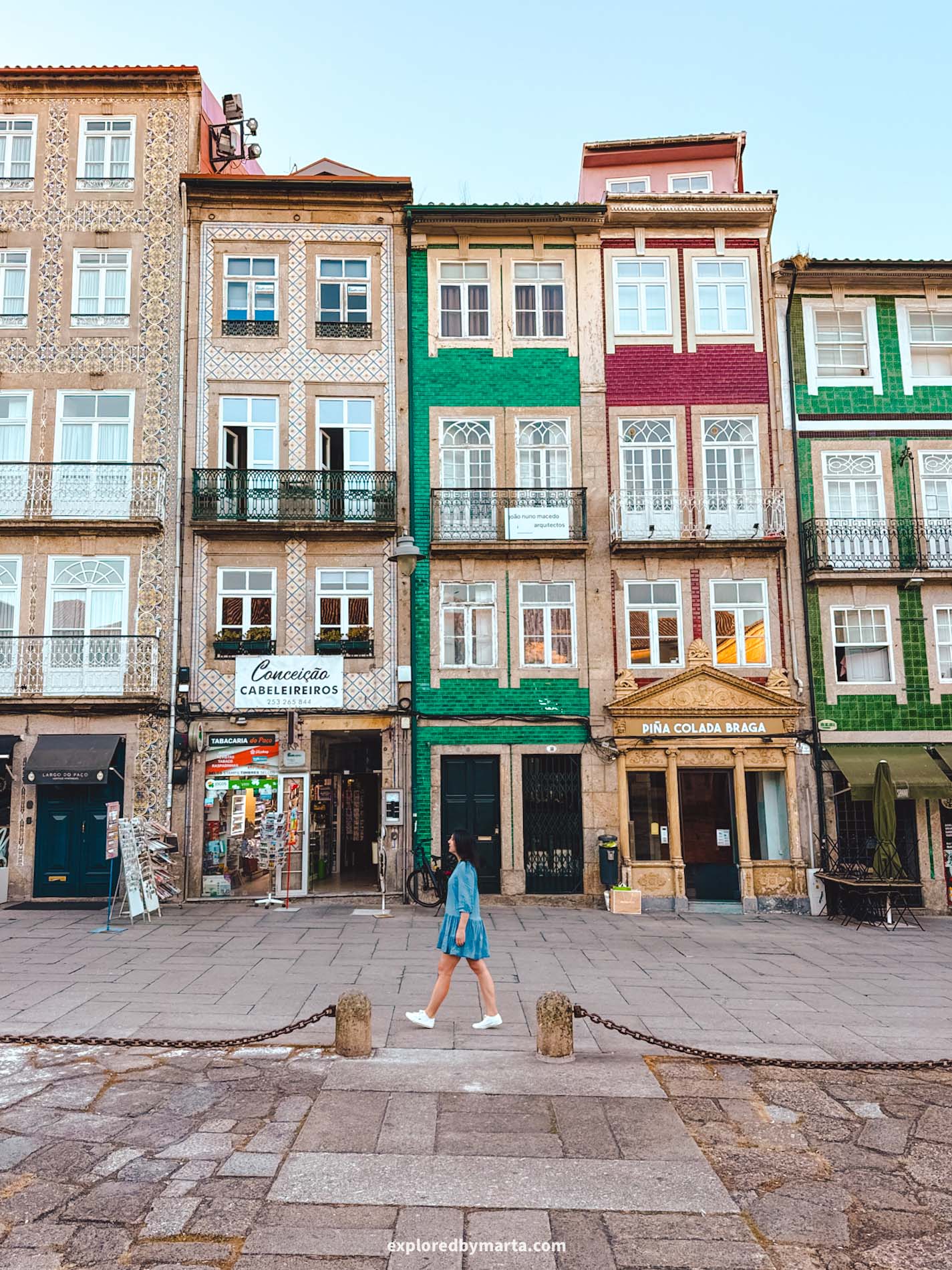
Braga is often called the Rome of Portugal because of its deep religious history and countless churches, but it also has a lively atmosphere, charming streets and cafés, and plenty of things to see and do.
Some of the top things to do in Braga include visiting the stunning Bom Jesus do Monte sanctuary, located just outside the city, with its iconic white Baroque staircase, as well as Braga Cathedral, which dates back to the 11th century and is the oldest cathedral in Portugal.
For foodies, I recommend trying such local delicacies as frigadeiras de Braga (local meat pies) and Pudim à Abade de Priscos, a dessert with a caramel taste.
Whether you come for a few hours or spend the whole day, visiting Braga is a perfect way to complement your trip to Guimarães and experience another side of Portugal’s historic Minho region.
Location: Braga
Happy exploring!
Guimarães, often called the birthplace of Portugal, is one of those cities that feels like stepping back in time. With its cobblestone streets, medieval architecture, and centuries-old churches, history truly lives and breathes in every corner.
We spent over a week exploring Guimarães and its surroundings, and what I loved most about Guimarães is how authentic it feels. It’s not just a place you visit for its monuments, but one you experience and feel to your bones through its architecture, atmosphere, and food.
If you’re planning a trip through northern Portugal, make sure to spend some time here. You’ll leave with a deeper appreciation for Portugal’s roots and a heart full of beautiful memories. I hope you enjoy Guimarães as much as we did!
PIN FOR LATER!
